Savannah J. Goins's Blog, page 2
June 20, 2018
The Loch Ness Monster: Fierce or Fictitious?
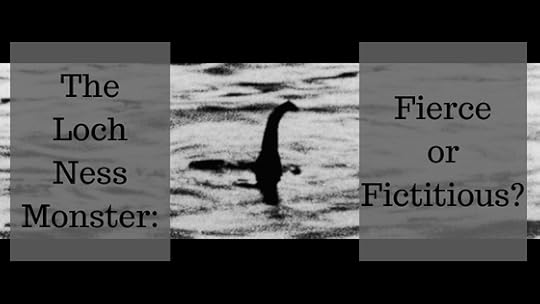 I couldn’t very well end a cryptozoology series without including a post on the famous Loch Ness Monster, now could I?This creature hardly needs an introduction. Perhaps one of the most well-known examples of cryptozoology, it’s popularity may only be rivaled with that of Bigfoot, the subject of my last post.Are you a believer?Reportedly, the first recorded sighting of the beast was in 565 AD, when St. Columba forced it back into the ocean after it ate a farmer.The next recorded sighting wasn’t until 1933, during extensive road construction near the Loch. It is believed that the noise and vibrations from the machinery may have awoken the beast and caused it to investigate.After that, there were several reported sightings of a mysterious creature in area, and it was just a year later that the famous photo of what looks like a slim head and neck of a prehistoric animal was taken by a surgeon from London, Dr. R. K. Wilson.
I couldn’t very well end a cryptozoology series without including a post on the famous Loch Ness Monster, now could I?This creature hardly needs an introduction. Perhaps one of the most well-known examples of cryptozoology, it’s popularity may only be rivaled with that of Bigfoot, the subject of my last post.Are you a believer?Reportedly, the first recorded sighting of the beast was in 565 AD, when St. Columba forced it back into the ocean after it ate a farmer.The next recorded sighting wasn’t until 1933, during extensive road construction near the Loch. It is believed that the noise and vibrations from the machinery may have awoken the beast and caused it to investigate.After that, there were several reported sightings of a mysterious creature in area, and it was just a year later that the famous photo of what looks like a slim head and neck of a prehistoric animal was taken by a surgeon from London, Dr. R. K. Wilson. Did you know there was a Loch Ness Investigation Bureau? Sounds pretty official. The organization was started in 1962 and performed a ten year study on the area, going so far as to send sonar and underwater photography equipment into the depths. The most they turned up was one possibly promising picture of a large flipper.
Did you know there was a Loch Ness Investigation Bureau? Sounds pretty official. The organization was started in 1962 and performed a ten year study on the area, going so far as to send sonar and underwater photography equipment into the depths. The most they turned up was one possibly promising picture of a large flipper. This was later shown to be likely something else that only resembled a flipper: a piece of plastic waste with a few folds in it.
This was later shown to be likely something else that only resembled a flipper: a piece of plastic waste with a few folds in it.  Interestingly, a new team of scientists are conducting a search of the DNA within Loch Ness, using a method that has been used to track the presence of invasive fish in the Great Lakes and an invasive frog species in France. They will publish their results in January 2019.What does this mean? Well, if there is a Loch Ness Monster, it will have DNA. Skin cells, mucous. Even if it is scaly, and even should it not shed it’s scales, there will be tissue cells released into the environment with its excrement. What would its DNA look like? Well, maybe like something we would expect, some DNA sample of prehistoric beasts we’ve collected. Or maybe it would be something we’ve yet to ever collect before, but similar to a lizard or a whale or some other kind of animal with which the monster may share common traits.People have used sonar imaging and drones and all kinds of things over the years with inconclusive evidence. Will this be the one test that finally turns up something promising?Even if it doesn’t turn up anything, it is still possible that something is out there that couldn’t be found. What if they don’t find any mysterious DNA? There is a lot of water in the area, it could be easy to miss something so small. On the other hand, if this creature has lived there so long and is so big, it should have a decent stock of DNA floating around in there.I can’t wait to see what they find out!In Recent MediaThere are about a million and ten movies about the Loch Ness Monster, but my favorite—at least of the ones I’ve seen—is The Water Horse. I was so jealous of the protagonist! It’s been years since I’ve seen it, but from what I remember, it’s a fantastic movie.Back to childhood again, there was this show called Happy Ness, full of animated, sentient, friendly Loch Ness Monsters. That was something else I really enjoyed as a kid. What about you? What’s the best movie/show you’ve seen featuring our old friend? Feel free to share in the comments!Creative CornerI'm all about monsters that end up befriending the protagonist. Things like dragons that end up being good friends and fellow fighters instead of just ravenous beasts to run away from. So what if there was a Nessie who befriended a human? That's totally been done before, but what kind of twist could you put on it to make it unique and new?Good luck!
Interestingly, a new team of scientists are conducting a search of the DNA within Loch Ness, using a method that has been used to track the presence of invasive fish in the Great Lakes and an invasive frog species in France. They will publish their results in January 2019.What does this mean? Well, if there is a Loch Ness Monster, it will have DNA. Skin cells, mucous. Even if it is scaly, and even should it not shed it’s scales, there will be tissue cells released into the environment with its excrement. What would its DNA look like? Well, maybe like something we would expect, some DNA sample of prehistoric beasts we’ve collected. Or maybe it would be something we’ve yet to ever collect before, but similar to a lizard or a whale or some other kind of animal with which the monster may share common traits.People have used sonar imaging and drones and all kinds of things over the years with inconclusive evidence. Will this be the one test that finally turns up something promising?Even if it doesn’t turn up anything, it is still possible that something is out there that couldn’t be found. What if they don’t find any mysterious DNA? There is a lot of water in the area, it could be easy to miss something so small. On the other hand, if this creature has lived there so long and is so big, it should have a decent stock of DNA floating around in there.I can’t wait to see what they find out!In Recent MediaThere are about a million and ten movies about the Loch Ness Monster, but my favorite—at least of the ones I’ve seen—is The Water Horse. I was so jealous of the protagonist! It’s been years since I’ve seen it, but from what I remember, it’s a fantastic movie.Back to childhood again, there was this show called Happy Ness, full of animated, sentient, friendly Loch Ness Monsters. That was something else I really enjoyed as a kid. What about you? What’s the best movie/show you’ve seen featuring our old friend? Feel free to share in the comments!Creative CornerI'm all about monsters that end up befriending the protagonist. Things like dragons that end up being good friends and fellow fighters instead of just ravenous beasts to run away from. So what if there was a Nessie who befriended a human? That's totally been done before, but what kind of twist could you put on it to make it unique and new?Good luck!
Published on June 20, 2018 03:36
June 5, 2018
Sasquatch: Hoax or Human?
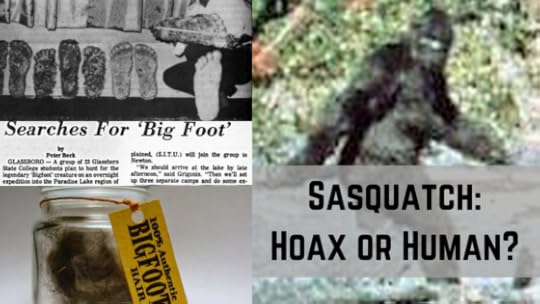 The name Sasquatch comes from the Salish word Sasq’ets, meaning “wild man” or “hairy man.” But despite being so huge and intimidating in appearance, the stories rarely indicate that these creatures have violent tendencies. Reports nearly always show that the Sasquatch didn’t want to be seen or cause any trouble. They weren’t out to eat humans. Or to steal their land. In fact, among some Native American tribes, Bigfoot is considered to be well-meaning messenger of warning. Someone who warns people about what they are doing wrong and what will happen if they don’t change their ways. So is the Sasquatch real, or just a big hoax that many have participated in for decades?
The name Sasquatch comes from the Salish word Sasq’ets, meaning “wild man” or “hairy man.” But despite being so huge and intimidating in appearance, the stories rarely indicate that these creatures have violent tendencies. Reports nearly always show that the Sasquatch didn’t want to be seen or cause any trouble. They weren’t out to eat humans. Or to steal their land. In fact, among some Native American tribes, Bigfoot is considered to be well-meaning messenger of warning. Someone who warns people about what they are doing wrong and what will happen if they don’t change their ways. So is the Sasquatch real, or just a big hoax that many have participated in for decades?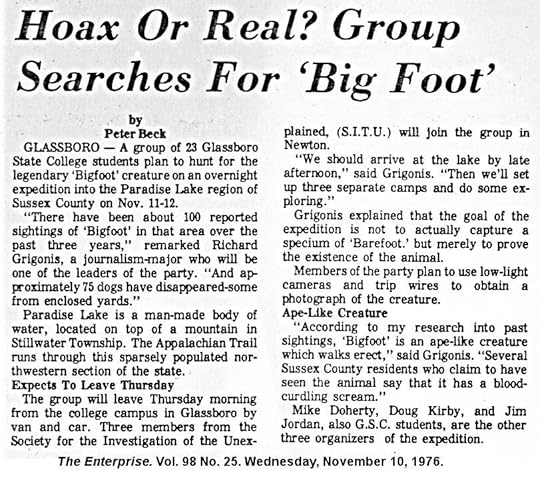 In a 2007 Baylor Religion Survey, 16% of Americans claimed they believe Bigfoot either is real or is probably real. 44% said probably not, and 40% said absolutely not. What do you believe?
In a 2007 Baylor Religion Survey, 16% of Americans claimed they believe Bigfoot either is real or is probably real. 44% said probably not, and 40% said absolutely not. What do you believe? 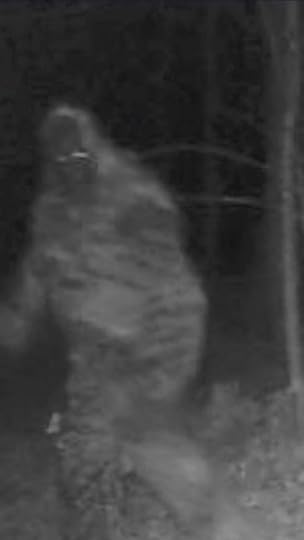 For centuries, rumors of larger-than-life humanoid foot prints and momentary glimpses of ape-men disappearing into the forest shadows have both horrified us and piqued our interest. Were the footprints real? Did that guy really see what he claimed? Is the shadow in that picture more than just a dude in a gorilla suit?Some of the most famous “evidence” accrued over time includes fuzzy pictures of hairy humanoids, photographs and plaster casts of giant footprints, and “Bigfoot hair” that was often found to be the hair of a bear or other forest-dwelling animal. There was even a short film captured by Roger Patterson and Bob Gimlin of what looked like a hairy humanoid running through the woods.
For centuries, rumors of larger-than-life humanoid foot prints and momentary glimpses of ape-men disappearing into the forest shadows have both horrified us and piqued our interest. Were the footprints real? Did that guy really see what he claimed? Is the shadow in that picture more than just a dude in a gorilla suit?Some of the most famous “evidence” accrued over time includes fuzzy pictures of hairy humanoids, photographs and plaster casts of giant footprints, and “Bigfoot hair” that was often found to be the hair of a bear or other forest-dwelling animal. There was even a short film captured by Roger Patterson and Bob Gimlin of what looked like a hairy humanoid running through the woods.  Has any actual proof ever been found? Sadly for cryptozoology nerds, no.The closest thing to proof of Sasquatch’s existence is the lack of solid proof against it. Most of those hair samples—and even some blood samples—turned out to belong to forest animals of whom the lab had a sample to compare the sample in question with. But sometimes, every once and a while, a bit of DNA would come back unidentified. Was that because it did belong to a mysterious humanoid creature? Or because the lab just happened not to have a sample of the animal it really came from?There are a lot of photos of Bigfoot. Many of them are hoaxes. But does that mean that every single one is fake? Not necessarily. But it does beg the question, why does photo evidence not surface more often and in better quality now that so many more people have better cameras on them at all times?Most of the photo evidence we have is from many decades ago, before cameras were as effective as they have come to be. But now, everyone has a smartphone with a good quality camera in their back pocket. And lots of people take their phones into the woods with them, so why hasn’t anyone gotten a really clear, convincing image yet? So say that people weren’t really seeing a Sasquatch, just for the sake of argument. What might they have seen then? Maybe a bear. Bears can stand up on two legs, and if seen from a great distance, as many Bigfoot accounts claim, perhaps a bear could be mistaken for a Sasquatch. Especially if there was some alcohol involved.
Has any actual proof ever been found? Sadly for cryptozoology nerds, no.The closest thing to proof of Sasquatch’s existence is the lack of solid proof against it. Most of those hair samples—and even some blood samples—turned out to belong to forest animals of whom the lab had a sample to compare the sample in question with. But sometimes, every once and a while, a bit of DNA would come back unidentified. Was that because it did belong to a mysterious humanoid creature? Or because the lab just happened not to have a sample of the animal it really came from?There are a lot of photos of Bigfoot. Many of them are hoaxes. But does that mean that every single one is fake? Not necessarily. But it does beg the question, why does photo evidence not surface more often and in better quality now that so many more people have better cameras on them at all times?Most of the photo evidence we have is from many decades ago, before cameras were as effective as they have come to be. But now, everyone has a smartphone with a good quality camera in their back pocket. And lots of people take their phones into the woods with them, so why hasn’t anyone gotten a really clear, convincing image yet? So say that people weren’t really seeing a Sasquatch, just for the sake of argument. What might they have seen then? Maybe a bear. Bears can stand up on two legs, and if seen from a great distance, as many Bigfoot accounts claim, perhaps a bear could be mistaken for a Sasquatch. Especially if there was some alcohol involved. 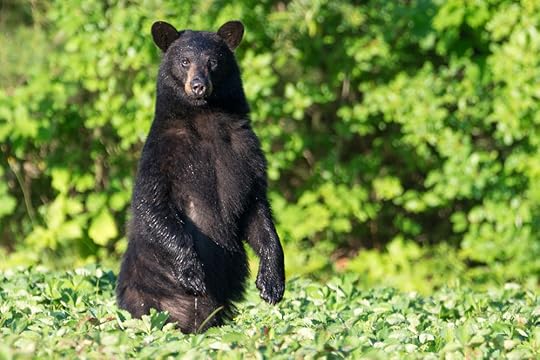 Or maybe a monkey. A gorilla or something similar. He could have escaped from the zoo, or the circus. Or some rich person’s private menagerie. Maybe.
Or maybe a monkey. A gorilla or something similar. He could have escaped from the zoo, or the circus. Or some rich person’s private menagerie. Maybe. 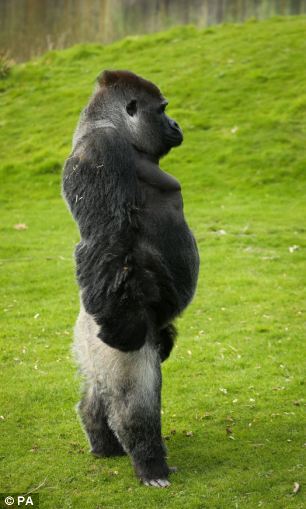 But think about other bear encounters, other wild ape encounters. Do either of these animals just run away any time they are seen? Sometimes, certainly. But always?The Sasquatch is said to be a fairly chill creature, not interested in attacking or eating humans. So could the Sasquatch really exist? Could there really be some number of near extinct ancient humanoids roaming the world? Probably not. But does that mean that Sasquatch hunters are crazy?I don’t think so.This brings to mind some of the things we went over in the Werewolf post.Remember the term hypertrichosis?That condition is characterized by excessive hair growth, sometimes all over the body. What if there were a few people hiding out in the woods during the prime Sasquatch-sighting decades that had hypertrichosis? Maybe.But the reports were usually of an abnormally large hairy man, not just an abnormally hairy man. Acromegaly is a condition of excessive growth, especially of the head, hands, and feet. This is caused by a non-cancerous tumor in the pituitary gland, which is responsible for excreting growth hormone. When the gland emits more growth hormone than it is supposed to, the person in question can grow indefinitely. This is what gave Andre the Giant his name.So what if someone had hypertrichosis and acromegaly at the same time? They would end up being abnormally large and unusually hairy, while still being completely human. So it would be possible to naturally appear this way without being a mythical, unexplainable being. So what if someone was born with both of these abnormalities? What if they were rejected by the tribe for being abnormal? What if they left or were kicked out at a very young age, before they had developed socially? Perhaps you would end up with a big hairy human who avoided people as much as possible, only stumbling upon them by accident. What if this combo of genetic abnormalities happened to a few different people? Maybe one man carried both genes and had several children, perhaps with different women? Or what if it was nothing like that, but there was something that several pregnant women were exposed to that caused the abnormality to develop in their unborn children? Radiation or a drug of some kind. Say that through some weird situation, a few large hairy humans came into existence. Say that they established a few families of their own, but were always very careful to avoid other humans lest they be treated badly because of their differences.Maybe the more outgoing ones took more risks, and their genes were then lost from the small gene pool. Perhaps only the cautious individuals survived to pass on their tendencies for caution as well as their excessive hair and size?This could explain why there have not been any better photos recently, even though there are better cameras. Perhaps there really are hairy people with big feet out there, but they are just as intelligent as we are and got really good at hiding.
But think about other bear encounters, other wild ape encounters. Do either of these animals just run away any time they are seen? Sometimes, certainly. But always?The Sasquatch is said to be a fairly chill creature, not interested in attacking or eating humans. So could the Sasquatch really exist? Could there really be some number of near extinct ancient humanoids roaming the world? Probably not. But does that mean that Sasquatch hunters are crazy?I don’t think so.This brings to mind some of the things we went over in the Werewolf post.Remember the term hypertrichosis?That condition is characterized by excessive hair growth, sometimes all over the body. What if there were a few people hiding out in the woods during the prime Sasquatch-sighting decades that had hypertrichosis? Maybe.But the reports were usually of an abnormally large hairy man, not just an abnormally hairy man. Acromegaly is a condition of excessive growth, especially of the head, hands, and feet. This is caused by a non-cancerous tumor in the pituitary gland, which is responsible for excreting growth hormone. When the gland emits more growth hormone than it is supposed to, the person in question can grow indefinitely. This is what gave Andre the Giant his name.So what if someone had hypertrichosis and acromegaly at the same time? They would end up being abnormally large and unusually hairy, while still being completely human. So it would be possible to naturally appear this way without being a mythical, unexplainable being. So what if someone was born with both of these abnormalities? What if they were rejected by the tribe for being abnormal? What if they left or were kicked out at a very young age, before they had developed socially? Perhaps you would end up with a big hairy human who avoided people as much as possible, only stumbling upon them by accident. What if this combo of genetic abnormalities happened to a few different people? Maybe one man carried both genes and had several children, perhaps with different women? Or what if it was nothing like that, but there was something that several pregnant women were exposed to that caused the abnormality to develop in their unborn children? Radiation or a drug of some kind. Say that through some weird situation, a few large hairy humans came into existence. Say that they established a few families of their own, but were always very careful to avoid other humans lest they be treated badly because of their differences.Maybe the more outgoing ones took more risks, and their genes were then lost from the small gene pool. Perhaps only the cautious individuals survived to pass on their tendencies for caution as well as their excessive hair and size?This could explain why there have not been any better photos recently, even though there are better cameras. Perhaps there really are hairy people with big feet out there, but they are just as intelligent as we are and got really good at hiding.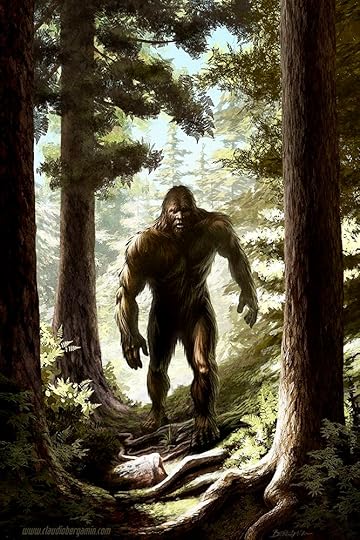 In Recent MediaIf you google Sasquatch, the first thing to pop up is a popular music festival. There are also a couple of novels and documentaries, but nothing really interesting that I can find.How about you? Do you know of any good books or movies about Bigfoot?Creative CornerWhat if the a couple kids with abnormal body hair and an abnormal growth rate were born, and rejected by society. They find their way by finding each other, and eventually fall for one another and start their own family. But all out of the public eye. Someone should write this story. These people could be such deep characters.Feel free to share your thoughts in the comments! Do you believe in Bigfoot? What do you think about the hypertrichosis and acromegaly theory?
In Recent MediaIf you google Sasquatch, the first thing to pop up is a popular music festival. There are also a couple of novels and documentaries, but nothing really interesting that I can find.How about you? Do you know of any good books or movies about Bigfoot?Creative CornerWhat if the a couple kids with abnormal body hair and an abnormal growth rate were born, and rejected by society. They find their way by finding each other, and eventually fall for one another and start their own family. But all out of the public eye. Someone should write this story. These people could be such deep characters.Feel free to share your thoughts in the comments! Do you believe in Bigfoot? What do you think about the hypertrichosis and acromegaly theory?
Published on June 05, 2018 02:00
May 16, 2018
Mermaids: Dugongs or Sirenomelia?
 You may be wondering what a dugong is. We’ll get to that, I promise.The first recorded half-fish-half-human creature was a Babylonian god from the 4th century BC called Oannes. He would leave the sea every day to teach mankind wisdom and then return to the water at night. He was one of the nicer versions of a mermaid.
You may be wondering what a dugong is. We’ll get to that, I promise.The first recorded half-fish-half-human creature was a Babylonian god from the 4th century BC called Oannes. He would leave the sea every day to teach mankind wisdom and then return to the water at night. He was one of the nicer versions of a mermaid.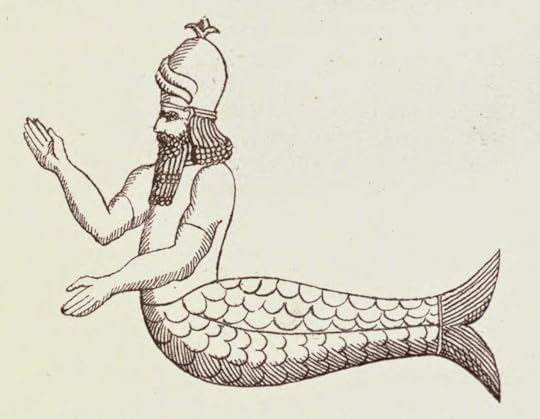 But perhaps the most famous type were the ancient Greek sirens, who lured sailors to their deaths in Homer’s Odyssey. Despite being commonly believed to be fish-tailed mermaids, they were originally described as having bird-like bodies. They used their beautiful song, like a magical bird’s, to tempt the men onto their island rather than into the sea to drown. But over time, they became so associated with the water that most words for “siren” in other languages actually translate to “mermaid.”
But perhaps the most famous type were the ancient Greek sirens, who lured sailors to their deaths in Homer’s Odyssey. Despite being commonly believed to be fish-tailed mermaids, they were originally described as having bird-like bodies. They used their beautiful song, like a magical bird’s, to tempt the men onto their island rather than into the sea to drown. But over time, they became so associated with the water that most words for “siren” in other languages actually translate to “mermaid.”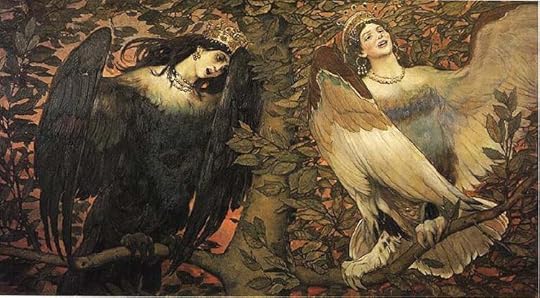 Ancient Greeks also believed in mermaids who sang beautiful songs, and were capable of controlling the weather. If you pissed them off, they could send storms and crashing waves and all such fun things your way.In more recent history, Christopher Columbus claimed to have seen a mermaid during his voyage in 1492. Historians believe this to actually be the first recorded sighting of a manatee in North America.Let’s take a look at a few other mermaid folklores from around the world.The Scottish have a mythical creature called a selkie. These creatures looked like seals, but had humanoid bodies underneath and were capable of shedding the seal skin to leave the water. But if the seal skin were to be stolen when the selkie wasn’t watching, she would be trapped on land until it could be found. Sometimes a land-locked selkie would end up marrying a human and having a family, only to throw it all away when she stumbled across her seal skin again and was called back to the sea.
Ancient Greeks also believed in mermaids who sang beautiful songs, and were capable of controlling the weather. If you pissed them off, they could send storms and crashing waves and all such fun things your way.In more recent history, Christopher Columbus claimed to have seen a mermaid during his voyage in 1492. Historians believe this to actually be the first recorded sighting of a manatee in North America.Let’s take a look at a few other mermaid folklores from around the world.The Scottish have a mythical creature called a selkie. These creatures looked like seals, but had humanoid bodies underneath and were capable of shedding the seal skin to leave the water. But if the seal skin were to be stolen when the selkie wasn’t watching, she would be trapped on land until it could be found. Sometimes a land-locked selkie would end up marrying a human and having a family, only to throw it all away when she stumbled across her seal skin again and was called back to the sea. The Mami Wata was an African mythical creature sometimes depicted as a mermaid and sometimes as a snake charmer. She could take on a human form, but could never become fully human. She was associated with healing, fertility and sex.
The Mami Wata was an African mythical creature sometimes depicted as a mermaid and sometimes as a snake charmer. She could take on a human form, but could never become fully human. She was associated with healing, fertility and sex.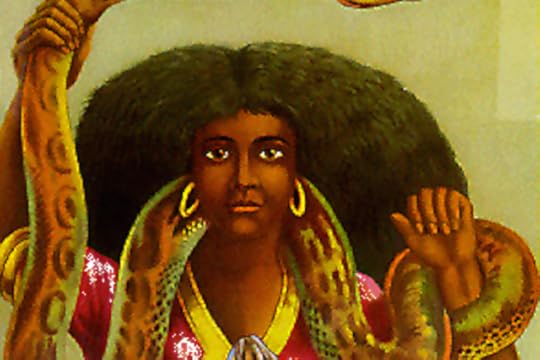 Iara of Brazil had a bad reputation for kidnapping adult men and trapping them in the sea to be her lovers. The legends tell of an immortal aquatic woman with green eyes and brown skin who could not be resisted. She was blamed for the loss of men on the Amazon river.The New Zealand myth, the Marakihau, was a powerful guardian of the sea blamed for destroying canoes and eating too much fish. This mercreature was believed to be a male, and perhaps the largest of all the mythical merpeople.The Merrow of Ireland were not truly aquatic, but each had a magical hat that allowed them to live under water (sorry, I couldn't find a good pic of the hat. Probably a trade secret). The females were beautiful, but because the males were so hideous and horribly cruel, the females were known to escape the sea and find a human man to have a family with. Sadly, despite the good lives they might build in such a way, they frequently grew tired of land and sought to return to the sea.
Iara of Brazil had a bad reputation for kidnapping adult men and trapping them in the sea to be her lovers. The legends tell of an immortal aquatic woman with green eyes and brown skin who could not be resisted. She was blamed for the loss of men on the Amazon river.The New Zealand myth, the Marakihau, was a powerful guardian of the sea blamed for destroying canoes and eating too much fish. This mercreature was believed to be a male, and perhaps the largest of all the mythical merpeople.The Merrow of Ireland were not truly aquatic, but each had a magical hat that allowed them to live under water (sorry, I couldn't find a good pic of the hat. Probably a trade secret). The females were beautiful, but because the males were so hideous and horribly cruel, the females were known to escape the sea and find a human man to have a family with. Sadly, despite the good lives they might build in such a way, they frequently grew tired of land and sought to return to the sea.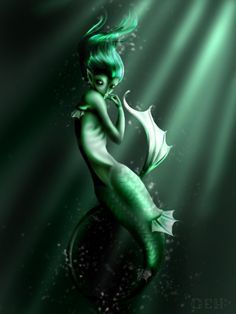
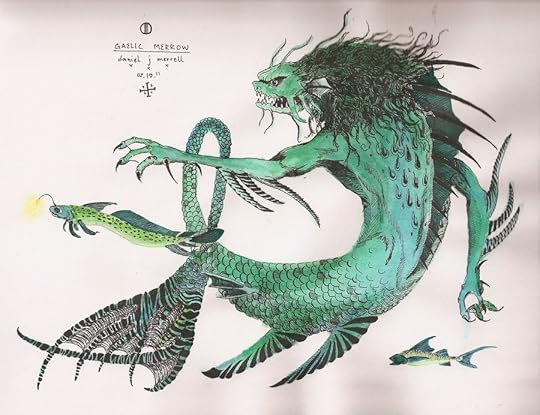 Norwegian Finfolk were shapeshifters. They lived under the sea when land was cold, but when it grew warm, they snuck onto land to steal silver. While the females were born beautiful mermaids, if they weren't capable of wooing a human man into having a family with them, they would grew old and haggard. In order to prevent losing their youthful loveliness, they would often become spies on the human realm for their Finfolk husbands, forced to acquire silver and send it back into the depths, lest their Finfolk husbands come on land to give them a beating for not bringing in enough. They occasionally kidnapped humans, but because of their fascination with silver, they could be distracted with a silver object potentially long enough for a human to make an escape.
Norwegian Finfolk were shapeshifters. They lived under the sea when land was cold, but when it grew warm, they snuck onto land to steal silver. While the females were born beautiful mermaids, if they weren't capable of wooing a human man into having a family with them, they would grew old and haggard. In order to prevent losing their youthful loveliness, they would often become spies on the human realm for their Finfolk husbands, forced to acquire silver and send it back into the depths, lest their Finfolk husbands come on land to give them a beating for not bringing in enough. They occasionally kidnapped humans, but because of their fascination with silver, they could be distracted with a silver object potentially long enough for a human to make an escape. 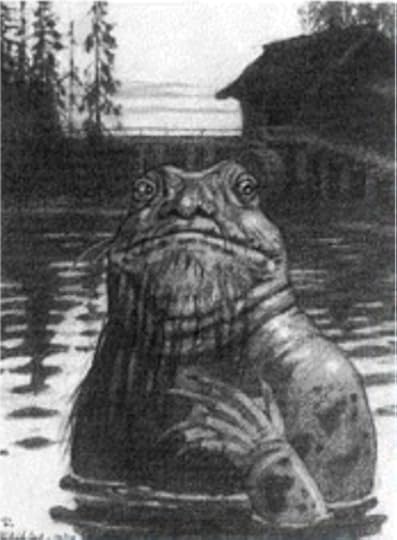 In summary, mermaids were, in nearly every culture, characters who lured humans to a watery death, snuck into the human realm or stole humans into their own realm. They were somewhat sexualized in most folklores, and they were basically inescapable. If you’d even be able to realize you wanted to escape them.There is something fairly consistent throughout about their magic: ominous, having to do with an almost mind-control-like quality where humans just get oogled into doing whatever they want. Plus some weather control thrown in for spice.
In summary, mermaids were, in nearly every culture, characters who lured humans to a watery death, snuck into the human realm or stole humans into their own realm. They were somewhat sexualized in most folklores, and they were basically inescapable. If you’d even be able to realize you wanted to escape them.There is something fairly consistent throughout about their magic: ominous, having to do with an almost mind-control-like quality where humans just get oogled into doing whatever they want. Plus some weather control thrown in for spice.  The creatures most commonly credited for the fabrication of the mermaidesque legends are the manatee and the dugong. These creatures are classified as “Sirenians,” amusingly based on their “similarity” of appearance to sirens. They both have front limbs, but no back limbs and barely even a pelvis. What they do have is a very strong tail. So were these creatures the ones that brought on the myths? Or was it something else?Take a look at these creatures.
The creatures most commonly credited for the fabrication of the mermaidesque legends are the manatee and the dugong. These creatures are classified as “Sirenians,” amusingly based on their “similarity” of appearance to sirens. They both have front limbs, but no back limbs and barely even a pelvis. What they do have is a very strong tail. So were these creatures the ones that brought on the myths? Or was it something else?Take a look at these creatures.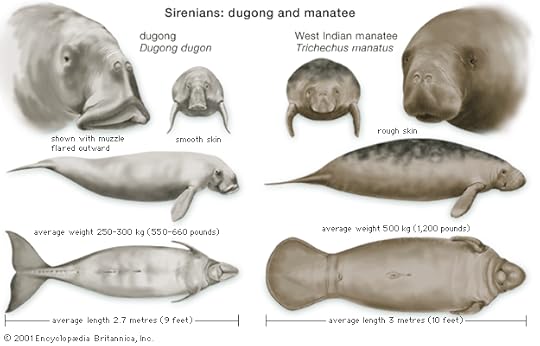 Remeber the strong sexual aspects of the majority of mermaid myths? Do these “sea cows” strike you as sexually inspiring?Perhaps a weary, hungry, lonely sailor viewing a manatee from a very great distance might manage to think he’s seeing a beautiful maiden swimming just out of reach. But could every sighting by so many cultures have been of something like one of those, and still resulted in the strong sexual associations?So could it have been something else? Something more humanoid that inspired many of the myths?What kind of deformities in a human could cause such misunderstandings? Perhaps the sight of a pair of abnormally fin-like feet disappearing with a kick under the waves could have inspired something mermaid-like in the mind of an observer? Syndactyly is a condition in which multiple fingers and/or toes are are united by extra skin, like webbing. Polydactyly is a condition of humans and animals in which an individual has an abnormally increased number of fingers or toes. What if someone had something like this
Remeber the strong sexual aspects of the majority of mermaid myths? Do these “sea cows” strike you as sexually inspiring?Perhaps a weary, hungry, lonely sailor viewing a manatee from a very great distance might manage to think he’s seeing a beautiful maiden swimming just out of reach. But could every sighting by so many cultures have been of something like one of those, and still resulted in the strong sexual associations?So could it have been something else? Something more humanoid that inspired many of the myths?What kind of deformities in a human could cause such misunderstandings? Perhaps the sight of a pair of abnormally fin-like feet disappearing with a kick under the waves could have inspired something mermaid-like in the mind of an observer? Syndactyly is a condition in which multiple fingers and/or toes are are united by extra skin, like webbing. Polydactyly is a condition of humans and animals in which an individual has an abnormally increased number of fingers or toes. What if someone had something like this 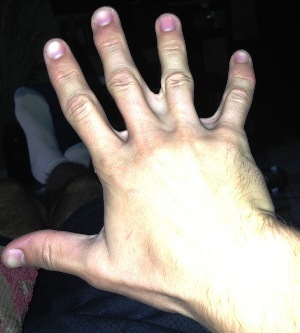
 Amelia is a condition in which an individual lacks one or more limbs. It is truly amazing how someone with this unusual trait can find a way to sufficiently function. Many individuals lacking one leg have still succeeded as athletes. Runners, gymnasts, and even swimmers. Perhaps having only one leg could still lead to incredible athletic grace?Sirenomelus individuals are people who were born with their legs fused together and their feet pointing abnormal directions. There have only been about 300 reported cases to date, making it one of the rarest deformities known to man.
Amelia is a condition in which an individual lacks one or more limbs. It is truly amazing how someone with this unusual trait can find a way to sufficiently function. Many individuals lacking one leg have still succeeded as athletes. Runners, gymnasts, and even swimmers. Perhaps having only one leg could still lead to incredible athletic grace?Sirenomelus individuals are people who were born with their legs fused together and their feet pointing abnormal directions. There have only been about 300 reported cases to date, making it one of the rarest deformities known to man. One case, Mili Cerron, was born with both legs fused together. Doctors were unable to tell her gender until three weeks after her birth through chromosomal testing. She needed surgery to separate her legs, but another child had recently died after undergoing the same surgery. Fortunately, hers went very well and she went on to have normal legs. Here she is walking on her first day of kindergarten.
One case, Mili Cerron, was born with both legs fused together. Doctors were unable to tell her gender until three weeks after her birth through chromosomal testing. She needed surgery to separate her legs, but another child had recently died after undergoing the same surgery. Fortunately, hers went very well and she went on to have normal legs. Here she is walking on her first day of kindergarten.  So what if a girl was born with sirenomelia, centuries before doctors could do anything about it, but learned to function with it? What if she spent a lot of time in the water avoiding the townspeople who treated her badly for looking different? Perhaps she learned to swim with dolphins and sea turtles, becoming more and more athletic as time went on. Perhaps, depending on how her legs were fused, being in the water would have been more comfortable and would have made standing easier. What if someone sailing by saw someone like that? What if there were other’s like her all around the world, ostracized for being born with webbed fingers, extra toes, one less leg than normal or even fused legs? What if the water was a great place to get away from rude people, and the people who saw things like this were the traveling sort who spread their stories as they went?Maybe this is allowing for way too much coincidence. It’s a lot to assume something like that could happen once, much less several times, and to be seen by the people who would talk about it and spread stories. But who knows? Someone like the friend of dolphins described above would be much more alluring than a dugong. Just saying.In any case, due to the vast number of different mermaid legends around the world, it must be assumed that different things aroused the different myths. Despite the many similarities, there were very likely many different things inspiring different stories.In Recent Media
So what if a girl was born with sirenomelia, centuries before doctors could do anything about it, but learned to function with it? What if she spent a lot of time in the water avoiding the townspeople who treated her badly for looking different? Perhaps she learned to swim with dolphins and sea turtles, becoming more and more athletic as time went on. Perhaps, depending on how her legs were fused, being in the water would have been more comfortable and would have made standing easier. What if someone sailing by saw someone like that? What if there were other’s like her all around the world, ostracized for being born with webbed fingers, extra toes, one less leg than normal or even fused legs? What if the water was a great place to get away from rude people, and the people who saw things like this were the traveling sort who spread their stories as they went?Maybe this is allowing for way too much coincidence. It’s a lot to assume something like that could happen once, much less several times, and to be seen by the people who would talk about it and spread stories. But who knows? Someone like the friend of dolphins described above would be much more alluring than a dugong. Just saying.In any case, due to the vast number of different mermaid legends around the world, it must be assumed that different things aroused the different myths. Despite the many similarities, there were very likely many different things inspiring different stories.In Recent Media With all the talk of "deformities," I think some credit is due to the people who find a way to overcome being born with something that most people aren't, and transcend the abilities of "normal" people. From watching The Fantasy Fiends Podcast, I've heard about a collection of short stories compiled by Andy Peloquin encompassing the topic. It's on my TBR, maybe it belongs on yours as well! Creative CornerThis could lead to a fantastic story about dealing with having a physical deformity. Someone could be born with sirenomelia, be ostracized their whole life, and then end up saving the world as a result. Someone with webbed appendages might be the fastest swimmer and the only person able to deliver military information to the forces on an island or a ship before the enemy strikes. A blind individual could hear better than anyone else, and know when danger is coming in time to warn everyone. A deaf person could sense vibrations in the ground and feel danger approaching, or maybe feel emotions or something like that.What do you think about mermaids? Tell me in the comments!
With all the talk of "deformities," I think some credit is due to the people who find a way to overcome being born with something that most people aren't, and transcend the abilities of "normal" people. From watching The Fantasy Fiends Podcast, I've heard about a collection of short stories compiled by Andy Peloquin encompassing the topic. It's on my TBR, maybe it belongs on yours as well! Creative CornerThis could lead to a fantastic story about dealing with having a physical deformity. Someone could be born with sirenomelia, be ostracized their whole life, and then end up saving the world as a result. Someone with webbed appendages might be the fastest swimmer and the only person able to deliver military information to the forces on an island or a ship before the enemy strikes. A blind individual could hear better than anyone else, and know when danger is coming in time to warn everyone. A deaf person could sense vibrations in the ground and feel danger approaching, or maybe feel emotions or something like that.What do you think about mermaids? Tell me in the comments!
Published on May 16, 2018 12:38
May 2, 2018
Dragons: Imagination or Instinct?
 Dragons have been an integral part of many cultures for longer than probably any of them can remember. What makes us humans so fascinated and terrified by these incredible beats? And were "dragons" merely dinosaurs whose stories were embellished with fire and horror? Could they have been inspired by something else? Do they exist in our stories because of our imaginations or an ancient instinct?First of all, we have to make sure we’re on the same page about what dragons I'm referring to here, because my go-to definition of a dragon may be different than yours. The focus of this post is what some have referred to as the European dragon. This is a giant lizard with four legs (not a wyvern) and a pair of large wings, usually capable of breathing fire. This dragon is pretty much always represented as a villain in old literature, and only in the last several decades has it been more commonly represented as a good character. (If the Chinese version of a dragon is more you’re type, you may be interested in this post comparing the European dragon and the Chinese dragon, as there is more history and description of them there.)
Dragons have been an integral part of many cultures for longer than probably any of them can remember. What makes us humans so fascinated and terrified by these incredible beats? And were "dragons" merely dinosaurs whose stories were embellished with fire and horror? Could they have been inspired by something else? Do they exist in our stories because of our imaginations or an ancient instinct?First of all, we have to make sure we’re on the same page about what dragons I'm referring to here, because my go-to definition of a dragon may be different than yours. The focus of this post is what some have referred to as the European dragon. This is a giant lizard with four legs (not a wyvern) and a pair of large wings, usually capable of breathing fire. This dragon is pretty much always represented as a villain in old literature, and only in the last several decades has it been more commonly represented as a good character. (If the Chinese version of a dragon is more you’re type, you may be interested in this post comparing the European dragon and the Chinese dragon, as there is more history and description of them there.)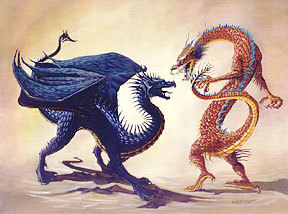 So the European dragon. Could it be a dinosaur with wings? Or an ancient instinct that’s been growing in us humans for generations?Let’s start with the dinosaur theory: Did the idea of dragons come from dinosaurs?We know there were some dinosaurs with wings: pterosaurs such as pterodactyls, pteranodons, etc. but nothing that really resembles our image of the Smaug-like animal.Perhaps the one that comes the closest to the European dragon ideal—at least size-wise—is Quetzalcoatlus northropi, the largest pterosaur ever found. It stood as tall as a giraffe and had a wingspan of thirty-six feet.But what about the fire breathing stuff? Where might that have come from if the idea of dragons came from dinosaurs?
So the European dragon. Could it be a dinosaur with wings? Or an ancient instinct that’s been growing in us humans for generations?Let’s start with the dinosaur theory: Did the idea of dragons come from dinosaurs?We know there were some dinosaurs with wings: pterosaurs such as pterodactyls, pteranodons, etc. but nothing that really resembles our image of the Smaug-like animal.Perhaps the one that comes the closest to the European dragon ideal—at least size-wise—is Quetzalcoatlus northropi, the largest pterosaur ever found. It stood as tall as a giraffe and had a wingspan of thirty-six feet.But what about the fire breathing stuff? Where might that have come from if the idea of dragons came from dinosaurs? One possibility is a certain ancient beast called Leviathan, a fearsome creature described in the Bible.
One possibility is a certain ancient beast called Leviathan, a fearsome creature described in the Bible.  There are several skeletons of different species of dinosaurs that may fit the description, particularly Sarcosuchus. I’ve written another post on that one, so I wont rehash it all, but the point here is that one of the particular types of skeletons that may fit the description of Leviathan, in fact, the one that is most likely to be the Leviathan, has a hollow place in the end of his nose.
There are several skeletons of different species of dinosaurs that may fit the description, particularly Sarcosuchus. I’ve written another post on that one, so I wont rehash it all, but the point here is that one of the particular types of skeletons that may fit the description of Leviathan, in fact, the one that is most likely to be the Leviathan, has a hollow place in the end of his nose.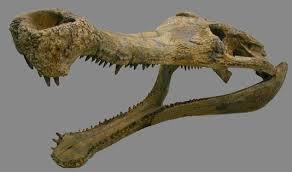 Why is a hollow bit of snoot important?Paleontologists speculate that this hollow place may have been used to mix chemicals that could result in something like fire. The bombardier beetle’s unique defense mechanism is a great example of this idea.
Why is a hollow bit of snoot important?Paleontologists speculate that this hollow place may have been used to mix chemicals that could result in something like fire. The bombardier beetle’s unique defense mechanism is a great example of this idea. 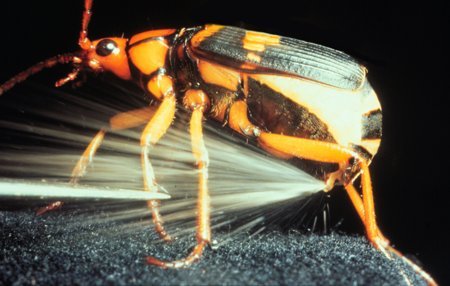 When startled, the beetle mixes two chemicals in its abdomen and shoots the combination out at a predator. The chemical mixture looks more like water than fire, but it comes out at boiling temperature at over twenty miles per hour. And the space in Leviathan’s nose is much bigger than the little space in the bombardier beetle’s bum.Likelihood? I'd like to think so.Here’s another interesting theory.One person who read my last post on dragons shared a book with me on the topic. The book was written by his uncle, David E. Jones, about a very interesting theory of the origin of the idea of dragons. The description sounded so intriguing that I bought a copy and read it in a couple of days. This was in the very early days of my blog before I had the Disqus comments feature, so unfortunately my whole conversation with the man who recommended the book to me was lost and I can’t remember his name.
When startled, the beetle mixes two chemicals in its abdomen and shoots the combination out at a predator. The chemical mixture looks more like water than fire, but it comes out at boiling temperature at over twenty miles per hour. And the space in Leviathan’s nose is much bigger than the little space in the bombardier beetle’s bum.Likelihood? I'd like to think so.Here’s another interesting theory.One person who read my last post on dragons shared a book with me on the topic. The book was written by his uncle, David E. Jones, about a very interesting theory of the origin of the idea of dragons. The description sounded so intriguing that I bought a copy and read it in a couple of days. This was in the very early days of my blog before I had the Disqus comments feature, so unfortunately my whole conversation with the man who recommended the book to me was lost and I can’t remember his name.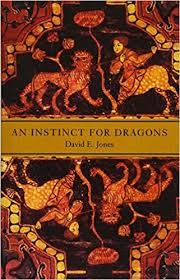 In his book, An Instinct for Dragons, Jones begins with the vervet monkey from Africa. These little creatures employ a very unique safety protocol amongst themselves. They have three main predators: pythons, eagles and panthers. And for each of these dangers, they have a distinct distress call. When a vervet notices one of those predators is near, it will sound the alarm and the rest of the group will join in as well.
In his book, An Instinct for Dragons, Jones begins with the vervet monkey from Africa. These little creatures employ a very unique safety protocol amongst themselves. They have three main predators: pythons, eagles and panthers. And for each of these dangers, they have a distinct distress call. When a vervet notices one of those predators is near, it will sound the alarm and the rest of the group will join in as well.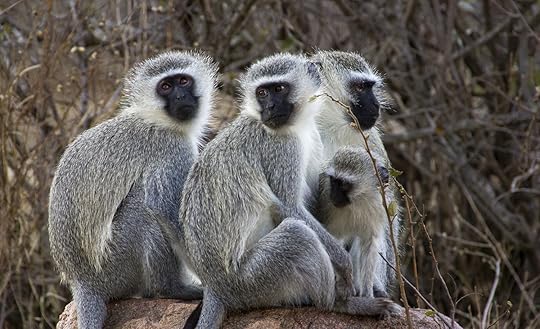 And based on which distinct call it is, they all know where to go. If it’s an alert for an eagle, they know to go further down in the trees where an eagle can’t fly to. If it’s an alarm for a panther or a python, they know to head for the highest branches where those heavier predators can’t reach.What does this have to do with dragons?If you take a look at a lot of ancient depictions of dragon like-creatures, you can see certain elements occurring consistently. Many have the back feet of a large cat, and the front feet of an eagle plus or minus wings. They also usually have a tail, and frequently a serpentine face. As I mention in that other post about Chinese dragons, if you look at one of those, it’s not based on a lizard at all, but a mix of several different animals, each representing some valued quality.So say that our interest in and fear of dragons isn’t based on dinosaurs, but on a prehistoric instinct to fear those three main predators? What if our minds blended all three of them into one terrifying monster?Jones proposes that as humans evolved from primates (which is not my personal belief) we evolved with the fear of those three main predators and as time went on, they became one thing in our minds and we fear them now because we feared the original predators when we were monkeys.I personally am a believer in creation, not evolution, but I am really intrigued by this idea. There are a lot of interesting things a writer could do with it in development of a world and the people in it.So what do you think? Did our fear and morbid curiosity about dragons come from dinosaurs imagined embellishments of dinosaurs, primordial instinct, or something else? Was there ever a real fire breathing dragon in our world? Feel free to share in the comments!In Recent MediaMy all-time favorite dragon series is the Inheritance Cycle by Christopher Paolini. Yes, his writing style in the first book has room for improvement. No, that does not reduce my love of this series. He wrote Eragon when he was fifteen! Let’s give him a break. It’s basically the best story ever.
And based on which distinct call it is, they all know where to go. If it’s an alert for an eagle, they know to go further down in the trees where an eagle can’t fly to. If it’s an alarm for a panther or a python, they know to head for the highest branches where those heavier predators can’t reach.What does this have to do with dragons?If you take a look at a lot of ancient depictions of dragon like-creatures, you can see certain elements occurring consistently. Many have the back feet of a large cat, and the front feet of an eagle plus or minus wings. They also usually have a tail, and frequently a serpentine face. As I mention in that other post about Chinese dragons, if you look at one of those, it’s not based on a lizard at all, but a mix of several different animals, each representing some valued quality.So say that our interest in and fear of dragons isn’t based on dinosaurs, but on a prehistoric instinct to fear those three main predators? What if our minds blended all three of them into one terrifying monster?Jones proposes that as humans evolved from primates (which is not my personal belief) we evolved with the fear of those three main predators and as time went on, they became one thing in our minds and we fear them now because we feared the original predators when we were monkeys.I personally am a believer in creation, not evolution, but I am really intrigued by this idea. There are a lot of interesting things a writer could do with it in development of a world and the people in it.So what do you think? Did our fear and morbid curiosity about dragons come from dinosaurs imagined embellishments of dinosaurs, primordial instinct, or something else? Was there ever a real fire breathing dragon in our world? Feel free to share in the comments!In Recent MediaMy all-time favorite dragon series is the Inheritance Cycle by Christopher Paolini. Yes, his writing style in the first book has room for improvement. No, that does not reduce my love of this series. He wrote Eragon when he was fifteen! Let’s give him a break. It’s basically the best story ever.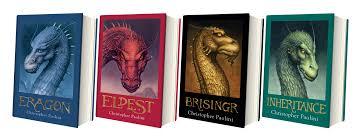 Ann McCaffery’s Dragon Riders of Pern series is excellent as well. I have to admit I haven’t read the whole series yet at this point, but I plan to and have thoroughly enjoyed the three I have read so far.
Ann McCaffery’s Dragon Riders of Pern series is excellent as well. I have to admit I haven’t read the whole series yet at this point, but I plan to and have thoroughly enjoyed the three I have read so far. A Natural History of Dragons, by Marie Brennan, has the best covers out of the three series mentioned here. The cover of the first book won me over because it’s just such a well-done blend of a fantastical dragon and the realistic-looking textbook anatomy illustration. Being in the veterinary field also could have affected my admiration of this cover.
A Natural History of Dragons, by Marie Brennan, has the best covers out of the three series mentioned here. The cover of the first book won me over because it’s just such a well-done blend of a fantastical dragon and the realistic-looking textbook anatomy illustration. Being in the veterinary field also could have affected my admiration of this cover.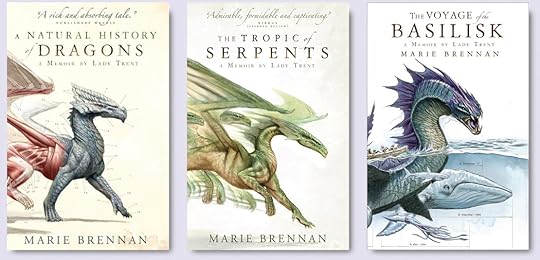 What dragon series is your favorite? Do you prefer dragons on the good side or the dark side, or both? Do you like sentient dragons? Or do you think they are better with just animal level intelligence?Creative CornerFor writers of dragony things (or really any type of things), what do you think of David E. Jones’s theory? Whether you agree or disagree with its validity, think of the things you could do with it in a story! There are tons of world building possibilities there. Maybe the protagonist is terrified of something that no one else recognizes as a threat, because she inherited some ancient primal awareness of that particular danger, and somehow she is the only one with such an ability. Should she listen to her gut and do something drastic, or follow the status quo and push down her instincts?Or what if the protagonist comes across a group of people who all have some kind of instinctive fear of him, because of some misunderstanding that happened between their two kinds a millennia ago? Perhaps he’ll need to give up his home in order to protect it and win the trust of these people before some major war breaks out, or perhaps he’ll need to escape their clutches in order to warn his own people that these other people are coming for them because of something that happened so long ago no one even knows.What other ideas could you come up with, whether about dragons or any other creatures? Feel free to share in the comments!
What dragon series is your favorite? Do you prefer dragons on the good side or the dark side, or both? Do you like sentient dragons? Or do you think they are better with just animal level intelligence?Creative CornerFor writers of dragony things (or really any type of things), what do you think of David E. Jones’s theory? Whether you agree or disagree with its validity, think of the things you could do with it in a story! There are tons of world building possibilities there. Maybe the protagonist is terrified of something that no one else recognizes as a threat, because she inherited some ancient primal awareness of that particular danger, and somehow she is the only one with such an ability. Should she listen to her gut and do something drastic, or follow the status quo and push down her instincts?Or what if the protagonist comes across a group of people who all have some kind of instinctive fear of him, because of some misunderstanding that happened between their two kinds a millennia ago? Perhaps he’ll need to give up his home in order to protect it and win the trust of these people before some major war breaks out, or perhaps he’ll need to escape their clutches in order to warn his own people that these other people are coming for them because of something that happened so long ago no one even knows.What other ideas could you come up with, whether about dragons or any other creatures? Feel free to share in the comments!
Published on May 02, 2018 12:34
April 17, 2018
Werewolves: Why Were-WOLVES?
Werewolf legends have been around for a lot longer than I thought. They appear in recorded history as far back as 2600 BC. Stories of werewolves and other similar creatures exists in cultures all over the world, from Norse mythology to Native American stories all the way to Argentinian myths as well. Many of the stories are horrifying, and they’re all really interesting.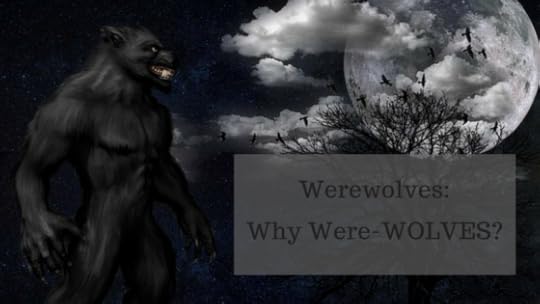 Many cultures view the wolf as evil or at least in a negative light. This is likely due to many people groups relying very heavily on agriculture, and wolves killing and eating your herds would make you lose money and threaten your survival and that of your loved ones. As a result, many myths and legends of evil wolves have sprung up over the centuries. Let’s take a look at some ancient stories about wolves from both a positive and negative point of view, and then we’ll get into the meat of the werewolf idea. “meat” lol. One of the most well-known wolf stories is that of Fenrir, the great wolf of Norse mythology.
Many cultures view the wolf as evil or at least in a negative light. This is likely due to many people groups relying very heavily on agriculture, and wolves killing and eating your herds would make you lose money and threaten your survival and that of your loved ones. As a result, many myths and legends of evil wolves have sprung up over the centuries. Let’s take a look at some ancient stories about wolves from both a positive and negative point of view, and then we’ll get into the meat of the werewolf idea. “meat” lol. One of the most well-known wolf stories is that of Fenrir, the great wolf of Norse mythology.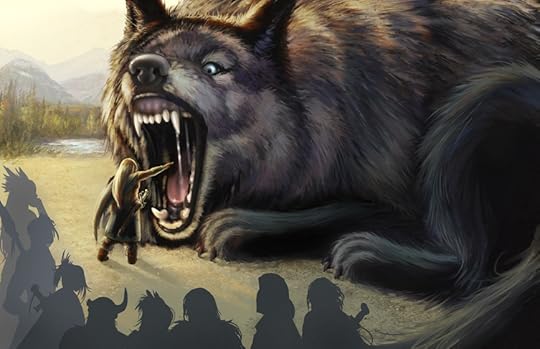 Fenrir was born the son of Loki and a giant, and while his terrible siblings Jormongandr and Hel could be sent away to other places to avoid their becoming problematic to the gods, Fenrir grew too fast. So the gods of Asgard decided they would have to bind him in order to protect themselves from him. Their first two attempts failed, and while the third was successful for much longer than the first two, it didn’t last forever. With the shaking of the rocks during Ragnarok, the stones that held his tether in place fell apart, releasing him. He was so big that he not only ate Odin, but swallowed the sun and moon as well.Not a very positive outlook on wolves at all.The name “Fenrir” means “he who dwells in the marshes.” Marshes are usually symbols of losing one’s way or being lost in the dark—even more negative connotation.The Wolf of Zhongshan is kind of a weird story from ancient China. An injured wolf was on the run from some hunters, and he met a scholar on the road and asked to hide in the his bookbag. The man agreed, and when the hunters reached them, pointed them in the wrong direction. Once they were far away, the wolf emerged, but instead of thanking the man for saving his life, he informed the man he wanted to eat him. The scholar convinced the wolf to wait until they could consult with three other individuals to hear their ruling on the subject.They asked an aprticot tree and an Ox, both of whom took the wolf’s side because they were prejudiced against humans due to negative treatment by their masters. But they came across a man on the road and he asked the wolf to prove that he could actually fit in the bookbag. The wolf obliged, and the man quickly tied him in and advised the scholar to kill him while he was restrained in order to save his own life.I think the moral of the story is not to be ungrateful for help. Interestingly, wolves have frequently been used in many stories to teach a lesson, especially to warn children away from behaving badly or getting into a dangerous situation.In Little Red Riding Hood, a story with countless different versions, the big bad wolf is a sneaky character that connived and tricked the grandmother and the granddaughter into a situation in which he could eat them. Many versions of the tale are cautionary against children disobeying their parents by doing things such as wandering off the path or letting strangers into the house.
Fenrir was born the son of Loki and a giant, and while his terrible siblings Jormongandr and Hel could be sent away to other places to avoid their becoming problematic to the gods, Fenrir grew too fast. So the gods of Asgard decided they would have to bind him in order to protect themselves from him. Their first two attempts failed, and while the third was successful for much longer than the first two, it didn’t last forever. With the shaking of the rocks during Ragnarok, the stones that held his tether in place fell apart, releasing him. He was so big that he not only ate Odin, but swallowed the sun and moon as well.Not a very positive outlook on wolves at all.The name “Fenrir” means “he who dwells in the marshes.” Marshes are usually symbols of losing one’s way or being lost in the dark—even more negative connotation.The Wolf of Zhongshan is kind of a weird story from ancient China. An injured wolf was on the run from some hunters, and he met a scholar on the road and asked to hide in the his bookbag. The man agreed, and when the hunters reached them, pointed them in the wrong direction. Once they were far away, the wolf emerged, but instead of thanking the man for saving his life, he informed the man he wanted to eat him. The scholar convinced the wolf to wait until they could consult with three other individuals to hear their ruling on the subject.They asked an aprticot tree and an Ox, both of whom took the wolf’s side because they were prejudiced against humans due to negative treatment by their masters. But they came across a man on the road and he asked the wolf to prove that he could actually fit in the bookbag. The wolf obliged, and the man quickly tied him in and advised the scholar to kill him while he was restrained in order to save his own life.I think the moral of the story is not to be ungrateful for help. Interestingly, wolves have frequently been used in many stories to teach a lesson, especially to warn children away from behaving badly or getting into a dangerous situation.In Little Red Riding Hood, a story with countless different versions, the big bad wolf is a sneaky character that connived and tricked the grandmother and the granddaughter into a situation in which he could eat them. Many versions of the tale are cautionary against children disobeying their parents by doing things such as wandering off the path or letting strangers into the house.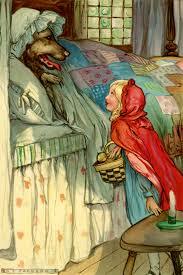 Another story with associations to the Brother’s Grimm is that of the Three Little Pigs.In this story, a mother pig sends her three sons out into the world to seek their fortunes. One builds his house of straw, and a wolf comes along and destroys the house and eats him. Same for the second pig, who built his house of sticks.
Another story with associations to the Brother’s Grimm is that of the Three Little Pigs.In this story, a mother pig sends her three sons out into the world to seek their fortunes. One builds his house of straw, and a wolf comes along and destroys the house and eats him. Same for the second pig, who built his house of sticks. 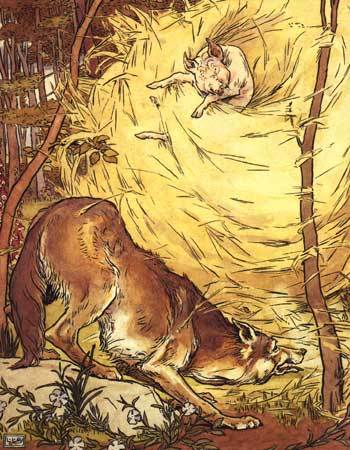 But the third pig built his house of bricks, a feat that took more time and expense, but paid off in the end. The wolf couldn’t break down the house or trick the pig into coming out. When he tried sneaking in through the chimney, the third pig caught the wolf in a pot of boiling water and ate him.
But the third pig built his house of bricks, a feat that took more time and expense, but paid off in the end. The wolf couldn’t break down the house or trick the pig into coming out. When he tried sneaking in through the chimney, the third pig caught the wolf in a pot of boiling water and ate him.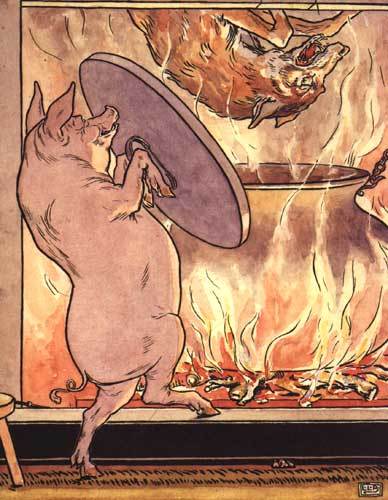 Another tale to warn children not to open the door to strangers, perhaps as well to teach them to build things to last and provide real protection.Despite all the negative characteristics associated with wolves, some cultures saw them in a more positive light. It is likely that cultures who relied more heavily on hunting than breeding their own livestock admired the wolf’s hunting prowess and thought highly of the creatures as a result.In nearly all Native American cultures, the wolf is associated with medicine, courage, successful hunting skills and loyalty.
Another tale to warn children not to open the door to strangers, perhaps as well to teach them to build things to last and provide real protection.Despite all the negative characteristics associated with wolves, some cultures saw them in a more positive light. It is likely that cultures who relied more heavily on hunting than breeding their own livestock admired the wolf’s hunting prowess and thought highly of the creatures as a result.In nearly all Native American cultures, the wolf is associated with medicine, courage, successful hunting skills and loyalty.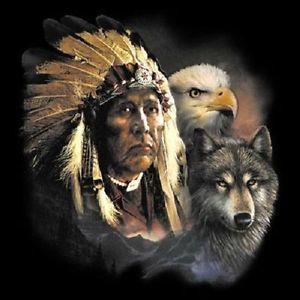 Chibiabos, for example, is a great wolf-spirit in Algonquin mythology. His name means “ghost rabbit” but he was a wolf spirit, usually in the physical form of a wolf. When he was unjustly murdered by water spirits, he became the ruler of the land of the dead and was considered a kind and fair ruler.Did you know that Sirius Black is actually named after a star? Which happens to be the brightest star in the sky, and the dominant star in the Canis Major constellation? This, in fact, was all news to me. Am I the only person who didn’t know that “Sirius” is the name of the brightest star in the Great Dog constellation? I’m feeling a bit behind the times!
Chibiabos, for example, is a great wolf-spirit in Algonquin mythology. His name means “ghost rabbit” but he was a wolf spirit, usually in the physical form of a wolf. When he was unjustly murdered by water spirits, he became the ruler of the land of the dead and was considered a kind and fair ruler.Did you know that Sirius Black is actually named after a star? Which happens to be the brightest star in the sky, and the dominant star in the Canis Major constellation? This, in fact, was all news to me. Am I the only person who didn’t know that “Sirius” is the name of the brightest star in the Great Dog constellation? I’m feeling a bit behind the times! Anyway, Sirius is also the white direction star, and the Pawnee people, who valued wolves most highly, called the Milky Way the Wolf Road. They believed that the Milky Way was a spirit road walked by the dead. They were also one of the few tribes to pay more attention to the stars rather than the sun and moon.Going back a little further, another example of a wolf seen in a positive light is the wolf who partially raised Romulus and Remus. Legend has it that their mother was forbidden to have children lest she birth rivals to the throne, but she had two children fathered by the war god, Mars, anyway.
Anyway, Sirius is also the white direction star, and the Pawnee people, who valued wolves most highly, called the Milky Way the Wolf Road. They believed that the Milky Way was a spirit road walked by the dead. They were also one of the few tribes to pay more attention to the stars rather than the sun and moon.Going back a little further, another example of a wolf seen in a positive light is the wolf who partially raised Romulus and Remus. Legend has it that their mother was forbidden to have children lest she birth rivals to the throne, but she had two children fathered by the war god, Mars, anyway. 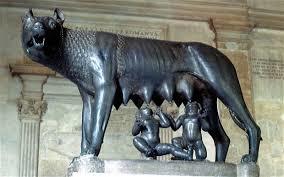 They were sentenced to be drowned, but instead of sinking, the basket they were laid in floated down the river and was found by a wolf and a woodpecker. They worked together to feed the children until they were found by a shepherd who raised them from then on.So we’ve seen wolves in both a negative and positive light in different cultures, now onto the werewolf legends, and what—if any—truth we can filter out of them.Possibly the very earliest recorded story of a human being turned into a wolf comes from the Epic of Gilgamesh, which supposedly took place around 2600 BC. In this particular story, a goddess was in love with the hero, Gilgamesh, and tried to flirt with him. But he rejected her advances because of how she treated other suitors.One such man was a shepherd who left her many gifts on a shrine on a beautiful mountainside. At first she lead him on and encouraged him, but then she grew bored of his attentions and turned him into a wolf, and his own hounds tore him apart.An ancient Greek myth speaks of Zeus turning Lyceaon into a werewolf. The story goes that Lyceaon threw a party and wanted to be sure that Zeus was really who he claimed to be. So he had a man killed and his flesh served to Zeus, in order to see if he was god enough to notice. Well, he was. And he was quite offended. So because of Lyceaon’s wolf-like actions of killing a man and proposing that his flesh be eaten, he turned him into a werewolf. And it is from the name “Lyceaon” that we get the name “lycanthrope.”Perhaps the next oldest story, going all the way back to 39BC, is recorded by Virgil in his Alphesiboeus. He wrote that a man named Moeris could turn himself into a wolf using herbs and poisons.“These herbs, these poisons, that were culled in Pontus, it was Moeris Himself that gave them me. Such herbs are common weeds in Pontus. Oft by their sorcery I have seen Moeris turn wolf and hide Within the woods, oft call forth spirits from their deep-dug graves, And charm away to other fields whole harvests of sown corn.”In this case, the man could turn himself into a wolf, rather than being forced to turn into a wolf by someone else.A Native American example of a possible werewolf comes from Guarani mythology. When an evil spirit named Tao took on a human form in order to marry a beautiful woman, Kerana, he incurred the wrath of the high goddess Arasy, who cursed the seven sons they produced. Each one had a different monstrous form and some were used as scary stories to make children nap during their siestas, lest they be lured by one of the monsters, and as an excuse for adulterous women who mysteriously became pregnant.The last of the seven sons was named Luison, and he had the appearance of a sick wolf-like creature. He was half human, half wolf, not necessarily something that transformed between the two. He smelled like death and decay and hung around graveyards. To be touched by the Lusion was a sign of impending death. As a result, it is considered unlucky to be the seventh son, and some believe that all seventh sons become werewolve-like creatures.
They were sentenced to be drowned, but instead of sinking, the basket they were laid in floated down the river and was found by a wolf and a woodpecker. They worked together to feed the children until they were found by a shepherd who raised them from then on.So we’ve seen wolves in both a negative and positive light in different cultures, now onto the werewolf legends, and what—if any—truth we can filter out of them.Possibly the very earliest recorded story of a human being turned into a wolf comes from the Epic of Gilgamesh, which supposedly took place around 2600 BC. In this particular story, a goddess was in love with the hero, Gilgamesh, and tried to flirt with him. But he rejected her advances because of how she treated other suitors.One such man was a shepherd who left her many gifts on a shrine on a beautiful mountainside. At first she lead him on and encouraged him, but then she grew bored of his attentions and turned him into a wolf, and his own hounds tore him apart.An ancient Greek myth speaks of Zeus turning Lyceaon into a werewolf. The story goes that Lyceaon threw a party and wanted to be sure that Zeus was really who he claimed to be. So he had a man killed and his flesh served to Zeus, in order to see if he was god enough to notice. Well, he was. And he was quite offended. So because of Lyceaon’s wolf-like actions of killing a man and proposing that his flesh be eaten, he turned him into a werewolf. And it is from the name “Lyceaon” that we get the name “lycanthrope.”Perhaps the next oldest story, going all the way back to 39BC, is recorded by Virgil in his Alphesiboeus. He wrote that a man named Moeris could turn himself into a wolf using herbs and poisons.“These herbs, these poisons, that were culled in Pontus, it was Moeris Himself that gave them me. Such herbs are common weeds in Pontus. Oft by their sorcery I have seen Moeris turn wolf and hide Within the woods, oft call forth spirits from their deep-dug graves, And charm away to other fields whole harvests of sown corn.”In this case, the man could turn himself into a wolf, rather than being forced to turn into a wolf by someone else.A Native American example of a possible werewolf comes from Guarani mythology. When an evil spirit named Tao took on a human form in order to marry a beautiful woman, Kerana, he incurred the wrath of the high goddess Arasy, who cursed the seven sons they produced. Each one had a different monstrous form and some were used as scary stories to make children nap during their siestas, lest they be lured by one of the monsters, and as an excuse for adulterous women who mysteriously became pregnant.The last of the seven sons was named Luison, and he had the appearance of a sick wolf-like creature. He was half human, half wolf, not necessarily something that transformed between the two. He smelled like death and decay and hung around graveyards. To be touched by the Lusion was a sign of impending death. As a result, it is considered unlucky to be the seventh son, and some believe that all seventh sons become werewolve-like creatures.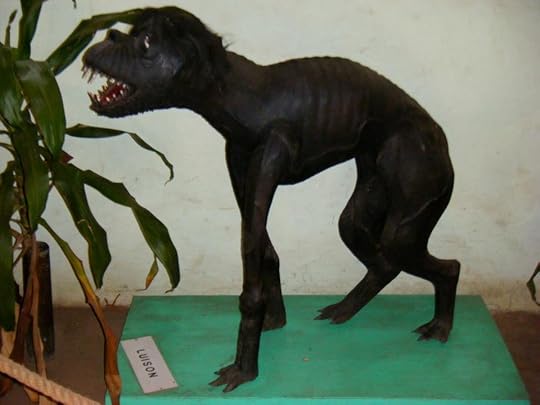 Another more recent werewolf incident was that of Peter Stubbe, a serial killer. Throughout the sixteenth century, Stubbe was accused of being a werewolf, practicing witchcraft, and giving into his cannibalistic tendencies. When he was caught, he claimed that the devil himself gave him a belt of wolf fur that would transform him into a werewolf when he wore it. The horrible crimes he committed, including the murder of many women and children and livestock, were likely the result of a mental disorder rather than an ability to change form.Instead of considering how one might go back and forth from human to wolf, let’s take a look at what might look like a wolf-man if seen in the dark.Hypertrichosis, an overgrowth of hair all over the body, has been referred to as “werewolf syndrome” for decades. Excessive amounts of hair may or may not be present at birth, but a significant amount of hair in unwanted places such as the face can continue to grow throughout life.
Another more recent werewolf incident was that of Peter Stubbe, a serial killer. Throughout the sixteenth century, Stubbe was accused of being a werewolf, practicing witchcraft, and giving into his cannibalistic tendencies. When he was caught, he claimed that the devil himself gave him a belt of wolf fur that would transform him into a werewolf when he wore it. The horrible crimes he committed, including the murder of many women and children and livestock, were likely the result of a mental disorder rather than an ability to change form.Instead of considering how one might go back and forth from human to wolf, let’s take a look at what might look like a wolf-man if seen in the dark.Hypertrichosis, an overgrowth of hair all over the body, has been referred to as “werewolf syndrome” for decades. Excessive amounts of hair may or may not be present at birth, but a significant amount of hair in unwanted places such as the face can continue to grow throughout life.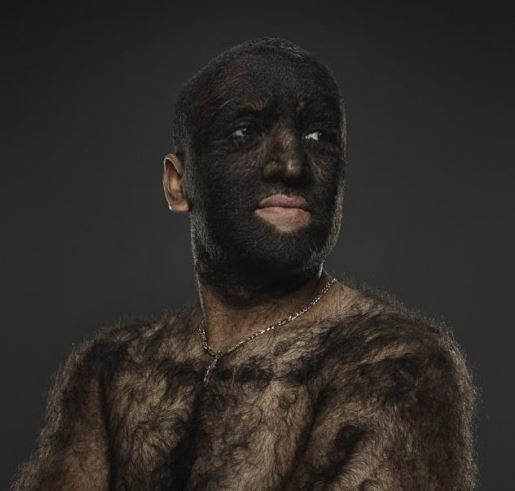 Another well-known deformity is elephantiasis, the disease afflicting the elephant man, Joseph Merrick. There is some speculation over whether it was elephantiasis or another genetic deformity, but others besides Mr. Merrick have suffered similar diseases and may have looked like a wolf-man to an onlooker. Some may rather have been known as an intimidating wolf instead of a deformed human.Along the same lines of misunderstandings over actual werewolves, think about how difficult it would be for a body to make so many changes. For the skeleton to extend and many of the bones to change shape; for the hearing to quadruple and the sense of smell to become one hundred times as effective as a human’s; for the eyes to develop a tapetum lucidum (the layer behind the retina that produces eyeshine and makes it easier to see in the dark); and not only to change once, but to change back and forth, whether with the moon cycle or at will. That would be a lot of stress on a body and if such a thing were somehow accomplished, it would take a lot of time and would cause an early death for sure, not an extended life.As for me, I’d like to think that people started believing in werewolves because wolves used to be able to talk (and maybe some still can!). Talking wolves. That would be cool.In Recent MediaOf course, there is the good old Twilight Saga. There is a lot of controversy around this one. It has many lovers and many haters. Personally, I enjoyed the story and listened to the audio book several times. But besides the point. Werewolves. And I found out during the research for this post that the Quileute people from her book were not made up, but were an actual tribe and they and the Kwakiutl people really did believe that their ancestors transformed into humans from their original wolf form. Which is pretty cool. I kind of wish I was descended from wolves!What other books have you read with werewolves in them? Or were-anything? I like the werecats in the Eragon series. I’d love to find out about other stories with were-animals of any kind!Creative CornerHow to get creative with werewolves…they have been done a few times before. What about a story with a pack of wolves, and one of it’s members can turn into a human?I’m also into this were-animal thing. What about wereturtles? Or weretigers? Wereostriches? Weregriffins! What animal would you turn into, if you could be a were-anything?
Another well-known deformity is elephantiasis, the disease afflicting the elephant man, Joseph Merrick. There is some speculation over whether it was elephantiasis or another genetic deformity, but others besides Mr. Merrick have suffered similar diseases and may have looked like a wolf-man to an onlooker. Some may rather have been known as an intimidating wolf instead of a deformed human.Along the same lines of misunderstandings over actual werewolves, think about how difficult it would be for a body to make so many changes. For the skeleton to extend and many of the bones to change shape; for the hearing to quadruple and the sense of smell to become one hundred times as effective as a human’s; for the eyes to develop a tapetum lucidum (the layer behind the retina that produces eyeshine and makes it easier to see in the dark); and not only to change once, but to change back and forth, whether with the moon cycle or at will. That would be a lot of stress on a body and if such a thing were somehow accomplished, it would take a lot of time and would cause an early death for sure, not an extended life.As for me, I’d like to think that people started believing in werewolves because wolves used to be able to talk (and maybe some still can!). Talking wolves. That would be cool.In Recent MediaOf course, there is the good old Twilight Saga. There is a lot of controversy around this one. It has many lovers and many haters. Personally, I enjoyed the story and listened to the audio book several times. But besides the point. Werewolves. And I found out during the research for this post that the Quileute people from her book were not made up, but were an actual tribe and they and the Kwakiutl people really did believe that their ancestors transformed into humans from their original wolf form. Which is pretty cool. I kind of wish I was descended from wolves!What other books have you read with werewolves in them? Or were-anything? I like the werecats in the Eragon series. I’d love to find out about other stories with were-animals of any kind!Creative CornerHow to get creative with werewolves…they have been done a few times before. What about a story with a pack of wolves, and one of it’s members can turn into a human?I’m also into this were-animal thing. What about wereturtles? Or weretigers? Wereostriches? Weregriffins! What animal would you turn into, if you could be a were-anything?
 Many cultures view the wolf as evil or at least in a negative light. This is likely due to many people groups relying very heavily on agriculture, and wolves killing and eating your herds would make you lose money and threaten your survival and that of your loved ones. As a result, many myths and legends of evil wolves have sprung up over the centuries. Let’s take a look at some ancient stories about wolves from both a positive and negative point of view, and then we’ll get into the meat of the werewolf idea. “meat” lol. One of the most well-known wolf stories is that of Fenrir, the great wolf of Norse mythology.
Many cultures view the wolf as evil or at least in a negative light. This is likely due to many people groups relying very heavily on agriculture, and wolves killing and eating your herds would make you lose money and threaten your survival and that of your loved ones. As a result, many myths and legends of evil wolves have sprung up over the centuries. Let’s take a look at some ancient stories about wolves from both a positive and negative point of view, and then we’ll get into the meat of the werewolf idea. “meat” lol. One of the most well-known wolf stories is that of Fenrir, the great wolf of Norse mythology. Fenrir was born the son of Loki and a giant, and while his terrible siblings Jormongandr and Hel could be sent away to other places to avoid their becoming problematic to the gods, Fenrir grew too fast. So the gods of Asgard decided they would have to bind him in order to protect themselves from him. Their first two attempts failed, and while the third was successful for much longer than the first two, it didn’t last forever. With the shaking of the rocks during Ragnarok, the stones that held his tether in place fell apart, releasing him. He was so big that he not only ate Odin, but swallowed the sun and moon as well.Not a very positive outlook on wolves at all.The name “Fenrir” means “he who dwells in the marshes.” Marshes are usually symbols of losing one’s way or being lost in the dark—even more negative connotation.The Wolf of Zhongshan is kind of a weird story from ancient China. An injured wolf was on the run from some hunters, and he met a scholar on the road and asked to hide in the his bookbag. The man agreed, and when the hunters reached them, pointed them in the wrong direction. Once they were far away, the wolf emerged, but instead of thanking the man for saving his life, he informed the man he wanted to eat him. The scholar convinced the wolf to wait until they could consult with three other individuals to hear their ruling on the subject.They asked an aprticot tree and an Ox, both of whom took the wolf’s side because they were prejudiced against humans due to negative treatment by their masters. But they came across a man on the road and he asked the wolf to prove that he could actually fit in the bookbag. The wolf obliged, and the man quickly tied him in and advised the scholar to kill him while he was restrained in order to save his own life.I think the moral of the story is not to be ungrateful for help. Interestingly, wolves have frequently been used in many stories to teach a lesson, especially to warn children away from behaving badly or getting into a dangerous situation.In Little Red Riding Hood, a story with countless different versions, the big bad wolf is a sneaky character that connived and tricked the grandmother and the granddaughter into a situation in which he could eat them. Many versions of the tale are cautionary against children disobeying their parents by doing things such as wandering off the path or letting strangers into the house.
Fenrir was born the son of Loki and a giant, and while his terrible siblings Jormongandr and Hel could be sent away to other places to avoid their becoming problematic to the gods, Fenrir grew too fast. So the gods of Asgard decided they would have to bind him in order to protect themselves from him. Their first two attempts failed, and while the third was successful for much longer than the first two, it didn’t last forever. With the shaking of the rocks during Ragnarok, the stones that held his tether in place fell apart, releasing him. He was so big that he not only ate Odin, but swallowed the sun and moon as well.Not a very positive outlook on wolves at all.The name “Fenrir” means “he who dwells in the marshes.” Marshes are usually symbols of losing one’s way or being lost in the dark—even more negative connotation.The Wolf of Zhongshan is kind of a weird story from ancient China. An injured wolf was on the run from some hunters, and he met a scholar on the road and asked to hide in the his bookbag. The man agreed, and when the hunters reached them, pointed them in the wrong direction. Once they were far away, the wolf emerged, but instead of thanking the man for saving his life, he informed the man he wanted to eat him. The scholar convinced the wolf to wait until they could consult with three other individuals to hear their ruling on the subject.They asked an aprticot tree and an Ox, both of whom took the wolf’s side because they were prejudiced against humans due to negative treatment by their masters. But they came across a man on the road and he asked the wolf to prove that he could actually fit in the bookbag. The wolf obliged, and the man quickly tied him in and advised the scholar to kill him while he was restrained in order to save his own life.I think the moral of the story is not to be ungrateful for help. Interestingly, wolves have frequently been used in many stories to teach a lesson, especially to warn children away from behaving badly or getting into a dangerous situation.In Little Red Riding Hood, a story with countless different versions, the big bad wolf is a sneaky character that connived and tricked the grandmother and the granddaughter into a situation in which he could eat them. Many versions of the tale are cautionary against children disobeying their parents by doing things such as wandering off the path or letting strangers into the house. Another story with associations to the Brother’s Grimm is that of the Three Little Pigs.In this story, a mother pig sends her three sons out into the world to seek their fortunes. One builds his house of straw, and a wolf comes along and destroys the house and eats him. Same for the second pig, who built his house of sticks.
Another story with associations to the Brother’s Grimm is that of the Three Little Pigs.In this story, a mother pig sends her three sons out into the world to seek their fortunes. One builds his house of straw, and a wolf comes along and destroys the house and eats him. Same for the second pig, who built his house of sticks.  But the third pig built his house of bricks, a feat that took more time and expense, but paid off in the end. The wolf couldn’t break down the house or trick the pig into coming out. When he tried sneaking in through the chimney, the third pig caught the wolf in a pot of boiling water and ate him.
But the third pig built his house of bricks, a feat that took more time and expense, but paid off in the end. The wolf couldn’t break down the house or trick the pig into coming out. When he tried sneaking in through the chimney, the third pig caught the wolf in a pot of boiling water and ate him. Another tale to warn children not to open the door to strangers, perhaps as well to teach them to build things to last and provide real protection.Despite all the negative characteristics associated with wolves, some cultures saw them in a more positive light. It is likely that cultures who relied more heavily on hunting than breeding their own livestock admired the wolf’s hunting prowess and thought highly of the creatures as a result.In nearly all Native American cultures, the wolf is associated with medicine, courage, successful hunting skills and loyalty.
Another tale to warn children not to open the door to strangers, perhaps as well to teach them to build things to last and provide real protection.Despite all the negative characteristics associated with wolves, some cultures saw them in a more positive light. It is likely that cultures who relied more heavily on hunting than breeding their own livestock admired the wolf’s hunting prowess and thought highly of the creatures as a result.In nearly all Native American cultures, the wolf is associated with medicine, courage, successful hunting skills and loyalty. Chibiabos, for example, is a great wolf-spirit in Algonquin mythology. His name means “ghost rabbit” but he was a wolf spirit, usually in the physical form of a wolf. When he was unjustly murdered by water spirits, he became the ruler of the land of the dead and was considered a kind and fair ruler.Did you know that Sirius Black is actually named after a star? Which happens to be the brightest star in the sky, and the dominant star in the Canis Major constellation? This, in fact, was all news to me. Am I the only person who didn’t know that “Sirius” is the name of the brightest star in the Great Dog constellation? I’m feeling a bit behind the times!
Chibiabos, for example, is a great wolf-spirit in Algonquin mythology. His name means “ghost rabbit” but he was a wolf spirit, usually in the physical form of a wolf. When he was unjustly murdered by water spirits, he became the ruler of the land of the dead and was considered a kind and fair ruler.Did you know that Sirius Black is actually named after a star? Which happens to be the brightest star in the sky, and the dominant star in the Canis Major constellation? This, in fact, was all news to me. Am I the only person who didn’t know that “Sirius” is the name of the brightest star in the Great Dog constellation? I’m feeling a bit behind the times! Anyway, Sirius is also the white direction star, and the Pawnee people, who valued wolves most highly, called the Milky Way the Wolf Road. They believed that the Milky Way was a spirit road walked by the dead. They were also one of the few tribes to pay more attention to the stars rather than the sun and moon.Going back a little further, another example of a wolf seen in a positive light is the wolf who partially raised Romulus and Remus. Legend has it that their mother was forbidden to have children lest she birth rivals to the throne, but she had two children fathered by the war god, Mars, anyway.
Anyway, Sirius is also the white direction star, and the Pawnee people, who valued wolves most highly, called the Milky Way the Wolf Road. They believed that the Milky Way was a spirit road walked by the dead. They were also one of the few tribes to pay more attention to the stars rather than the sun and moon.Going back a little further, another example of a wolf seen in a positive light is the wolf who partially raised Romulus and Remus. Legend has it that their mother was forbidden to have children lest she birth rivals to the throne, but she had two children fathered by the war god, Mars, anyway.  They were sentenced to be drowned, but instead of sinking, the basket they were laid in floated down the river and was found by a wolf and a woodpecker. They worked together to feed the children until they were found by a shepherd who raised them from then on.So we’ve seen wolves in both a negative and positive light in different cultures, now onto the werewolf legends, and what—if any—truth we can filter out of them.Possibly the very earliest recorded story of a human being turned into a wolf comes from the Epic of Gilgamesh, which supposedly took place around 2600 BC. In this particular story, a goddess was in love with the hero, Gilgamesh, and tried to flirt with him. But he rejected her advances because of how she treated other suitors.One such man was a shepherd who left her many gifts on a shrine on a beautiful mountainside. At first she lead him on and encouraged him, but then she grew bored of his attentions and turned him into a wolf, and his own hounds tore him apart.An ancient Greek myth speaks of Zeus turning Lyceaon into a werewolf. The story goes that Lyceaon threw a party and wanted to be sure that Zeus was really who he claimed to be. So he had a man killed and his flesh served to Zeus, in order to see if he was god enough to notice. Well, he was. And he was quite offended. So because of Lyceaon’s wolf-like actions of killing a man and proposing that his flesh be eaten, he turned him into a werewolf. And it is from the name “Lyceaon” that we get the name “lycanthrope.”Perhaps the next oldest story, going all the way back to 39BC, is recorded by Virgil in his Alphesiboeus. He wrote that a man named Moeris could turn himself into a wolf using herbs and poisons.“These herbs, these poisons, that were culled in Pontus, it was Moeris Himself that gave them me. Such herbs are common weeds in Pontus. Oft by their sorcery I have seen Moeris turn wolf and hide Within the woods, oft call forth spirits from their deep-dug graves, And charm away to other fields whole harvests of sown corn.”In this case, the man could turn himself into a wolf, rather than being forced to turn into a wolf by someone else.A Native American example of a possible werewolf comes from Guarani mythology. When an evil spirit named Tao took on a human form in order to marry a beautiful woman, Kerana, he incurred the wrath of the high goddess Arasy, who cursed the seven sons they produced. Each one had a different monstrous form and some were used as scary stories to make children nap during their siestas, lest they be lured by one of the monsters, and as an excuse for adulterous women who mysteriously became pregnant.The last of the seven sons was named Luison, and he had the appearance of a sick wolf-like creature. He was half human, half wolf, not necessarily something that transformed between the two. He smelled like death and decay and hung around graveyards. To be touched by the Lusion was a sign of impending death. As a result, it is considered unlucky to be the seventh son, and some believe that all seventh sons become werewolve-like creatures.
They were sentenced to be drowned, but instead of sinking, the basket they were laid in floated down the river and was found by a wolf and a woodpecker. They worked together to feed the children until they were found by a shepherd who raised them from then on.So we’ve seen wolves in both a negative and positive light in different cultures, now onto the werewolf legends, and what—if any—truth we can filter out of them.Possibly the very earliest recorded story of a human being turned into a wolf comes from the Epic of Gilgamesh, which supposedly took place around 2600 BC. In this particular story, a goddess was in love with the hero, Gilgamesh, and tried to flirt with him. But he rejected her advances because of how she treated other suitors.One such man was a shepherd who left her many gifts on a shrine on a beautiful mountainside. At first she lead him on and encouraged him, but then she grew bored of his attentions and turned him into a wolf, and his own hounds tore him apart.An ancient Greek myth speaks of Zeus turning Lyceaon into a werewolf. The story goes that Lyceaon threw a party and wanted to be sure that Zeus was really who he claimed to be. So he had a man killed and his flesh served to Zeus, in order to see if he was god enough to notice. Well, he was. And he was quite offended. So because of Lyceaon’s wolf-like actions of killing a man and proposing that his flesh be eaten, he turned him into a werewolf. And it is from the name “Lyceaon” that we get the name “lycanthrope.”Perhaps the next oldest story, going all the way back to 39BC, is recorded by Virgil in his Alphesiboeus. He wrote that a man named Moeris could turn himself into a wolf using herbs and poisons.“These herbs, these poisons, that were culled in Pontus, it was Moeris Himself that gave them me. Such herbs are common weeds in Pontus. Oft by their sorcery I have seen Moeris turn wolf and hide Within the woods, oft call forth spirits from their deep-dug graves, And charm away to other fields whole harvests of sown corn.”In this case, the man could turn himself into a wolf, rather than being forced to turn into a wolf by someone else.A Native American example of a possible werewolf comes from Guarani mythology. When an evil spirit named Tao took on a human form in order to marry a beautiful woman, Kerana, he incurred the wrath of the high goddess Arasy, who cursed the seven sons they produced. Each one had a different monstrous form and some were used as scary stories to make children nap during their siestas, lest they be lured by one of the monsters, and as an excuse for adulterous women who mysteriously became pregnant.The last of the seven sons was named Luison, and he had the appearance of a sick wolf-like creature. He was half human, half wolf, not necessarily something that transformed between the two. He smelled like death and decay and hung around graveyards. To be touched by the Lusion was a sign of impending death. As a result, it is considered unlucky to be the seventh son, and some believe that all seventh sons become werewolve-like creatures. Another more recent werewolf incident was that of Peter Stubbe, a serial killer. Throughout the sixteenth century, Stubbe was accused of being a werewolf, practicing witchcraft, and giving into his cannibalistic tendencies. When he was caught, he claimed that the devil himself gave him a belt of wolf fur that would transform him into a werewolf when he wore it. The horrible crimes he committed, including the murder of many women and children and livestock, were likely the result of a mental disorder rather than an ability to change form.Instead of considering how one might go back and forth from human to wolf, let’s take a look at what might look like a wolf-man if seen in the dark.Hypertrichosis, an overgrowth of hair all over the body, has been referred to as “werewolf syndrome” for decades. Excessive amounts of hair may or may not be present at birth, but a significant amount of hair in unwanted places such as the face can continue to grow throughout life.
Another more recent werewolf incident was that of Peter Stubbe, a serial killer. Throughout the sixteenth century, Stubbe was accused of being a werewolf, practicing witchcraft, and giving into his cannibalistic tendencies. When he was caught, he claimed that the devil himself gave him a belt of wolf fur that would transform him into a werewolf when he wore it. The horrible crimes he committed, including the murder of many women and children and livestock, were likely the result of a mental disorder rather than an ability to change form.Instead of considering how one might go back and forth from human to wolf, let’s take a look at what might look like a wolf-man if seen in the dark.Hypertrichosis, an overgrowth of hair all over the body, has been referred to as “werewolf syndrome” for decades. Excessive amounts of hair may or may not be present at birth, but a significant amount of hair in unwanted places such as the face can continue to grow throughout life. Another well-known deformity is elephantiasis, the disease afflicting the elephant man, Joseph Merrick. There is some speculation over whether it was elephantiasis or another genetic deformity, but others besides Mr. Merrick have suffered similar diseases and may have looked like a wolf-man to an onlooker. Some may rather have been known as an intimidating wolf instead of a deformed human.Along the same lines of misunderstandings over actual werewolves, think about how difficult it would be for a body to make so many changes. For the skeleton to extend and many of the bones to change shape; for the hearing to quadruple and the sense of smell to become one hundred times as effective as a human’s; for the eyes to develop a tapetum lucidum (the layer behind the retina that produces eyeshine and makes it easier to see in the dark); and not only to change once, but to change back and forth, whether with the moon cycle or at will. That would be a lot of stress on a body and if such a thing were somehow accomplished, it would take a lot of time and would cause an early death for sure, not an extended life.As for me, I’d like to think that people started believing in werewolves because wolves used to be able to talk (and maybe some still can!). Talking wolves. That would be cool.In Recent MediaOf course, there is the good old Twilight Saga. There is a lot of controversy around this one. It has many lovers and many haters. Personally, I enjoyed the story and listened to the audio book several times. But besides the point. Werewolves. And I found out during the research for this post that the Quileute people from her book were not made up, but were an actual tribe and they and the Kwakiutl people really did believe that their ancestors transformed into humans from their original wolf form. Which is pretty cool. I kind of wish I was descended from wolves!What other books have you read with werewolves in them? Or were-anything? I like the werecats in the Eragon series. I’d love to find out about other stories with were-animals of any kind!Creative CornerHow to get creative with werewolves…they have been done a few times before. What about a story with a pack of wolves, and one of it’s members can turn into a human?I’m also into this were-animal thing. What about wereturtles? Or weretigers? Wereostriches? Weregriffins! What animal would you turn into, if you could be a were-anything?
Another well-known deformity is elephantiasis, the disease afflicting the elephant man, Joseph Merrick. There is some speculation over whether it was elephantiasis or another genetic deformity, but others besides Mr. Merrick have suffered similar diseases and may have looked like a wolf-man to an onlooker. Some may rather have been known as an intimidating wolf instead of a deformed human.Along the same lines of misunderstandings over actual werewolves, think about how difficult it would be for a body to make so many changes. For the skeleton to extend and many of the bones to change shape; for the hearing to quadruple and the sense of smell to become one hundred times as effective as a human’s; for the eyes to develop a tapetum lucidum (the layer behind the retina that produces eyeshine and makes it easier to see in the dark); and not only to change once, but to change back and forth, whether with the moon cycle or at will. That would be a lot of stress on a body and if such a thing were somehow accomplished, it would take a lot of time and would cause an early death for sure, not an extended life.As for me, I’d like to think that people started believing in werewolves because wolves used to be able to talk (and maybe some still can!). Talking wolves. That would be cool.In Recent MediaOf course, there is the good old Twilight Saga. There is a lot of controversy around this one. It has many lovers and many haters. Personally, I enjoyed the story and listened to the audio book several times. But besides the point. Werewolves. And I found out during the research for this post that the Quileute people from her book were not made up, but were an actual tribe and they and the Kwakiutl people really did believe that their ancestors transformed into humans from their original wolf form. Which is pretty cool. I kind of wish I was descended from wolves!What other books have you read with werewolves in them? Or were-anything? I like the werecats in the Eragon series. I’d love to find out about other stories with were-animals of any kind!Creative CornerHow to get creative with werewolves…they have been done a few times before. What about a story with a pack of wolves, and one of it’s members can turn into a human?I’m also into this were-animal thing. What about wereturtles? Or weretigers? Wereostriches? Weregriffins! What animal would you turn into, if you could be a were-anything?
Published on April 17, 2018 19:30
March 20, 2018
The Cosmic Turtle: Where'd That Idea Come From?
 Many different cultures have ideas about the Cosmic Turtle—the great turtle that holds up the world. Let’s take a look at a few of the stories from different cultures and find out what inspired them.The ancient Chinese myth about this celestial beast went like this: A god named Gong Gong went into a fit of rage and banged his head against the mountains, like the mature adult he apparently was. Unfortunately, those mountains were holding up the sky, and without them the sky would literally plummet into the ocean. So the creator goddess, Nuwa, came to the rescue of the world. She cut the legs off of the giant sea turtle named Ao, and used them to prop up the sky. A bit unfortunate for Ao, but he's still depicted with all four legs in most art, so hopefully they grew back.The ancient Chinese believed all tortoises were female, and that the great tortoise would have to mate with a snake in order to procreate. As a result of this belief, we have the image of the great tortoise and the great snake intertwined, holding up the world together.
Many different cultures have ideas about the Cosmic Turtle—the great turtle that holds up the world. Let’s take a look at a few of the stories from different cultures and find out what inspired them.The ancient Chinese myth about this celestial beast went like this: A god named Gong Gong went into a fit of rage and banged his head against the mountains, like the mature adult he apparently was. Unfortunately, those mountains were holding up the sky, and without them the sky would literally plummet into the ocean. So the creator goddess, Nuwa, came to the rescue of the world. She cut the legs off of the giant sea turtle named Ao, and used them to prop up the sky. A bit unfortunate for Ao, but he's still depicted with all four legs in most art, so hopefully they grew back.The ancient Chinese believed all tortoises were female, and that the great tortoise would have to mate with a snake in order to procreate. As a result of this belief, we have the image of the great tortoise and the great snake intertwined, holding up the world together.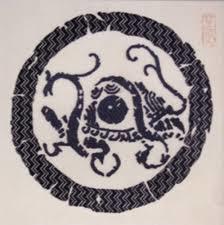 This image eventually became the Chinese symbol for the north.
This image eventually became the Chinese symbol for the north. So why the elephants that are so often depicted between the world and the turtle’s shell? One theory is that there was a mistranslation of the word for serpent into elephant, as they are similar due to the elephant’s snake-like trunk.
So why the elephants that are so often depicted between the world and the turtle’s shell? One theory is that there was a mistranslation of the word for serpent into elephant, as they are similar due to the elephant’s snake-like trunk.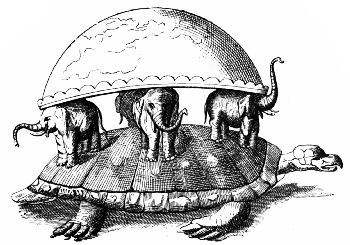 So why a turtle in the first place? Why not another animal? One reason is because the tortoise represents longevity and preservation in many cultures, thanks to it’s ability to live a very long life. The oldest known tortoise is currently 186 years old, and there are reports of others even older. Another reason is because it’s anatomy mirrors the appearance of the earth and sky. At that time, people believed the earth to be flat. The tortoise’s bottom shell, called the plastron, is usually flat, while the carapace, or top shell, is curved like the domed sky.
So why a turtle in the first place? Why not another animal? One reason is because the tortoise represents longevity and preservation in many cultures, thanks to it’s ability to live a very long life. The oldest known tortoise is currently 186 years old, and there are reports of others even older. Another reason is because it’s anatomy mirrors the appearance of the earth and sky. At that time, people believed the earth to be flat. The tortoise’s bottom shell, called the plastron, is usually flat, while the carapace, or top shell, is curved like the domed sky.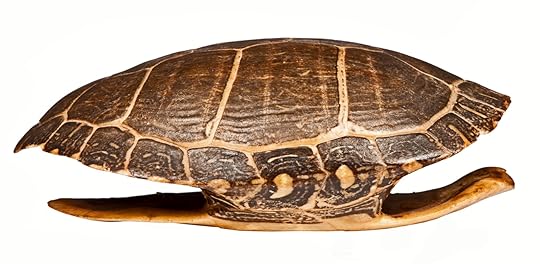 Many believe that the Indian and Chinese beliefs regarding the cosmic turtle are so similar that they likely originated from the same place. In his book Researches Into the Early History of Mankind and the Development of Civilization, anthropologist Edward Burnett Tylor writes that it likely started in Hindu mythology first. One of their mythologies involves a god named Vishnu, who has many forms. One of his forms is Kurma, a great turtle that holds up a large mountain.Ancient Hindu culture also believed that turtles/tortoises were the first living beings in existence, and the pulling of the head into the shell is a show of looking inward/meditating, which is another reason Asian cultures valued the turtle. They saw it as a representation of an advanced spiritual state.
Many believe that the Indian and Chinese beliefs regarding the cosmic turtle are so similar that they likely originated from the same place. In his book Researches Into the Early History of Mankind and the Development of Civilization, anthropologist Edward Burnett Tylor writes that it likely started in Hindu mythology first. One of their mythologies involves a god named Vishnu, who has many forms. One of his forms is Kurma, a great turtle that holds up a large mountain.Ancient Hindu culture also believed that turtles/tortoises were the first living beings in existence, and the pulling of the head into the shell is a show of looking inward/meditating, which is another reason Asian cultures valued the turtle. They saw it as a representation of an advanced spiritual state.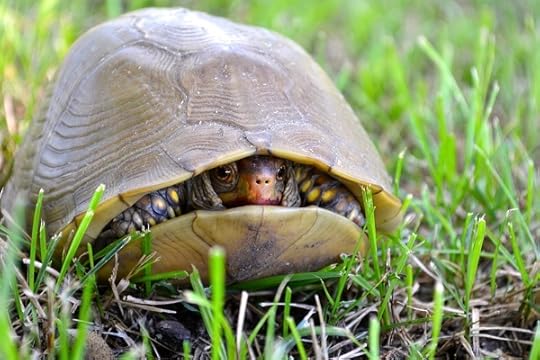 While the Chinese and Hindu ideas may have evolved together somewhat, the South American myths appear to have arisen separately.So why turtles for the South Americans? Once again, this appears to be due to their shape resembling the flat earth and domed sky, and due to their long lives. Longevity and preservation were greatly attributes valued in the Native American culture, and they found the idea of being carried through space by a being that knows where they're headed to be a comforting one.Lenape and Iroquois people in particular believe that soil was piled on the back of a turtle that continued to grow until the whole world was literally on its shoulders.In 2012, an extinct species of turtle with an unusually rounded shell was found in Colombia’s La Puente pit in the Cerrejón Coal Mine. With a carapace diameter of 1.5 meters, this giant, rounded turtle might have been the one to inspire the belief in the Cosmic Turtle in this part of the world.
While the Chinese and Hindu ideas may have evolved together somewhat, the South American myths appear to have arisen separately.So why turtles for the South Americans? Once again, this appears to be due to their shape resembling the flat earth and domed sky, and due to their long lives. Longevity and preservation were greatly attributes valued in the Native American culture, and they found the idea of being carried through space by a being that knows where they're headed to be a comforting one.Lenape and Iroquois people in particular believe that soil was piled on the back of a turtle that continued to grow until the whole world was literally on its shoulders.In 2012, an extinct species of turtle with an unusually rounded shell was found in Colombia’s La Puente pit in the Cerrejón Coal Mine. With a carapace diameter of 1.5 meters, this giant, rounded turtle might have been the one to inspire the belief in the Cosmic Turtle in this part of the world.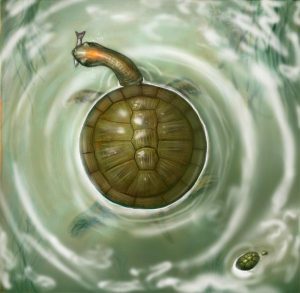 The Yoruba people of Africa developed a divination system called Ifa that used tortoise shells as oracles. Turtle and tortoise shells were also used by the ancient Chinese for the same purpose. Various cultures had different mixes of shells and bones and things for use in foretelling the future.And due to the general longevity of turtles and tortoises, they are viewed by many cultures as good luck and symbols of a long life. Some believe that keeping a turtle bone in your pocket will bring you general good fortune. Some believe that if placed in certain parts of your house, a tortoise shell can bring you smooth business transactions, and if placed by your front door, will protect your house from danger. Some cultures even believe that if you take an empty tortoise shell, turn it upside down and fill it with water, the water can be used for scrying.While I can get a little free with ideas about how certain mythical creatures may really have existed, I’m afraid the fact that we have pictures from space of a round earth completely lacking in turtle, snake or elephant support, I have to say that the cosmic turtle doesn’t have much chance of being real. But whatever inspired surely was!Unless the astronauts are lying to us....In Recent MediaThere isn’t a whole lot in recent media on this topic. Mostly just speculation about Maturin easter eggs in Stephen King movies and a little about the Teenage Mutant Ninja Turtles.There is also mention of the Great A’Turin, the giant cosmic turtle in Terry Pratchett’s Discworld fantasy series. There's forty-one novels in this series! Dang!I just added it to my infinite TBR! How about you?Creative CornerUsing tortoise shells for scrying? How cool is that? In books I’ve read where characters were able to scry, it was through water anywhere. Limiting your character by only allowing scrying to work if there is a tortoise shell could get really interesting. She could have to kill a fierce tortoise with a fight to the death, or tortoises could be intelligent like a sphinx and she could have to trick him out of his shell or agree to solve a riddle with high stakes. Or she could have a heart and not want to kill an innocent animal, but have no other way to get orders from her leader or to spy on her enemy in order to find out what to do next. This could be a really interesting way to add some struggle to your character’s story.The fact that the shape of the turtle/tortoise shell resembles a flat world and domed sky is really interesting. Maybe your fantasy world is flat, and they could worship turtles because of how their shape represents the world.What kind of interesting mix of animals could you create using a turtle/tortoise and particularly the shell? Maybe a tiger-like animal, but with scales like a reptile and with a shell that it can disappear into for safety. Or maybe a tortoise whose shell can open up with a pair of wings allowing it to fly away.Set your imagination free!Happy writing!
The Yoruba people of Africa developed a divination system called Ifa that used tortoise shells as oracles. Turtle and tortoise shells were also used by the ancient Chinese for the same purpose. Various cultures had different mixes of shells and bones and things for use in foretelling the future.And due to the general longevity of turtles and tortoises, they are viewed by many cultures as good luck and symbols of a long life. Some believe that keeping a turtle bone in your pocket will bring you general good fortune. Some believe that if placed in certain parts of your house, a tortoise shell can bring you smooth business transactions, and if placed by your front door, will protect your house from danger. Some cultures even believe that if you take an empty tortoise shell, turn it upside down and fill it with water, the water can be used for scrying.While I can get a little free with ideas about how certain mythical creatures may really have existed, I’m afraid the fact that we have pictures from space of a round earth completely lacking in turtle, snake or elephant support, I have to say that the cosmic turtle doesn’t have much chance of being real. But whatever inspired surely was!Unless the astronauts are lying to us....In Recent MediaThere isn’t a whole lot in recent media on this topic. Mostly just speculation about Maturin easter eggs in Stephen King movies and a little about the Teenage Mutant Ninja Turtles.There is also mention of the Great A’Turin, the giant cosmic turtle in Terry Pratchett’s Discworld fantasy series. There's forty-one novels in this series! Dang!I just added it to my infinite TBR! How about you?Creative CornerUsing tortoise shells for scrying? How cool is that? In books I’ve read where characters were able to scry, it was through water anywhere. Limiting your character by only allowing scrying to work if there is a tortoise shell could get really interesting. She could have to kill a fierce tortoise with a fight to the death, or tortoises could be intelligent like a sphinx and she could have to trick him out of his shell or agree to solve a riddle with high stakes. Or she could have a heart and not want to kill an innocent animal, but have no other way to get orders from her leader or to spy on her enemy in order to find out what to do next. This could be a really interesting way to add some struggle to your character’s story.The fact that the shape of the turtle/tortoise shell resembles a flat world and domed sky is really interesting. Maybe your fantasy world is flat, and they could worship turtles because of how their shape represents the world.What kind of interesting mix of animals could you create using a turtle/tortoise and particularly the shell? Maybe a tiger-like animal, but with scales like a reptile and with a shell that it can disappear into for safety. Or maybe a tortoise whose shell can open up with a pair of wings allowing it to fly away.Set your imagination free!Happy writing!
Published on March 20, 2018 18:53
March 6, 2018
The Unicorn: Rhinoceros, Oryx, or Something Else?
 Unicorns. The fairy princess’s first choice of true friend and trusty steed, faultlessly flaunting braided hair and exuding rainbows.How did it become so pink-and-purplified? And where did the idea for a horse with a single horn sticking out of its head come from? And why did people think its horns had healing powers? In today’s blog post, I answer all these questions and more!How many animals do you know of that only have one horn? The rhino (some species, anyway) and the narwhal. And this little one-horned chameleon, if you want to count him. He’s pretty cute, so we will.
Unicorns. The fairy princess’s first choice of true friend and trusty steed, faultlessly flaunting braided hair and exuding rainbows.How did it become so pink-and-purplified? And where did the idea for a horse with a single horn sticking out of its head come from? And why did people think its horns had healing powers? In today’s blog post, I answer all these questions and more!How many animals do you know of that only have one horn? The rhino (some species, anyway) and the narwhal. And this little one-horned chameleon, if you want to count him. He’s pretty cute, so we will.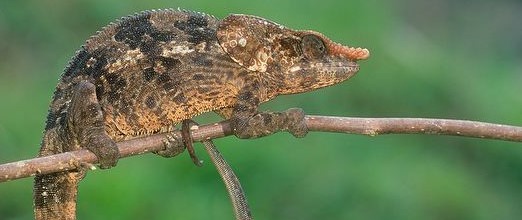 Anyone else? No? That’s because most animals are a bit more symmetrical with their horns and antlers.So how did the unicorn end up with only one?Let’s take a look at what similar creatures, both living and extinct, may have inspired the idea of the unicorn, assuming it's only a made-up animal. What do these animals have to tell us?Once again, we look to ancient Greece for the origins of this creature’s story. This is another animal, like the griffin, who did not make appearances in mythological stories so much as it was mentioned in real-life accounts. They are described by the Greek historian Ctesias as having the body of a horse and a horn about a cubit long. He says that the horn is white at the base, black in the middle, and flaming red on the end.Pliny the elder says that it has the body of a horse (if a bit bigger), the head of a stag, the feet of an elephant and the tail of a boar. According to him, the horn reaches lengths of three feet and was mostly black. Many other Greek historians describe the creature similarly.Other than the colors of the horn, these descriptions make me think rhino. They have feet similar to elephants—ish—and some species have tails that curl over like a pig’s. While there are some species of rhino that have two horns, others only have one. And they can reach lengths of three feet.To people of our time who’ve grown up seeing animals from all over the world, a rhino doesn't really look like a horse. But if you hadn’t had access to pictures of all kinds of animals and were mostly limited to horses, elephants and boars, you might decide that a rhino does most closely resemble a horse.Where this doesn’t fit is the part about the head of the stag (male deer). Another theory about what animal they could have been describing is the Arabian oryx. This creature has two horns, but if viewed from the perfect lateral angle, they appear to be one. This creature does have a deer-like head, but it’s tail more closely resembles that of a horse than a boar. And it has hooved feet, very un-elephant-like. My biggest problem with this theory is that it only works if the oryx is never seen from any angle except perfectly sideways.
Anyone else? No? That’s because most animals are a bit more symmetrical with their horns and antlers.So how did the unicorn end up with only one?Let’s take a look at what similar creatures, both living and extinct, may have inspired the idea of the unicorn, assuming it's only a made-up animal. What do these animals have to tell us?Once again, we look to ancient Greece for the origins of this creature’s story. This is another animal, like the griffin, who did not make appearances in mythological stories so much as it was mentioned in real-life accounts. They are described by the Greek historian Ctesias as having the body of a horse and a horn about a cubit long. He says that the horn is white at the base, black in the middle, and flaming red on the end.Pliny the elder says that it has the body of a horse (if a bit bigger), the head of a stag, the feet of an elephant and the tail of a boar. According to him, the horn reaches lengths of three feet and was mostly black. Many other Greek historians describe the creature similarly.Other than the colors of the horn, these descriptions make me think rhino. They have feet similar to elephants—ish—and some species have tails that curl over like a pig’s. While there are some species of rhino that have two horns, others only have one. And they can reach lengths of three feet.To people of our time who’ve grown up seeing animals from all over the world, a rhino doesn't really look like a horse. But if you hadn’t had access to pictures of all kinds of animals and were mostly limited to horses, elephants and boars, you might decide that a rhino does most closely resemble a horse.Where this doesn’t fit is the part about the head of the stag (male deer). Another theory about what animal they could have been describing is the Arabian oryx. This creature has two horns, but if viewed from the perfect lateral angle, they appear to be one. This creature does have a deer-like head, but it’s tail more closely resembles that of a horse than a boar. And it has hooved feet, very un-elephant-like. My biggest problem with this theory is that it only works if the oryx is never seen from any angle except perfectly sideways. 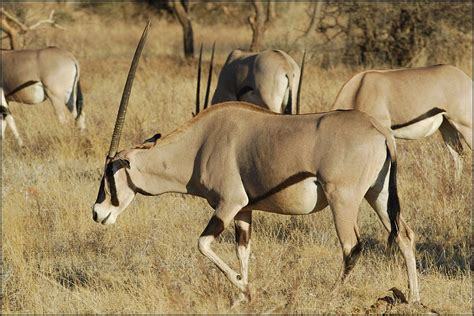 There's just no way that people were only seeing it from one angle, with the horns always perfectly lined up. Unless a whole group of people were just looking at some artwork done by someone else who had drawn them all from a side angle.And this little guy? He was never in the running, of course. He’s just cute.
There's just no way that people were only seeing it from one angle, with the horns always perfectly lined up. Unless a whole group of people were just looking at some artwork done by someone else who had drawn them all from a side angle.And this little guy? He was never in the running, of course. He’s just cute.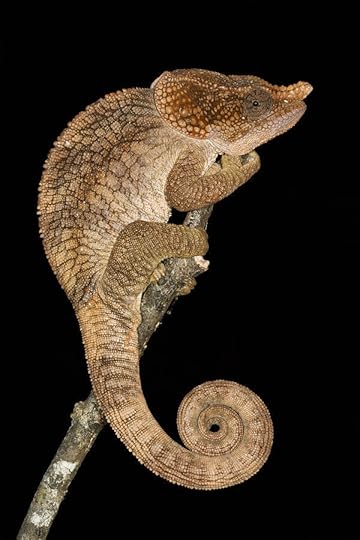 The Greeks also said that it is a fierce animal impossible to take alive. This definitely would fit the rhino. They are very dangerous, and will invariably charge if taken by surprise, especially a mother with her calf. Can you imagine trying to wrangle a thirteen-foot-long 4-ton animal with a three-foot horn swinging at you? I’m sure the oryx would give you a run for your money too, but sounds like the rhino would be much more intimidating.But neither of these animals completely fits the description.So if it wasn’t either of them, what might it have been? What creatures do we have fossil evidence of?
The Greeks also said that it is a fierce animal impossible to take alive. This definitely would fit the rhino. They are very dangerous, and will invariably charge if taken by surprise, especially a mother with her calf. Can you imagine trying to wrangle a thirteen-foot-long 4-ton animal with a three-foot horn swinging at you? I’m sure the oryx would give you a run for your money too, but sounds like the rhino would be much more intimidating.But neither of these animals completely fits the description.So if it wasn’t either of them, what might it have been? What creatures do we have fossil evidence of? Meet Elasmotherium, a giant rhinoceros-like prehistoric beast also known as the Siberian Unicorn. This guy was three meters tall! Nine feet! Scientists speculate that his horn was also about three feet long at the most.But the kicker about Elasmotherium is that his horn has never actually been found. He’s got a huge hole in his rostrum (nose) where a horn could conceivably have fit, but apparently rhino horns just don’t fossilize.Why is this? Most horns are made of bone covered in a layer of keratin, which is why they fossilize—because of the bone. But a rhino horn is just keratin. Which means that like hair, it doesn’t fossilize well.Interestingly though, their horns can be preserved in ice, and a baby wooly rhino, which is similar to the Elasmotherium though it has two horns, was recently found in the permafrost of Siberia. Its horns were very tiny, as it was only a baby, but they were both definitely there.
Meet Elasmotherium, a giant rhinoceros-like prehistoric beast also known as the Siberian Unicorn. This guy was three meters tall! Nine feet! Scientists speculate that his horn was also about three feet long at the most.But the kicker about Elasmotherium is that his horn has never actually been found. He’s got a huge hole in his rostrum (nose) where a horn could conceivably have fit, but apparently rhino horns just don’t fossilize.Why is this? Most horns are made of bone covered in a layer of keratin, which is why they fossilize—because of the bone. But a rhino horn is just keratin. Which means that like hair, it doesn’t fossilize well.Interestingly though, their horns can be preserved in ice, and a baby wooly rhino, which is similar to the Elasmotherium though it has two horns, was recently found in the permafrost of Siberia. Its horns were very tiny, as it was only a baby, but they were both definitely there. Still though, these prehistoric rhinos were significantly bigger than a horse and also lack the deer-like head.Besides this, there is very little fossil evidence of unicorn-like animals.But wait! Look at this!
Still though, these prehistoric rhinos were significantly bigger than a horse and also lack the deer-like head.Besides this, there is very little fossil evidence of unicorn-like animals.But wait! Look at this! Just kidding. Unfortunately, this is not an exciting fossil of a possible unicorn. This is the skull of a roe deer recently shot by a hunter in Slovenia. This deer had a rare antler deformity that caused it to only have one horn. Scientists believe that it was likely caused by a head injury when it was very young.Was the unicorn probably based on something like rhino or an oryx, or another animal with some kind of deformity? While these theories have their merits, there are still a lot of holes in them. Maybe there really was something more unicorn-ish out there that we just haven’t managed to find yet.So how did they become so girlified?Unicorns are usually associated with innocence and purity, qualities that are usually associated more with women than men, especially young women. There are bits of stories about how the only way a unicorn can be caught is by a pure, virgin girl. Could those stories be true?Over time, due to these associations, the creature gradually became pastel and sparkly until it reached favorite animals status with all the princesses. And here we are now.But what about those healing powers?In ancient times, “unicorn horns” were believed to be incredibly valuable medicinally. If you drank from a cup made of one, or if you sprinkled powder from a ground-up horn into a drink, the liquid would bubble if there was any poison present, preventing people from getting poisoned. It was also believed that if you ingested the powder from grinding up the horn, it could cure fever. Because of this ancient belief, scientists did an experiment to see if any of it was true. And interestingly, it was found that ground rhino horn could slightly lower fever in rats. But they were using significantly higher concentrations of ground horn than people did in ancient times. So what made them keep thinking that it was helping?Could the horns have been more useful for lowering fever in ancient times?What about wolf saliva? Have you ever heard about how wolves used to be able to heal wounds by licking them? Presumably, that is why dogs still lick their wounds today. And scientists have found that dog saliva does have some bactericidal elements. The theory is that wolves used to have an even stronger healing ability with their saliva, but it has been lost through the generations of wolves still alive today, and lost to the point of barely existing at all in domestic dogs.
Just kidding. Unfortunately, this is not an exciting fossil of a possible unicorn. This is the skull of a roe deer recently shot by a hunter in Slovenia. This deer had a rare antler deformity that caused it to only have one horn. Scientists believe that it was likely caused by a head injury when it was very young.Was the unicorn probably based on something like rhino or an oryx, or another animal with some kind of deformity? While these theories have their merits, there are still a lot of holes in them. Maybe there really was something more unicorn-ish out there that we just haven’t managed to find yet.So how did they become so girlified?Unicorns are usually associated with innocence and purity, qualities that are usually associated more with women than men, especially young women. There are bits of stories about how the only way a unicorn can be caught is by a pure, virgin girl. Could those stories be true?Over time, due to these associations, the creature gradually became pastel and sparkly until it reached favorite animals status with all the princesses. And here we are now.But what about those healing powers?In ancient times, “unicorn horns” were believed to be incredibly valuable medicinally. If you drank from a cup made of one, or if you sprinkled powder from a ground-up horn into a drink, the liquid would bubble if there was any poison present, preventing people from getting poisoned. It was also believed that if you ingested the powder from grinding up the horn, it could cure fever. Because of this ancient belief, scientists did an experiment to see if any of it was true. And interestingly, it was found that ground rhino horn could slightly lower fever in rats. But they were using significantly higher concentrations of ground horn than people did in ancient times. So what made them keep thinking that it was helping?Could the horns have been more useful for lowering fever in ancient times?What about wolf saliva? Have you ever heard about how wolves used to be able to heal wounds by licking them? Presumably, that is why dogs still lick their wounds today. And scientists have found that dog saliva does have some bactericidal elements. The theory is that wolves used to have an even stronger healing ability with their saliva, but it has been lost through the generations of wolves still alive today, and lost to the point of barely existing at all in domestic dogs.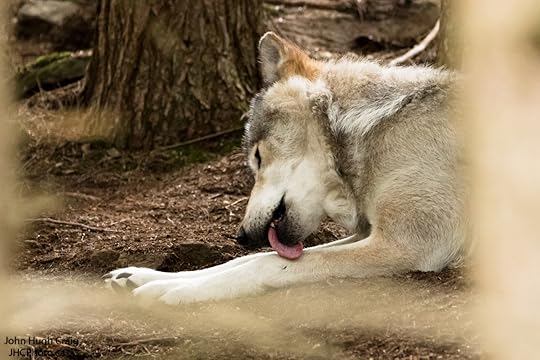 What if rhino horns really did have healing abilities once, but whatever caused the wolves’ abilities to decrease also decreased the rhinos?And then what if unicorns really did exist and their horns had even greater healing properties? That experiment about the rhino horn extract lowering fever in rats didn't only look at rhinos. They also found that extract from the horns of the Saiga antelope and water buffalo had the same effect. And both rhino horns and narwhal tusks were sold as unicorn horns for great prices. Were actual unicorn horns perhaps included in this?So what if there was an animal who had one horn that was made of just keratin or some similar non-fossilizing material, that when ground up and dissolved in liquid, really did have healing properties?Since none of our candidates for possible unicorn inspiration completely fit the bill, maybe there really were unicorns out there that we just have yet to find.What do you think? Have I missed an interesting fact or theory about unicorns? Tell me about it in the comments!In Recent MediaThere are so many unicorns in recent media that I couldn’t begin to describe them all. So we’ll settle with an interesting fact about the circus in the 80’s. That's recent-ish right?In the 1980’s, the Ringling brothers had a few “unicorns” in their show. Turns out an ambitious cryptozoology nerd named Oberon Zell found a way to surgically join the two horn stumps in a week-old baby goat, resulting in a single horn emerging from the forehead as the animal matured. The Circus made a deal with Zell to take his four best animals on tour for four years, and the stipulation was that he was not allowed to talk about how he did it. But because of all the fuss about possible cruelty to animals in the situation, the Ringling brothers opted to only take advantage of two of the four years of the contract.Creative CornerThere is a ton of creative material here, and while lots of it has been used before, things could always be done in a new way. A paleontologist could discover a horse-ish skeleton with a hole in its forehead like Elasmotherium. Maybe he has a young daughter who’s chronically ill, but loves unicorns, and despite all the resistance from the paleontologist community, he victoriously finds a way to prove that the skeleton is the first ever discovered unicorn skeleton.Maybe in a fantasy novel, there could be a team of people looking for actual unicorn horns among the narwhal and rhino horns, either to take them for their magical properties or to punish whoever dared kill a noble unicorn in order to get it.Do you have a fantastic unicorn story idea? Please share in the comments!
What if rhino horns really did have healing abilities once, but whatever caused the wolves’ abilities to decrease also decreased the rhinos?And then what if unicorns really did exist and their horns had even greater healing properties? That experiment about the rhino horn extract lowering fever in rats didn't only look at rhinos. They also found that extract from the horns of the Saiga antelope and water buffalo had the same effect. And both rhino horns and narwhal tusks were sold as unicorn horns for great prices. Were actual unicorn horns perhaps included in this?So what if there was an animal who had one horn that was made of just keratin or some similar non-fossilizing material, that when ground up and dissolved in liquid, really did have healing properties?Since none of our candidates for possible unicorn inspiration completely fit the bill, maybe there really were unicorns out there that we just have yet to find.What do you think? Have I missed an interesting fact or theory about unicorns? Tell me about it in the comments!In Recent MediaThere are so many unicorns in recent media that I couldn’t begin to describe them all. So we’ll settle with an interesting fact about the circus in the 80’s. That's recent-ish right?In the 1980’s, the Ringling brothers had a few “unicorns” in their show. Turns out an ambitious cryptozoology nerd named Oberon Zell found a way to surgically join the two horn stumps in a week-old baby goat, resulting in a single horn emerging from the forehead as the animal matured. The Circus made a deal with Zell to take his four best animals on tour for four years, and the stipulation was that he was not allowed to talk about how he did it. But because of all the fuss about possible cruelty to animals in the situation, the Ringling brothers opted to only take advantage of two of the four years of the contract.Creative CornerThere is a ton of creative material here, and while lots of it has been used before, things could always be done in a new way. A paleontologist could discover a horse-ish skeleton with a hole in its forehead like Elasmotherium. Maybe he has a young daughter who’s chronically ill, but loves unicorns, and despite all the resistance from the paleontologist community, he victoriously finds a way to prove that the skeleton is the first ever discovered unicorn skeleton.Maybe in a fantasy novel, there could be a team of people looking for actual unicorn horns among the narwhal and rhino horns, either to take them for their magical properties or to punish whoever dared kill a noble unicorn in order to get it.Do you have a fantastic unicorn story idea? Please share in the comments!
Published on March 06, 2018 02:52
February 20, 2018
Chimera: A Monster from the Past or Present?
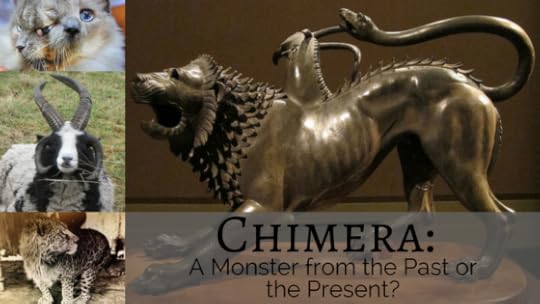 Disclaimer: This post features disturbing images and discusses some very controversial topics, so please proceed with caution.What comes to mind when you hear the word “Chimera?” A strange mythological monster? Or recent biological research?The first definition of a Chimera is “a fire-breathing she-monster in Greek mythology having a lion's head, a goat's body, and a serpent's tail” and “an imaginary monster compounded of incongruous parts.”There is another definition that refers to present-day science, but let’s start with the mythology and come back to the science in a minute.The Chimera is considered to be a female creature. Her father was the giant called Typhon and her mother was the half-serpent named Echidna. She had three monstrous brothers as well: Cerberus (Hell hound), Hydra (nine-headed water snake) and Orthrus (another multi-headed dog).It is also said that she was in love with Orthrus and that together they produced the Sphinx.What a messed-up family! How did all that happen?Now this is mythology, but all stories had to start with some element of truth. Before we speculate about what could be truth, let’s take a closer look at her story.Pseudo-Apollodorus said: "He [King Iobates of Lykia (Lycia)] ordered Bellerophon to slay the Chimera, assuming that he would instead be destroyed himself by the beast, since not even a quantity of men could subdue it with ease, let alone one. For it was a single being that had the force of three beasts, the front part of a lion, the tail of a drakon, and the third--middle--head was that of a goat, through which it breathed out fire. It despoiled the countryside and ravaged the herds....Bellerophon mounted Pegasus, his winged horse born of Medusa and Poseidon, and flying high into the air brought down the Chimera with his bow and arrows." (But a lot of art depicts a spear.)
Disclaimer: This post features disturbing images and discusses some very controversial topics, so please proceed with caution.What comes to mind when you hear the word “Chimera?” A strange mythological monster? Or recent biological research?The first definition of a Chimera is “a fire-breathing she-monster in Greek mythology having a lion's head, a goat's body, and a serpent's tail” and “an imaginary monster compounded of incongruous parts.”There is another definition that refers to present-day science, but let’s start with the mythology and come back to the science in a minute.The Chimera is considered to be a female creature. Her father was the giant called Typhon and her mother was the half-serpent named Echidna. She had three monstrous brothers as well: Cerberus (Hell hound), Hydra (nine-headed water snake) and Orthrus (another multi-headed dog).It is also said that she was in love with Orthrus and that together they produced the Sphinx.What a messed-up family! How did all that happen?Now this is mythology, but all stories had to start with some element of truth. Before we speculate about what could be truth, let’s take a closer look at her story.Pseudo-Apollodorus said: "He [King Iobates of Lykia (Lycia)] ordered Bellerophon to slay the Chimera, assuming that he would instead be destroyed himself by the beast, since not even a quantity of men could subdue it with ease, let alone one. For it was a single being that had the force of three beasts, the front part of a lion, the tail of a drakon, and the third--middle--head was that of a goat, through which it breathed out fire. It despoiled the countryside and ravaged the herds....Bellerophon mounted Pegasus, his winged horse born of Medusa and Poseidon, and flying high into the air brought down the Chimera with his bow and arrows." (But a lot of art depicts a spear.)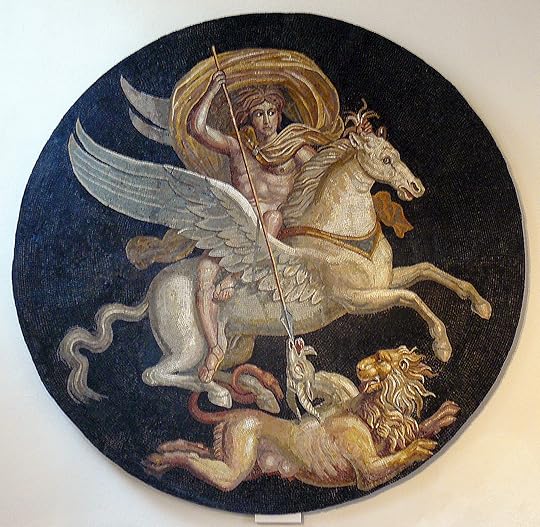 Some speculate that the Chimera creature is merely an imagined thing based on the volcano called Chimaera. Does this explain how the flame worked into the story?According to Pliny the Elder, "[In Lykia (Lycia) is] is Mount Chimaera, which sends forth flames at night…."So, Mrs. Chimera was roughly a lion with a serpent/dragon head and neck as its tail and a goat’s head in the middle. If someone made this up, I wonder what in the world they were smoking.But let’s say, for the sake of this discussion, that a Chimera creature really existed. What biological anomaly could have allowed the Chimera to have been a thing?Perhaps the least weird feature is the serpent/dragon head on the tail. So we’ll start with that one.Lions do have tufts on the ends of their tails that are shaped a bit like a snake’s head. Maybe this one had an abnormally large tail and/or a rather thick tuft of hair that really stood out and could have made an observer think it could be the head of another animal. Or maybe it had some kind of mass on the end of its tail. Ferrets can get masses on their tails called chondromas. Imagine a chondroma several times bigger than a ferret’s (more...lion-sized) and seen from a long distance.
Some speculate that the Chimera creature is merely an imagined thing based on the volcano called Chimaera. Does this explain how the flame worked into the story?According to Pliny the Elder, "[In Lykia (Lycia) is] is Mount Chimaera, which sends forth flames at night…."So, Mrs. Chimera was roughly a lion with a serpent/dragon head and neck as its tail and a goat’s head in the middle. If someone made this up, I wonder what in the world they were smoking.But let’s say, for the sake of this discussion, that a Chimera creature really existed. What biological anomaly could have allowed the Chimera to have been a thing?Perhaps the least weird feature is the serpent/dragon head on the tail. So we’ll start with that one.Lions do have tufts on the ends of their tails that are shaped a bit like a snake’s head. Maybe this one had an abnormally large tail and/or a rather thick tuft of hair that really stood out and could have made an observer think it could be the head of another animal. Or maybe it had some kind of mass on the end of its tail. Ferrets can get masses on their tails called chondromas. Imagine a chondroma several times bigger than a ferret’s (more...lion-sized) and seen from a long distance.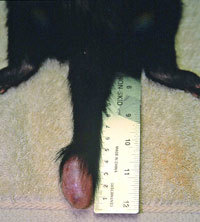 What if the mass was uncomfortable and the lion scratched at it a lot? Maybe making marks that could look like a mouth and eyes on it? Some skin masses are prone to bleeding easily, so what if it was covered in scabs that could have looked like a serpent face from far away? Something like that, with or without hair, could appear to be a snake head from a distance. And while the ancient writings that mention fire usually say that it comes from the goat's mouth, could a constantly-bleeding mass look a bit like fire? Ouch.And what if there was some animal out there with a really unusual genetic abnormality? I’m not suggesting (yet) that a lion actually sprouted a couple of extra heads from different species, but what if there were some congenital abnormalities that made it look like it had such features?There is speculation that the goat head originated from someone seeing a pair of wings from far away and, perhaps not having seen wings on such a beast before, mistaking them for a goat head. What if it was a griffin (assuming griffins may have existed) and it’s wings were malformed or had been broken during a fight, leaving what looked like a head with two horns sprouting from its back? The griffins were fierce, according to the histories, so maybe no one got close enough to see what was really there and lived to tell about it.Also, many animals have been known to be born with two heads. Few make it to adulthood, but it isn’t impossible.Is it possible for a lion to be born with two heads and live long enough to become an even more terrifying predator than a regular lion?Take a look at Frankenlouie, the two-headed cat who lived to be fifteen years old. This cat was born with a rare condition called craniofacial duplication. When the breeder saw him after he was born, he took him to the vet for euthanasia because animals with this condition don’t usually live past a few hours. Fortunately for Frankenlouie, one of the vet techs (yay, vet techs!) wanted to give him a chance and went on to tube feed him for the next three months, and care for him for the next fifteen years.
What if the mass was uncomfortable and the lion scratched at it a lot? Maybe making marks that could look like a mouth and eyes on it? Some skin masses are prone to bleeding easily, so what if it was covered in scabs that could have looked like a serpent face from far away? Something like that, with or without hair, could appear to be a snake head from a distance. And while the ancient writings that mention fire usually say that it comes from the goat's mouth, could a constantly-bleeding mass look a bit like fire? Ouch.And what if there was some animal out there with a really unusual genetic abnormality? I’m not suggesting (yet) that a lion actually sprouted a couple of extra heads from different species, but what if there were some congenital abnormalities that made it look like it had such features?There is speculation that the goat head originated from someone seeing a pair of wings from far away and, perhaps not having seen wings on such a beast before, mistaking them for a goat head. What if it was a griffin (assuming griffins may have existed) and it’s wings were malformed or had been broken during a fight, leaving what looked like a head with two horns sprouting from its back? The griffins were fierce, according to the histories, so maybe no one got close enough to see what was really there and lived to tell about it.Also, many animals have been known to be born with two heads. Few make it to adulthood, but it isn’t impossible.Is it possible for a lion to be born with two heads and live long enough to become an even more terrifying predator than a regular lion?Take a look at Frankenlouie, the two-headed cat who lived to be fifteen years old. This cat was born with a rare condition called craniofacial duplication. When the breeder saw him after he was born, he took him to the vet for euthanasia because animals with this condition don’t usually live past a few hours. Fortunately for Frankenlouie, one of the vet techs (yay, vet techs!) wanted to give him a chance and went on to tube feed him for the next three months, and care for him for the next fifteen years.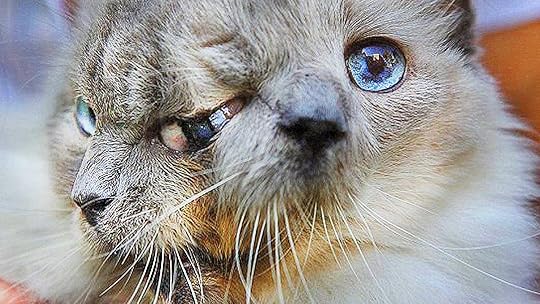 Craniofacial duplication is a disease in which cells keep splitting for longer than they’re supposed to during a very early stage of development. As a result, Frankenlouie had two faces. He had three eyes altogether but could only see from the outside two, and he had two noses and two mouths. One of the faces lacked a lower jaw and functional esophagus, so he could only eat from one side. But this guy lived to be fifteen years old! That’s a decent age for a perfectly normal cat. Even more epic is the story of Abby and Brittany Hensel, conjoined twin humans born in 1990. They each have their own head, neck, heart, lungs, and stomach. And one arm each. But they share everything from the waist down. Because they shared so many organs, separation was not deemed a viable option. But they are still around living as normal a life as they can 28 years later.
Craniofacial duplication is a disease in which cells keep splitting for longer than they’re supposed to during a very early stage of development. As a result, Frankenlouie had two faces. He had three eyes altogether but could only see from the outside two, and he had two noses and two mouths. One of the faces lacked a lower jaw and functional esophagus, so he could only eat from one side. But this guy lived to be fifteen years old! That’s a decent age for a perfectly normal cat. Even more epic is the story of Abby and Brittany Hensel, conjoined twin humans born in 1990. They each have their own head, neck, heart, lungs, and stomach. And one arm each. But they share everything from the waist down. Because they shared so many organs, separation was not deemed a viable option. But they are still around living as normal a life as they can 28 years later. Given these examples, does it seem somewhat possible that a lion could have survived having an extra head deformed in such a way as to resemble a goat, and a tail deformity that could have resembled the head of a serpent or dragon?Say a lion was born with two lion heads and somehow miraculously made it to adulthood. Say one head was deformed. Lacking a mane would make it look skinnier, possibly more goat-like. As for the horns… Maybe deformed ears? It’s a bit of a long shot, but anything is possible.But could the middle head have really been a goat head?Unlikely of course, but let’s take a look at the possibilities.There are several hybrid species that are able to live to adulthood, though they are not able to reproduce. A mule is a common example of this. It is a cross between a horse and a donkey and is able to live a normal life, other than being sterile. But generally, a pair of animals have to be fairly close genetically to make this happen. Have a look a the Geep, Lyger, Leopon, Zonkey, and Zorse to name a few.
Given these examples, does it seem somewhat possible that a lion could have survived having an extra head deformed in such a way as to resemble a goat, and a tail deformity that could have resembled the head of a serpent or dragon?Say a lion was born with two lion heads and somehow miraculously made it to adulthood. Say one head was deformed. Lacking a mane would make it look skinnier, possibly more goat-like. As for the horns… Maybe deformed ears? It’s a bit of a long shot, but anything is possible.But could the middle head have really been a goat head?Unlikely of course, but let’s take a look at the possibilities.There are several hybrid species that are able to live to adulthood, though they are not able to reproduce. A mule is a common example of this. It is a cross between a horse and a donkey and is able to live a normal life, other than being sterile. But generally, a pair of animals have to be fairly close genetically to make this happen. Have a look a the Geep, Lyger, Leopon, Zonkey, and Zorse to name a few.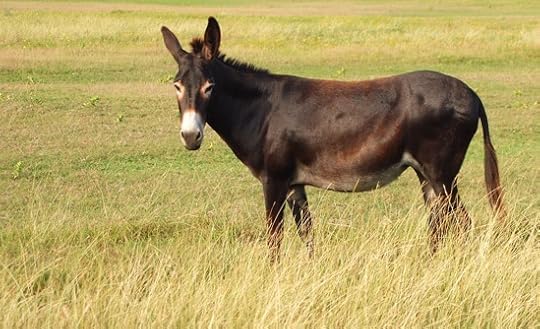
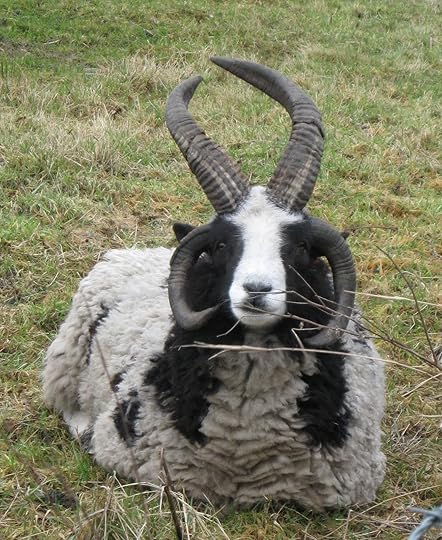
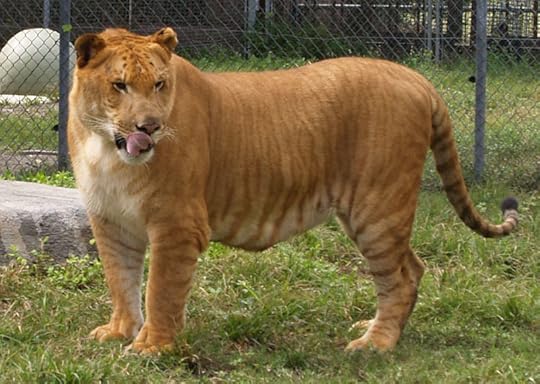
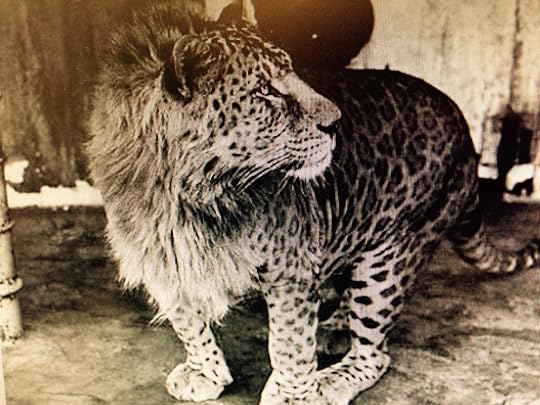
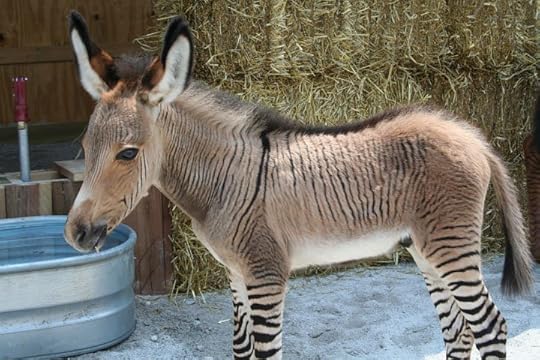
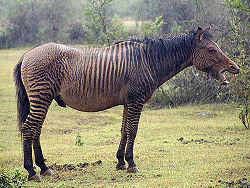 Each pair of animals that resulted in these hybrids were very genetically similar, much more similar than a goat and a lion. But could a goat and a lion have mated to produce a deformed lion-goat mix? Once again, I certainly don’t think this is likely. But is it impossible?There have been a number of animals born with defects that make them appear to have human characteristics. Mostly goats like the ones pictured below.
Each pair of animals that resulted in these hybrids were very genetically similar, much more similar than a goat and a lion. But could a goat and a lion have mated to produce a deformed lion-goat mix? Once again, I certainly don’t think this is likely. But is it impossible?There have been a number of animals born with defects that make them appear to have human characteristics. Mostly goats like the ones pictured below.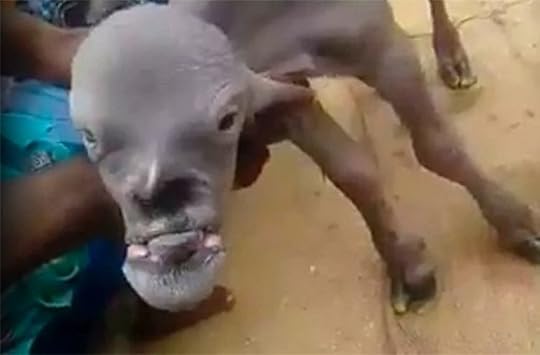


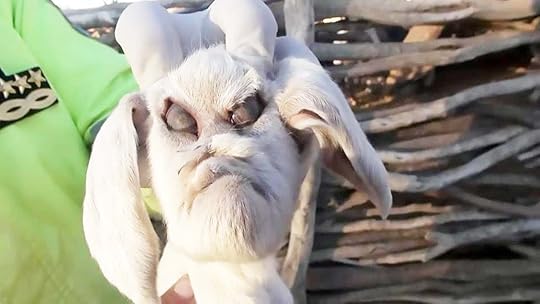 Of the one that is shaped like a human baby, some have said that it looks like a faun (the mythical creature with a human head and torso and legs of a goat) and some claim it looks more like a Sasquatch. But with each of these examples, the question of unnatural interaction between a human and an animal has been raised as a possibility.I’m not going to go into that one, but if it is possible for those genes to be mixed to produce a human-animal hybrid, it seems slightly less ridiculous to allow the possibility of a hybrid between two animals with very little genetic similarity, such as a lion and a goat.I’m not saying that I think this is what happened to produce the monster that inspired the Chimera stories and artwork. I’m sure there's a one in a gazillion chance that members of two different species could produce viable offspring with a head from each and a tail with a mass that happened to resemble a serpent/dragon head. My job is just to present what biological and genetic possibilities exist and speculate on how they might have had a hand in some weird situations. Because as I said, all stories are inspired by something. Even if the Chimera is a purely mythological creature, someone had to get the idea for it from somewhere.Now, let’s go on to the other chimera definition: “an individual, organ, or part consisting of tissues of diverse genetic constitution.”This refers to human-animal hybrids being made in labs for medical research, which is a very controversial topic, to say the least. In January of 2017, it was announced that scientists had made the first human-pig hybrid embryo. About 2,000 hybrid embryos were made and placed in surrogate sows. The embryos were only allowed to mature for 28 days—the length of time for the first trimester in porcine pregnancy—and were then removed for study. These experiments are only the beginning in a long process, the end goal of which is the ability to grow human organs in animals’ bodies for use in organ transplantation, and for more effective testing of new medicines. In 2016, Japanese scientists grew human ears on the backs of lab rats. They were able to grow full-sized human ears that were not only the right shape, but also made of cartilage with the correct flexibility. This might raise slightly less serious ethical concerns than the human-pig hybrids, but is still a concern for animal health and well-being.
Of the one that is shaped like a human baby, some have said that it looks like a faun (the mythical creature with a human head and torso and legs of a goat) and some claim it looks more like a Sasquatch. But with each of these examples, the question of unnatural interaction between a human and an animal has been raised as a possibility.I’m not going to go into that one, but if it is possible for those genes to be mixed to produce a human-animal hybrid, it seems slightly less ridiculous to allow the possibility of a hybrid between two animals with very little genetic similarity, such as a lion and a goat.I’m not saying that I think this is what happened to produce the monster that inspired the Chimera stories and artwork. I’m sure there's a one in a gazillion chance that members of two different species could produce viable offspring with a head from each and a tail with a mass that happened to resemble a serpent/dragon head. My job is just to present what biological and genetic possibilities exist and speculate on how they might have had a hand in some weird situations. Because as I said, all stories are inspired by something. Even if the Chimera is a purely mythological creature, someone had to get the idea for it from somewhere.Now, let’s go on to the other chimera definition: “an individual, organ, or part consisting of tissues of diverse genetic constitution.”This refers to human-animal hybrids being made in labs for medical research, which is a very controversial topic, to say the least. In January of 2017, it was announced that scientists had made the first human-pig hybrid embryo. About 2,000 hybrid embryos were made and placed in surrogate sows. The embryos were only allowed to mature for 28 days—the length of time for the first trimester in porcine pregnancy—and were then removed for study. These experiments are only the beginning in a long process, the end goal of which is the ability to grow human organs in animals’ bodies for use in organ transplantation, and for more effective testing of new medicines. In 2016, Japanese scientists grew human ears on the backs of lab rats. They were able to grow full-sized human ears that were not only the right shape, but also made of cartilage with the correct flexibility. This might raise slightly less serious ethical concerns than the human-pig hybrids, but is still a concern for animal health and well-being. Now for the big question: Should scientists be creating human-animal hybrids?There is definitely an advantage to being able to grow organs and have them ready to replace for someone with cancer or a horrible injury or genetic deformity. Then a patient wouldn’t have to wait for there to be an organ available from a donor, and it would be easier to find something that is the perfect match for someone. But what if we are killing a sentient being to get those organs? It’s one thing to take the organs of a person who has passed away and no longer needs them. But its another thing to kill a being with some level of sentients. What kind of life would that be for a creature with a somewhat humanoid intellect?And to go even deeper, do humans have souls? I believe we do. Whether you agree or not, walk with me for a second. Say that humans, conceived naturally, all have a soul that lives on when the body dies. So then what about a clone? Would a clone of a human have a soul? And then what about a genetic hybrid between a human and an animal? Do animals have souls? Can you have a hybrid of a human and animal soul? What if animals don’t have souls? Can you have a hybrid with half a soul? A warped soul? No soul at all? How intelligent can it be then? Whether it has any sentients at all, even animals have emotions and pain receptors.Lab animal research is one thing. And we wouldn’t have migraine medicine, or cancer treatments, or flea prevention for our pets without it. And research on humans that is done on adults who volunteer and consent to everything involved is another thing. But creating a somewhat sentient creature that has the potential to have human thoughts, only to be experimented on and eventually euthanized…is that type of chimera something that should be supported?In Recent MediaOn a lighter note, House of the Scorpion by Nancy Farmer is an excellent story about what could happen with human clones. What if a rich man could have a clone of himself made every few decades, continually taking new body parts from them as needed, until he was even outliving his grandchildren? This book follows the life of his last clone, and what the clone does when he finds out what he is. It's great story and I definitely recommend it.As for movies and books about chimeras, I didn’t know of any before researching this topic. There are actually quite a lot of books and a couple of movies, but not nearly as many as there are on the topic of cloning.Have you read or watched something about cloning or chimeras (either mythological or present-day)? Tell me about it in the comments!Creative CornerAll these genetic possibilities are perhaps a bit less disturbing to explore through fiction than in reality. Maybe heading a little more into scifi, but these topics could definitely still be used in fantasy.There’s always the trope of the science experiment gone wrong, which can be done really well, though it's been done many times. But what about a science experiment gone right? While of course something would have to go wrong for there to be a plot, it could be something other than the experiment result itself. It could be something inhibiting the experiment, or someone sabotaging the genetic code or something like that.What kind of hybrids could be really cool, at least in fiction?And here’s an idea for you. What if science could actually make centaurs or fauns? Or griffins? What if the reason we have so many human-animal hybrids in mythology is because science manages to make them in the future, along with time machines, and then everything goes wrong and the scientists send them back in time to get rid of them? Now there’s a story I want to read! Someone please write that!Please feel free to share your thoughts on this topic! But please be kind and respectful to people with a different opinion than yourself.And thanks to Holly Davis for requesting this topic! I’m sorry if I went way off track with the science side of this one, Holly. :)If you would like to request a fantasy creature topic, join my mailing list and be eligible to enter your fantasy animal request for a chance to win an amazon gift card! There is a giveaway in my newsletter every month! The next chance to win will be March 6th. Join now to receive that newsletter with your chance to win!Happy reading and writing to you all!
Now for the big question: Should scientists be creating human-animal hybrids?There is definitely an advantage to being able to grow organs and have them ready to replace for someone with cancer or a horrible injury or genetic deformity. Then a patient wouldn’t have to wait for there to be an organ available from a donor, and it would be easier to find something that is the perfect match for someone. But what if we are killing a sentient being to get those organs? It’s one thing to take the organs of a person who has passed away and no longer needs them. But its another thing to kill a being with some level of sentients. What kind of life would that be for a creature with a somewhat humanoid intellect?And to go even deeper, do humans have souls? I believe we do. Whether you agree or not, walk with me for a second. Say that humans, conceived naturally, all have a soul that lives on when the body dies. So then what about a clone? Would a clone of a human have a soul? And then what about a genetic hybrid between a human and an animal? Do animals have souls? Can you have a hybrid of a human and animal soul? What if animals don’t have souls? Can you have a hybrid with half a soul? A warped soul? No soul at all? How intelligent can it be then? Whether it has any sentients at all, even animals have emotions and pain receptors.Lab animal research is one thing. And we wouldn’t have migraine medicine, or cancer treatments, or flea prevention for our pets without it. And research on humans that is done on adults who volunteer and consent to everything involved is another thing. But creating a somewhat sentient creature that has the potential to have human thoughts, only to be experimented on and eventually euthanized…is that type of chimera something that should be supported?In Recent MediaOn a lighter note, House of the Scorpion by Nancy Farmer is an excellent story about what could happen with human clones. What if a rich man could have a clone of himself made every few decades, continually taking new body parts from them as needed, until he was even outliving his grandchildren? This book follows the life of his last clone, and what the clone does when he finds out what he is. It's great story and I definitely recommend it.As for movies and books about chimeras, I didn’t know of any before researching this topic. There are actually quite a lot of books and a couple of movies, but not nearly as many as there are on the topic of cloning.Have you read or watched something about cloning or chimeras (either mythological or present-day)? Tell me about it in the comments!Creative CornerAll these genetic possibilities are perhaps a bit less disturbing to explore through fiction than in reality. Maybe heading a little more into scifi, but these topics could definitely still be used in fantasy.There’s always the trope of the science experiment gone wrong, which can be done really well, though it's been done many times. But what about a science experiment gone right? While of course something would have to go wrong for there to be a plot, it could be something other than the experiment result itself. It could be something inhibiting the experiment, or someone sabotaging the genetic code or something like that.What kind of hybrids could be really cool, at least in fiction?And here’s an idea for you. What if science could actually make centaurs or fauns? Or griffins? What if the reason we have so many human-animal hybrids in mythology is because science manages to make them in the future, along with time machines, and then everything goes wrong and the scientists send them back in time to get rid of them? Now there’s a story I want to read! Someone please write that!Please feel free to share your thoughts on this topic! But please be kind and respectful to people with a different opinion than yourself.And thanks to Holly Davis for requesting this topic! I’m sorry if I went way off track with the science side of this one, Holly. :)If you would like to request a fantasy creature topic, join my mailing list and be eligible to enter your fantasy animal request for a chance to win an amazon gift card! There is a giveaway in my newsletter every month! The next chance to win will be March 6th. Join now to receive that newsletter with your chance to win!Happy reading and writing to you all!
Published on February 20, 2018 02:55
February 6, 2018
The Phoenix: a Creature of Fire and Ashes…and Parthenogenesis?
 A popular symbol for rebirth, the legendary Phoenix has made its way into many books and movies throughout the world. While most of its legends are based on Greek and Roman culture, there are other cultures with similar creatures. From Egypt to Persia, Russia to China, many cultures have some version of a bird-like animal reminiscent of the Greek Phoenix. While they don’t all have the exact same things in common, what if some of the unique characteristics between birds from different places complement each other? What if together these different cultural aspects of this bird point to an amazing—but entirely real—biological phenomenon? What if there really was a species of bird that was “reborn from it’s ashes?”Let’s take a quick look at a few Phoenix-like legends from around the world, then we’ll dive into the details of the Greek and Roman Phoenix and the exciting scientific possibilities they point to together.Similar to the Greek Phoenix, the Egyptian “Bennu” is also a symbol of rebirth and sacrifice. The tallest and most heron-like of our Phoenix-esque creatures, the Bennu had red and gold plumage with two long feathers on his head. He was considered the heart and soul of Ra, the Egyptian sun god who was reborn every day after sailing across the sky as the sun.
A popular symbol for rebirth, the legendary Phoenix has made its way into many books and movies throughout the world. While most of its legends are based on Greek and Roman culture, there are other cultures with similar creatures. From Egypt to Persia, Russia to China, many cultures have some version of a bird-like animal reminiscent of the Greek Phoenix. While they don’t all have the exact same things in common, what if some of the unique characteristics between birds from different places complement each other? What if together these different cultural aspects of this bird point to an amazing—but entirely real—biological phenomenon? What if there really was a species of bird that was “reborn from it’s ashes?”Let’s take a quick look at a few Phoenix-like legends from around the world, then we’ll dive into the details of the Greek and Roman Phoenix and the exciting scientific possibilities they point to together.Similar to the Greek Phoenix, the Egyptian “Bennu” is also a symbol of rebirth and sacrifice. The tallest and most heron-like of our Phoenix-esque creatures, the Bennu had red and gold plumage with two long feathers on his head. He was considered the heart and soul of Ra, the Egyptian sun god who was reborn every day after sailing across the sky as the sun.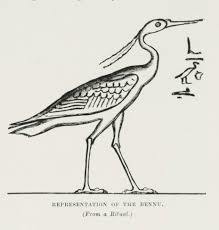 Interestingly, the world’s largest heron currently lives in Africa and has reddish plumage. But his horrible voice is a strike against his similarity to the Phoenix. We’ll come back to that.
Interestingly, the world’s largest heron currently lives in Africa and has reddish plumage. But his horrible voice is a strike against his similarity to the Phoenix. We’ll come back to that.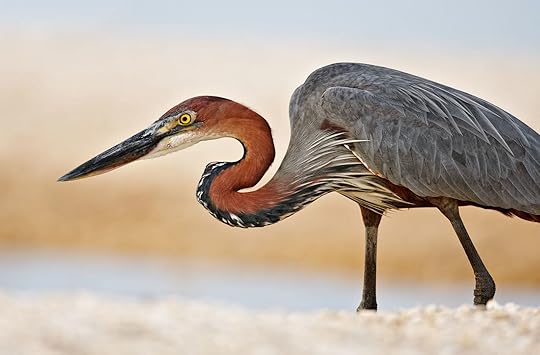 The Hou-ou, a Japanese phoenix-like bird, is not a symbol of rebirth but instead represents feminine royalty, as of a queen or an empress. It also represents justice and fidelity. This bird appears on rare occasions such as for the birth of a ruler. It will only come during a time of peace, stability and prosperity. It’s absence is a symbol of disharmony.This bird is like the Chinese dragon in that it’s made up of several parts of different animals. The jaw of a swallow, the neck of a snake, the front half of a giraffe, and the back of a deer, though it is also pictured as a peacock-like bird. The first description does conjure up a very different image than the type of Phoenix we might expect, but focus on what it symbolizes.
The Hou-ou, a Japanese phoenix-like bird, is not a symbol of rebirth but instead represents feminine royalty, as of a queen or an empress. It also represents justice and fidelity. This bird appears on rare occasions such as for the birth of a ruler. It will only come during a time of peace, stability and prosperity. It’s absence is a symbol of disharmony.This bird is like the Chinese dragon in that it’s made up of several parts of different animals. The jaw of a swallow, the neck of a snake, the front half of a giraffe, and the back of a deer, though it is also pictured as a peacock-like bird. The first description does conjure up a very different image than the type of Phoenix we might expect, but focus on what it symbolizes.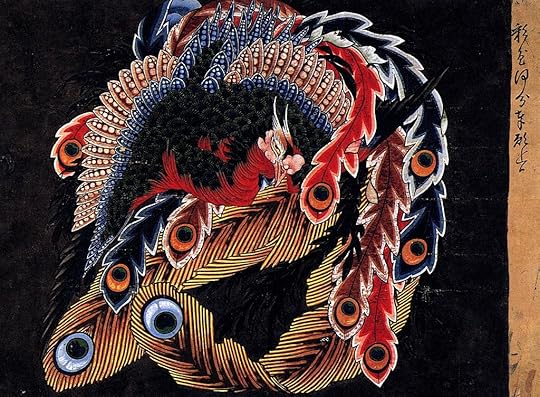 In Chinese culture, there are two birds similar to the Phoenix: one called the Feng-Huang, and one called the Vermilion Bird. The Feng-Huang is the fusion of male and female characteristics. It was originally depicted as two separate birds, but is now considered to be just a single creature and is usually visualized as feminine. The Erya, the oldest Chinese encyclopedia, says that it is made up of the head of a swallow, the beak of a rooster, the neck of a snake, the back of a tortoise, and tail of a fish, though it, too, is pictured as a peacock-like animal as well.
In Chinese culture, there are two birds similar to the Phoenix: one called the Feng-Huang, and one called the Vermilion Bird. The Feng-Huang is the fusion of male and female characteristics. It was originally depicted as two separate birds, but is now considered to be just a single creature and is usually visualized as feminine. The Erya, the oldest Chinese encyclopedia, says that it is made up of the head of a swallow, the beak of a rooster, the neck of a snake, the back of a tortoise, and tail of a fish, though it, too, is pictured as a peacock-like animal as well. During the Han dynasty, the Feng-Huang represented powers given by a god to the empress. Another bird that only appeared during times of peace, this one is a symbol of eternal love, merit, and grace, instead of self-sacrifice or rebirth.The second Chinese bird, the Vermilion Bird, is a bit more like the Greek Phoenix. It had red plumage and represented summertime, the south, and good luck. But there is no mention of this one bursting into flames to be reborn.
During the Han dynasty, the Feng-Huang represented powers given by a god to the empress. Another bird that only appeared during times of peace, this one is a symbol of eternal love, merit, and grace, instead of self-sacrifice or rebirth.The second Chinese bird, the Vermilion Bird, is a bit more like the Greek Phoenix. It had red plumage and represented summertime, the south, and good luck. But there is no mention of this one bursting into flames to be reborn. Persia also has two birds instead of one: the Huma and the Simurgh. The Huma flies constantly and is never visible to humans. It’s also called the bird of paradise. Some say it never lands because it has no limbs. It is believed to live forever, acquiring a new body through fire every few hundred years. It is not possible to kill it, and attempting to kill it would mean instant death. It represents fullness through both male and female traits.
Persia also has two birds instead of one: the Huma and the Simurgh. The Huma flies constantly and is never visible to humans. It’s also called the bird of paradise. Some say it never lands because it has no limbs. It is believed to live forever, acquiring a new body through fire every few hundred years. It is not possible to kill it, and attempting to kill it would mean instant death. It represents fullness through both male and female traits. The Simurgh has the head of a human or dog, the claws of a lion, and the body of a peacock. It represents wit or loyalty, depending on the head, and it is always courageous, beautiful, benevolent and motherly. Every seventeen hundred years it is immersed in flame and rises anew from the ashes. It represents resurgence, purity and fertility.
The Simurgh has the head of a human or dog, the claws of a lion, and the body of a peacock. It represents wit or loyalty, depending on the head, and it is always courageous, beautiful, benevolent and motherly. Every seventeen hundred years it is immersed in flame and rises anew from the ashes. It represents resurgence, purity and fertility.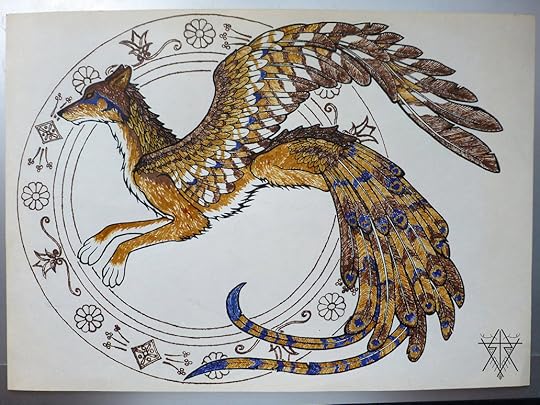 The Russian version is called the Zhar-Ptitsa which means firebird. It is said to come from a far-away land, bringing joy and peace to good people and sorrow to captors and masters. If someone tried to catch it in order to force it to provide prosperity, it would bring their doom instead. It also had majestic glowing feathers, but there is no mention of fire or rebirth.
The Russian version is called the Zhar-Ptitsa which means firebird. It is said to come from a far-away land, bringing joy and peace to good people and sorrow to captors and masters. If someone tried to catch it in order to force it to provide prosperity, it would bring their doom instead. It also had majestic glowing feathers, but there is no mention of fire or rebirth.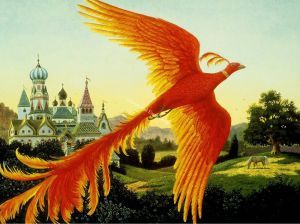 And that brings us to the most familiar version, though the Egyptian version was probably the original. The Greek and Roman Phoenix is a peacock or eagle, with red and gold feathers. The Greek word for Phoenix means "red palm tree," in reference to its palm tree-like plumage. According to the mythology, it liked to nest near a well, and every day at dawn it would bathe in the well and sing. Its song was so lovely that the Greek sun god Helios would stop his chariot to listen (strike against the currently-living Goliath heron whose voice is not so pretty). Only one of these birds could be alive at a time. When it began to feel old, it intentionally burst into flame and burned up, and a new bird was born from the ashes. Thus the Phoenix symbolizes self-sacrifice and rebirth.
And that brings us to the most familiar version, though the Egyptian version was probably the original. The Greek and Roman Phoenix is a peacock or eagle, with red and gold feathers. The Greek word for Phoenix means "red palm tree," in reference to its palm tree-like plumage. According to the mythology, it liked to nest near a well, and every day at dawn it would bathe in the well and sing. Its song was so lovely that the Greek sun god Helios would stop his chariot to listen (strike against the currently-living Goliath heron whose voice is not so pretty). Only one of these birds could be alive at a time. When it began to feel old, it intentionally burst into flame and burned up, and a new bird was born from the ashes. Thus the Phoenix symbolizes self-sacrifice and rebirth. Herodotus, the Greek historian who wrote about griffin sightings, wrote this about his visit to Egypt: "There is another sacred bird, too, whose name is Phoinix (Phoenix)....It is said that the Phoinix comes when his father dies. If the picture truly shows his size and appearance, his plumage is partly golden and partly red. He is most like an eagle in shape and size."The Roman poet Ovid had this to say of the creature: "But one alone, a bird, renews and re-begets itself--the Phoenix of Assyria...This bird, when five long centuries of life have passed, with claws and beak unsullied, builds a nest high on a lofty swaying palm; and lines the nest with cassia and spikenard and golden myrrh and shreds of cinnamon, and settled there at ease and, so embowered in spicy perfumes, ends his life's long span. Then from his father's body is reborn a little Phoenix, so they say, to live the same long years..."While each of these mythical birds is described a bit differently, they bear many similarities. Many of them have rich red and gold plumage, have to do with the sun, and sing beautifully. While they are not all considered to represent rebirth, what if these strange birds were capable of a unique type of reproduction? What if each of these birds from different legends from different cultures were the same or similar species of birds capable of the same unique ability? What if they only look like different things because each culture valued a different aspect of them and so forgot the other things?What kind of unique reproduction could I be talking about, you ask?Parthenogenesis.Parthenogenesis is defined as: “cell division in a female gamete without any genetic contribution from the male” and comes from the Greek words parthos, meaning "virgin," and genesis, meaning "origin."Did you know that there are some animals capable of reproducing without a male? There are even some species that reproduce exclusively through parthenogenesis. These species are made up entirely of female members.One example of this is the mourning gecko. Each member of the species is female, and each hatchling is a perfect clone of the mother.
Herodotus, the Greek historian who wrote about griffin sightings, wrote this about his visit to Egypt: "There is another sacred bird, too, whose name is Phoinix (Phoenix)....It is said that the Phoinix comes when his father dies. If the picture truly shows his size and appearance, his plumage is partly golden and partly red. He is most like an eagle in shape and size."The Roman poet Ovid had this to say of the creature: "But one alone, a bird, renews and re-begets itself--the Phoenix of Assyria...This bird, when five long centuries of life have passed, with claws and beak unsullied, builds a nest high on a lofty swaying palm; and lines the nest with cassia and spikenard and golden myrrh and shreds of cinnamon, and settled there at ease and, so embowered in spicy perfumes, ends his life's long span. Then from his father's body is reborn a little Phoenix, so they say, to live the same long years..."While each of these mythical birds is described a bit differently, they bear many similarities. Many of them have rich red and gold plumage, have to do with the sun, and sing beautifully. While they are not all considered to represent rebirth, what if these strange birds were capable of a unique type of reproduction? What if each of these birds from different legends from different cultures were the same or similar species of birds capable of the same unique ability? What if they only look like different things because each culture valued a different aspect of them and so forgot the other things?What kind of unique reproduction could I be talking about, you ask?Parthenogenesis.Parthenogenesis is defined as: “cell division in a female gamete without any genetic contribution from the male” and comes from the Greek words parthos, meaning "virgin," and genesis, meaning "origin."Did you know that there are some animals capable of reproducing without a male? There are even some species that reproduce exclusively through parthenogenesis. These species are made up entirely of female members.One example of this is the mourning gecko. Each member of the species is female, and each hatchling is a perfect clone of the mother. There’s a range of different types of parthenogenesis, but interestingly even some very large animals are capable of it. It’s even been seen in two female Komodo Dragons in a couple of zoos in Europe.
There’s a range of different types of parthenogenesis, but interestingly even some very large animals are capable of it. It’s even been seen in two female Komodo Dragons in a couple of zoos in Europe. People might try to dispute this by stating that many species of female lizards hold onto sperm indefinitely and may produce offspring long after mating. This is true, but one of these lizards hadn’t been with a male in 2.5 years, and the other had never been with a male at all. So how could this be possible? What if someone was careless and one day the male got in the cage with the female and bada bing, bada boom, baby dragons?But the zoos considered this as well, so they did genetic tests on the offspring. They found that their genetic codes, while not perfect clones of their mothers because of how the chromosomes work in this type of parthenogenesis, were not different enough from their mother's for a father to have been involved. The father would’ve had to be genetically identical to the mother to produce those particular offspring.In the human (and many animal) genetic makeup, sex is determined through the X and Y chromosomes. XX will produce a female and XY will produce a male. But it is the opposite in Komodo dragons: two of the same sex chromosomes for the male and two different ones for the female. These have been assigned different letters: ZZ for male and WZ for female. So each egg from a female has either a W or a Z, and when they reproduce parthenogenically, those genes get doubled. This results in offspring that are either WW or ZZ. Unfortunately, WW’s are not viable and die early on. But ZZ’s are normal males. So with that in mind, consider this. The Egyptian Bennu, the Persian Huma and Simurgh, and the Greek and Roman Phoenix are each said to perish in fire and either be reborn or have an offspring produced from the ashes. The Japanese Hou-ou, the Chinese Feng-Huang, and both Persian examples, each either represent feminine qualities or the combination of feminine and masculine qualities in one body.Could both of these things be references to parthenogenesis?Despite our thoughts of Fawkes, the phoenix from Harry Potter, many of the ancient tales about the actual phoenix indicate that the reborn phoenix is not the same as the one that died. The one grows old and ignites, then another—different—one emerges from the ashes.Parthenogenesis has also been seen in chickens and turkeys. If this phenomenon is possible now, what if there was a bird who could replicate itself without sexual reproduction?What if it was through observing this phenomenon that the people of ancient cultures formed the ideas and legends that led to our current understanding of this amazing creature?But what about the fire? Besides erupting in flame at the end of their lives, they supposedly glowed like the sun and had feathers like fire. There are many animals today--including some birds--that are bioluminescent. Such as hummingbirds or pigeons. while their shimmer might be green or purple, imagine what an all red and gold bioluminescent bird would look like under the sun?They have even found fossils of bioluminescent feathers. These particular feathers shimmered greenish-black, so they probably weren't Phoenix feathers. But maybe someone will discover fossilized bioluminescent red and gold feathers some day.So what do you think? Do you have another hypothesis? Do you think my ideas are crazy? Tell me about it in the comments!In Recent MediaThe first phoenix of recent(ish) media I think of is Fawkes, the phoenix in Dumbledore’s office. He was first mentioned in Harry Potter and the Sorcerer’s Stone. In Harry Potter and the Chamber of Secrets, he delivered the sorting hat and the diary to Harry in the chamber and then pecked out the basilisk’s eyes so that no one else could be frozen. In the fifth book, which is also my favorite one, the Order of the Phoenix is named after him. Later on in the series, Fawkes teleported Dumbledore away before idiots could snag him for Azkaban.
People might try to dispute this by stating that many species of female lizards hold onto sperm indefinitely and may produce offspring long after mating. This is true, but one of these lizards hadn’t been with a male in 2.5 years, and the other had never been with a male at all. So how could this be possible? What if someone was careless and one day the male got in the cage with the female and bada bing, bada boom, baby dragons?But the zoos considered this as well, so they did genetic tests on the offspring. They found that their genetic codes, while not perfect clones of their mothers because of how the chromosomes work in this type of parthenogenesis, were not different enough from their mother's for a father to have been involved. The father would’ve had to be genetically identical to the mother to produce those particular offspring.In the human (and many animal) genetic makeup, sex is determined through the X and Y chromosomes. XX will produce a female and XY will produce a male. But it is the opposite in Komodo dragons: two of the same sex chromosomes for the male and two different ones for the female. These have been assigned different letters: ZZ for male and WZ for female. So each egg from a female has either a W or a Z, and when they reproduce parthenogenically, those genes get doubled. This results in offspring that are either WW or ZZ. Unfortunately, WW’s are not viable and die early on. But ZZ’s are normal males. So with that in mind, consider this. The Egyptian Bennu, the Persian Huma and Simurgh, and the Greek and Roman Phoenix are each said to perish in fire and either be reborn or have an offspring produced from the ashes. The Japanese Hou-ou, the Chinese Feng-Huang, and both Persian examples, each either represent feminine qualities or the combination of feminine and masculine qualities in one body.Could both of these things be references to parthenogenesis?Despite our thoughts of Fawkes, the phoenix from Harry Potter, many of the ancient tales about the actual phoenix indicate that the reborn phoenix is not the same as the one that died. The one grows old and ignites, then another—different—one emerges from the ashes.Parthenogenesis has also been seen in chickens and turkeys. If this phenomenon is possible now, what if there was a bird who could replicate itself without sexual reproduction?What if it was through observing this phenomenon that the people of ancient cultures formed the ideas and legends that led to our current understanding of this amazing creature?But what about the fire? Besides erupting in flame at the end of their lives, they supposedly glowed like the sun and had feathers like fire. There are many animals today--including some birds--that are bioluminescent. Such as hummingbirds or pigeons. while their shimmer might be green or purple, imagine what an all red and gold bioluminescent bird would look like under the sun?They have even found fossils of bioluminescent feathers. These particular feathers shimmered greenish-black, so they probably weren't Phoenix feathers. But maybe someone will discover fossilized bioluminescent red and gold feathers some day.So what do you think? Do you have another hypothesis? Do you think my ideas are crazy? Tell me about it in the comments!In Recent MediaThe first phoenix of recent(ish) media I think of is Fawkes, the phoenix in Dumbledore’s office. He was first mentioned in Harry Potter and the Sorcerer’s Stone. In Harry Potter and the Chamber of Secrets, he delivered the sorting hat and the diary to Harry in the chamber and then pecked out the basilisk’s eyes so that no one else could be frozen. In the fifth book, which is also my favorite one, the Order of the Phoenix is named after him. Later on in the series, Fawkes teleported Dumbledore away before idiots could snag him for Azkaban. There’s also a firebird in the Grisha Trilogy by Leigh Bardugo. It is never called a Phoenix, and is likely based on the Russian firebird, judging by the author’s preference for Russian themes in her books.
There’s also a firebird in the Grisha Trilogy by Leigh Bardugo. It is never called a Phoenix, and is likely based on the Russian firebird, judging by the author’s preference for Russian themes in her books.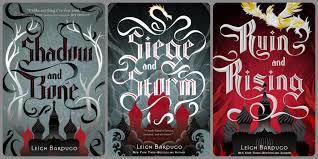 What’s your favorite fictional Phoenix? Tell me about it in the comments!Creative CornerIf it only comes around during times of peace and prosperity, what about a story where they haven’t seen the Phoenix in years, and a child wishes that the world would be at peace so that he could see this legendary creature. Or what if it was last seen at the birth of the king, and the king is about to have a grandson and wishes that the bird would be present to bless the birth. He tries extra hard to make the kingdom peaceful around that time.People want to catch it to force it to bring them joy. Perhaps a bad guy’s back story could be that he wanted to bring joy to himself or a loved one, so he cleverly trapped the firebird. But it was angry at being caught and ruined his life. Perhaps he spends his life trying to get revenge on the bird, or on someone who told him it was a bad idea. That could be how he becomes a bad guy.And parthenogenesis is a whole other issue in itself! There are so many things a fantasy author could do with that one. I’ve actually got a parthenogenic species in my fantasy trilogy as well! More coming about them in the third book.What do you think of parthenogenesis? Could it have anything to do with the legends of the Phoenix? Have you used Phoenixes or Parthenogenesis in any of your writings? I’d love to hear about it!
What’s your favorite fictional Phoenix? Tell me about it in the comments!Creative CornerIf it only comes around during times of peace and prosperity, what about a story where they haven’t seen the Phoenix in years, and a child wishes that the world would be at peace so that he could see this legendary creature. Or what if it was last seen at the birth of the king, and the king is about to have a grandson and wishes that the bird would be present to bless the birth. He tries extra hard to make the kingdom peaceful around that time.People want to catch it to force it to bring them joy. Perhaps a bad guy’s back story could be that he wanted to bring joy to himself or a loved one, so he cleverly trapped the firebird. But it was angry at being caught and ruined his life. Perhaps he spends his life trying to get revenge on the bird, or on someone who told him it was a bad idea. That could be how he becomes a bad guy.And parthenogenesis is a whole other issue in itself! There are so many things a fantasy author could do with that one. I’ve actually got a parthenogenic species in my fantasy trilogy as well! More coming about them in the third book.What do you think of parthenogenesis? Could it have anything to do with the legends of the Phoenix? Have you used Phoenixes or Parthenogenesis in any of your writings? I’d love to hear about it!
Published on February 06, 2018 02:48
January 16, 2018
Leviathan: The Original Fire Breather?
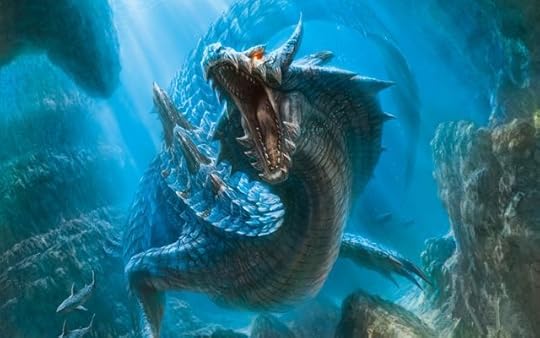 When I relaunched the blog as The Fantasy Scribe, my plan was to focus on mythical creatures. As in made-up, don’t-really-exist, creatures. But to my surprise—and childish delight—there is evidence that the creatures I've researched so far may have been real. Which is so awesome!So today we’re going to look at the Leviathan. The great sea monster described in the Bible. There are many speculations about what the author of Job (a section of the Bible pronounced "jobe") was referring to when he described Leviathan, and we're going to look at four of them today. But first, an excerpt and my favorite part of the passage:Job 41:15-29 “His rows of scales are his pride, shut up tightly as with a seal; one is so near another that no air can come between them; they are joined one to another, they stick together and cannot be parted. His sneezings flash forth light, and his eyes are like the eyelids of the morning. Out of his mouth go burning lights; sparks of fire shoot out. Smoke goes out of his nostrils, as from a boiling pot and burning rushes. His breath kindles coals, and a flame goes out of his mouth.”This passage is so intriguing that it's hard to only share a piece of it. But there are many other exciting facts we'll examine from other parts of the text momentarily. For now just take a look at that bit! This creature spit flame out of his mouth. Which is incredibly cool! (At least, for us humans of today who don't have to encounter such a terrifying thing)Some people have guessed in the past that the Leviathan was a large, prehistoric crocodilian such as Sarcosuchus. Other dinosaur species, including Kronosaurus, Parasaurolophus and Liopleurodon, are considered possibilities. We’ll take a look at the existing fossil evidence of each of these prehistoric beasts and compare that against the descriptions of Leviathan.Sarcosuchus, commonly referred to as the Super Croc, was a monstrous crocodilian whose Latin name means “crocodile skin.” The largest skeleton found yet measures 39.4 ft (12 meters) in length. Judging from the growth plates in many of the bones found, scientists believe that their bodies may have continued to grow indefinitely. A Sarcosuchus skull has an unusual hollow place in the front toward the nose. It is believed that the Sarcosuchus was primarily aquatic (dwelling in water) but could leave the water and move around well on land, like the crocodiles of today.
When I relaunched the blog as The Fantasy Scribe, my plan was to focus on mythical creatures. As in made-up, don’t-really-exist, creatures. But to my surprise—and childish delight—there is evidence that the creatures I've researched so far may have been real. Which is so awesome!So today we’re going to look at the Leviathan. The great sea monster described in the Bible. There are many speculations about what the author of Job (a section of the Bible pronounced "jobe") was referring to when he described Leviathan, and we're going to look at four of them today. But first, an excerpt and my favorite part of the passage:Job 41:15-29 “His rows of scales are his pride, shut up tightly as with a seal; one is so near another that no air can come between them; they are joined one to another, they stick together and cannot be parted. His sneezings flash forth light, and his eyes are like the eyelids of the morning. Out of his mouth go burning lights; sparks of fire shoot out. Smoke goes out of his nostrils, as from a boiling pot and burning rushes. His breath kindles coals, and a flame goes out of his mouth.”This passage is so intriguing that it's hard to only share a piece of it. But there are many other exciting facts we'll examine from other parts of the text momentarily. For now just take a look at that bit! This creature spit flame out of his mouth. Which is incredibly cool! (At least, for us humans of today who don't have to encounter such a terrifying thing)Some people have guessed in the past that the Leviathan was a large, prehistoric crocodilian such as Sarcosuchus. Other dinosaur species, including Kronosaurus, Parasaurolophus and Liopleurodon, are considered possibilities. We’ll take a look at the existing fossil evidence of each of these prehistoric beasts and compare that against the descriptions of Leviathan.Sarcosuchus, commonly referred to as the Super Croc, was a monstrous crocodilian whose Latin name means “crocodile skin.” The largest skeleton found yet measures 39.4 ft (12 meters) in length. Judging from the growth plates in many of the bones found, scientists believe that their bodies may have continued to grow indefinitely. A Sarcosuchus skull has an unusual hollow place in the front toward the nose. It is believed that the Sarcosuchus was primarily aquatic (dwelling in water) but could leave the water and move around well on land, like the crocodiles of today. The first part of a Kronosaurus skeleton ever found was a skull, which was nearly eight feet (2.5 meters) long by itself. As a result, scientists originally guessed the Kronosaurus to be much larger than it actually was. With the discovery of many more skeletons, we now know that it had a disproportionately large head for its body size. It reached a full length including the skull of 33 feet (10 meters). It was named for the leader of the titans, Cronus, and had very large teeth. Evidence suggests that this animal lived deep in the sea and was unlikely to ever willingly leave the water.
The first part of a Kronosaurus skeleton ever found was a skull, which was nearly eight feet (2.5 meters) long by itself. As a result, scientists originally guessed the Kronosaurus to be much larger than it actually was. With the discovery of many more skeletons, we now know that it had a disproportionately large head for its body size. It reached a full length including the skull of 33 feet (10 meters). It was named for the leader of the titans, Cronus, and had very large teeth. Evidence suggests that this animal lived deep in the sea and was unlikely to ever willingly leave the water. The Parasaurolophus reached lengths of about 31 ft (9.5 meters) and stood about 16 feet high. Like the Sarcosuchus, it has extra hollow places in its skull. Unusual nasal passages connect to the hollow place inside the crest. There are many theories on what these were for, including storage of air during time spent under water, use as a snorkeling device for the same circumstances, and vocalization. But what if it was for something a little more interesting? Like, say, breathing fire? The Parasaurolophus is our only candidate whose skeleton indicates it was able to stand on two legs as well as all four. Scientists are unsure whether it was primarily terrestrial (dwelling on land) or aquatic. Its skeleton suggests that it was likely terrestrial, but along with the theories for the purpose of its hollow crest, there is the possibility that it was somewhat aquatic as well.
The Parasaurolophus reached lengths of about 31 ft (9.5 meters) and stood about 16 feet high. Like the Sarcosuchus, it has extra hollow places in its skull. Unusual nasal passages connect to the hollow place inside the crest. There are many theories on what these were for, including storage of air during time spent under water, use as a snorkeling device for the same circumstances, and vocalization. But what if it was for something a little more interesting? Like, say, breathing fire? The Parasaurolophus is our only candidate whose skeleton indicates it was able to stand on two legs as well as all four. Scientists are unsure whether it was primarily terrestrial (dwelling on land) or aquatic. Its skeleton suggests that it was likely terrestrial, but along with the theories for the purpose of its hollow crest, there is the possibility that it was somewhat aquatic as well.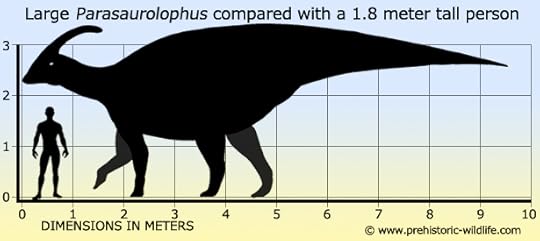 Liopleurodon's length is reported quite differently among different sources. One source says they reached lengths of up to 65 feet (20 meters) while others, such as the one this picture came from, suggest that they are only known to have reached around 23 feet (7 meters). Evidence shows that this creature was most likely exclusively aquatic and seems to have preferred deep parts of the ocean.
Liopleurodon's length is reported quite differently among different sources. One source says they reached lengths of up to 65 feet (20 meters) while others, such as the one this picture came from, suggest that they are only known to have reached around 23 feet (7 meters). Evidence shows that this creature was most likely exclusively aquatic and seems to have preferred deep parts of the ocean. So lets see how each of these four prehistoric species holds up under the specifications of the Biblical description of Leviathan.1. Size and FerocityFirst, we're told several times throughout the passage that Leviathan cannot be captured. He cannot be kept as a pet or killed to be eaten. The passage in Job says, “Indeed, any hope of overcoming him is false…. No one is so fierce that he would dare stir him up…. When he raises himself up, the mighty are afraid; because of his crashings they are beside themselves.”This passage also says that if anyone tries to catch him, they will never try again. From these descriptions, we know that Leviathan was quite fierce, and probably very large. That could apply to each of the dinosaur possibilities. The best candidate for “rising up” would be the Parasaurolophus. Its skeleton indicates that it was likely able to stand up and walk on its back legs just as well as on all fours. Our Kronosaurus and Liopleurodon were very large and had epic teeth, but if “rise up” means “get taller and stare people down,” well, it is highly unlikely that their skeletons would allow for that. And both of these guys were pliosaurs with very short necks, not plesiosaurs with the Loch Ness Monster look. As for Sarcosuchus, he was shaped quite similarly to the crocodile of today and was unlikely to be able to rise up to just his back legs alone. But he could probably have pushed himself up a little higher by extending his legs all the way from the usual bent resting position pictured above that we see frequently in crocodiles. Parasaurolophus: one, everybody else: zero.2. Impenetrable skinSecondly, Leviathan had crazy strong skin. "His rows of scales are his pride, shut up tightly as with a seal; one is so near another that no air can come between them; they are joined one to another, they stick together and cannot be parted…. Though the sword reaches him, it cannot avail, nor does spear, dart, or javelin. He regards iron as straw, and bronze as rotten wood. The arrow cannot make him flee, sling stones become like stubble to him. Darts are regarded as straw, he laughs at the threat of javelins.”The skin or scales described here are presumed to be osteoderms, which are bony plates within the skin. Modern day crocodiles, and some other reptile species, have these osteoderms in their skin. Can you see how having a coat of bone could make the threat of javelins less than concerning to our dragon friend?
So lets see how each of these four prehistoric species holds up under the specifications of the Biblical description of Leviathan.1. Size and FerocityFirst, we're told several times throughout the passage that Leviathan cannot be captured. He cannot be kept as a pet or killed to be eaten. The passage in Job says, “Indeed, any hope of overcoming him is false…. No one is so fierce that he would dare stir him up…. When he raises himself up, the mighty are afraid; because of his crashings they are beside themselves.”This passage also says that if anyone tries to catch him, they will never try again. From these descriptions, we know that Leviathan was quite fierce, and probably very large. That could apply to each of the dinosaur possibilities. The best candidate for “rising up” would be the Parasaurolophus. Its skeleton indicates that it was likely able to stand up and walk on its back legs just as well as on all fours. Our Kronosaurus and Liopleurodon were very large and had epic teeth, but if “rise up” means “get taller and stare people down,” well, it is highly unlikely that their skeletons would allow for that. And both of these guys were pliosaurs with very short necks, not plesiosaurs with the Loch Ness Monster look. As for Sarcosuchus, he was shaped quite similarly to the crocodile of today and was unlikely to be able to rise up to just his back legs alone. But he could probably have pushed himself up a little higher by extending his legs all the way from the usual bent resting position pictured above that we see frequently in crocodiles. Parasaurolophus: one, everybody else: zero.2. Impenetrable skinSecondly, Leviathan had crazy strong skin. "His rows of scales are his pride, shut up tightly as with a seal; one is so near another that no air can come between them; they are joined one to another, they stick together and cannot be parted…. Though the sword reaches him, it cannot avail, nor does spear, dart, or javelin. He regards iron as straw, and bronze as rotten wood. The arrow cannot make him flee, sling stones become like stubble to him. Darts are regarded as straw, he laughs at the threat of javelins.”The skin or scales described here are presumed to be osteoderms, which are bony plates within the skin. Modern day crocodiles, and some other reptile species, have these osteoderms in their skin. Can you see how having a coat of bone could make the threat of javelins less than concerning to our dragon friend?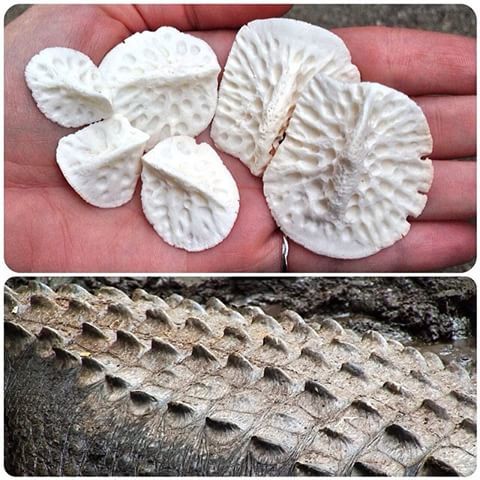 Parasaurolophus, however, apparently did not have this skin feature. According to the Department of Biological Sciences, University of Alberta, “Among dinosaurs, skin impressions are commonly associated with partial and complete hadrosaurid skeletons, and consist of non-imbricating tubercles or scales.” Non-imbricating means notoverlapping. While the passage doesn’t necessarily say that Leviathan’s scales overlapped, it does say that they were so strongly bound together that air could not pass between them. Based on that phrase, it seems likely that they could have overlapped, or at least been bound so closely together that they could not get any closer. From these skin impressions, we can see that Parasaurolophus had textured skin, but nothing as strong as osteoderms. If osteoderms would have been present, they would be even more well-preserved than the skin impressions. One strike against Parasaurolophus.
Parasaurolophus, however, apparently did not have this skin feature. According to the Department of Biological Sciences, University of Alberta, “Among dinosaurs, skin impressions are commonly associated with partial and complete hadrosaurid skeletons, and consist of non-imbricating tubercles or scales.” Non-imbricating means notoverlapping. While the passage doesn’t necessarily say that Leviathan’s scales overlapped, it does say that they were so strongly bound together that air could not pass between them. Based on that phrase, it seems likely that they could have overlapped, or at least been bound so closely together that they could not get any closer. From these skin impressions, we can see that Parasaurolophus had textured skin, but nothing as strong as osteoderms. If osteoderms would have been present, they would be even more well-preserved than the skin impressions. One strike against Parasaurolophus.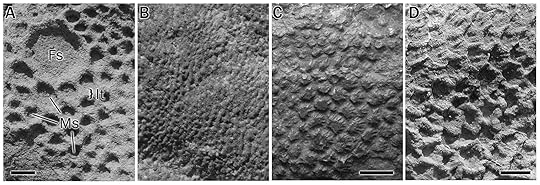 We don’t have sufficient evidence to make a guess at the type of skin that Kronosaurus and Liopleurodon had. But it seems likely that if they had osteoderms, we would have found them with at least some of their skeletons by now. If their skeletal bones survived, and the osteoderms of other species survived, why wouldn’t the osteoderms of these individuals still be around as well, if they'd been present to begin with?As for Sarcosuchus, osteoderms have been found with its skeletons. The very first pieces of a Sarcosuchus skeleton ever found were a skull and osteoderms. According to Dr. Paul Sereno, Paleontologist and discoverer of the most complete Sarcosuchus skeleton found to date, “The osteoderms formed a continuous surface from the anterior cervical vertebrae to the middle of the tail.”
We don’t have sufficient evidence to make a guess at the type of skin that Kronosaurus and Liopleurodon had. But it seems likely that if they had osteoderms, we would have found them with at least some of their skeletons by now. If their skeletal bones survived, and the osteoderms of other species survived, why wouldn’t the osteoderms of these individuals still be around as well, if they'd been present to begin with?As for Sarcosuchus, osteoderms have been found with its skeletons. The very first pieces of a Sarcosuchus skeleton ever found were a skull and osteoderms. According to Dr. Paul Sereno, Paleontologist and discoverer of the most complete Sarcosuchus skeleton found to date, “The osteoderms formed a continuous surface from the anterior cervical vertebrae to the middle of the tail.”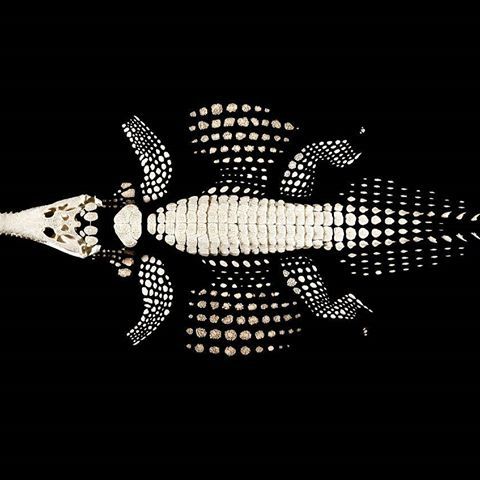 So Sarcosuchus is the winner the the most impenetrable skin award. With these osteoderms, he was likely the most difficult to get a weapon through. Plus, there is one verse in Job that says “His undersides are like sharp potsherds, he spreads pointed marks in the mire,” which indicates that he had some kind of protruding scales on his undersides. And he must have been anatomically able to drag his belly through the mud, possibly because he had short, squat legs like a crocodilian.Remember our present-day crocodilian osteoderms from above? Here is a fossilized Sarcosuchus osteoderm. Look at the size of that! I doubt even Duane Johnson could throw a javelin through skin made of those things. What do you think?
So Sarcosuchus is the winner the the most impenetrable skin award. With these osteoderms, he was likely the most difficult to get a weapon through. Plus, there is one verse in Job that says “His undersides are like sharp potsherds, he spreads pointed marks in the mire,” which indicates that he had some kind of protruding scales on his undersides. And he must have been anatomically able to drag his belly through the mud, possibly because he had short, squat legs like a crocodilian.Remember our present-day crocodilian osteoderms from above? Here is a fossilized Sarcosuchus osteoderm. Look at the size of that! I doubt even Duane Johnson could throw a javelin through skin made of those things. What do you think?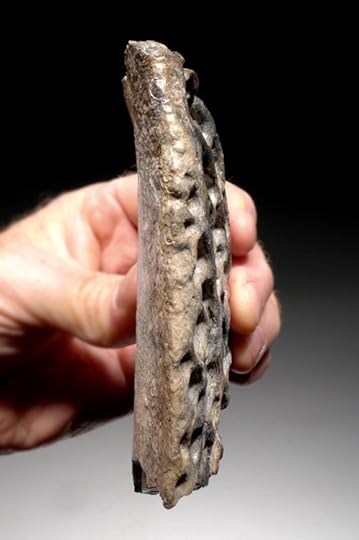 3. Strength and TeethThirdly, his strength was revered, and he had fearsome teeth. “Who can open the doors of his face, with his terrible teeth all around?....Strength dwells in his neck, and sorrow dances before him. The folds of his flesh are joined together, they are firm on him and cannot be moved. His heart is as hard as stone, even as hard as the lower millstone.”Each of our contestants has a fairly short neck that was likely quite muscular. So lets focus on teeth here. Kronosaurus, Sarcosuchus, and Liopleurodon each have obviously carnivorous teeth.As for Parasaurolophus, take a look at this skull. Tiny mouth. No scary teeth. This guy was a vegetarian. I’m afraid this fact disqualifies Parasaurolophus from Leviathan candidacy. No terrible teeth, no Leviathan.
3. Strength and TeethThirdly, his strength was revered, and he had fearsome teeth. “Who can open the doors of his face, with his terrible teeth all around?....Strength dwells in his neck, and sorrow dances before him. The folds of his flesh are joined together, they are firm on him and cannot be moved. His heart is as hard as stone, even as hard as the lower millstone.”Each of our contestants has a fairly short neck that was likely quite muscular. So lets focus on teeth here. Kronosaurus, Sarcosuchus, and Liopleurodon each have obviously carnivorous teeth.As for Parasaurolophus, take a look at this skull. Tiny mouth. No scary teeth. This guy was a vegetarian. I’m afraid this fact disqualifies Parasaurolophus from Leviathan candidacy. No terrible teeth, no Leviathan.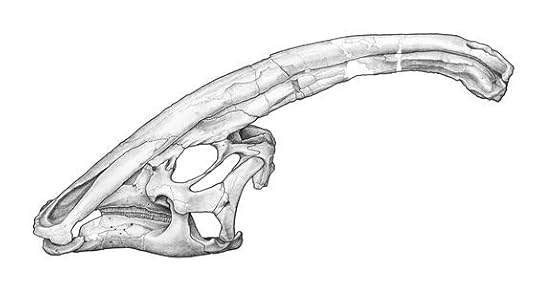 Something interesting to note about modern day crocodilians is that while they have incredible bite force, they aren’t so great at opening their mouths. In fact, while a large enough specimen could bite a human in half, the same individual’s jaws can be safely shut with a rubber band or duct tape. And people are advised not to bother trying to get the mouth open if ever attacked by one of these, but to go for the eyes or nose because of how impossible it is to pull the jaws apart.We don’t know if the same may have been true for Kronosaurus and Liopleurodon, and while it is possible, considering the significant similarities between Sarcosuchus and today’s crocodile, this is probably another point for our Super Croc. "Opening the doors of his face" would be quite a challenge.4. Fiery BreathHere’s the best part for us fantasy animal lovers. This dragon breathed fire! Yes! “His sneezings flash forth light, and his eyes are like the eyelids of the morning. Out of his mouth go burning lights, sparks of fire shoot out. Smoke goes out of his nostrils, as from a boiling pot and burning rushes. His breath kindles coals, and a flame goes out of his mouth.”So here is where Sarcosuchus really outshines everybody else, at least in theory. He has a giant hollow place in his nose. A place where chemicals could have been stored or mixed to produce flame when forced out. Woot!
Something interesting to note about modern day crocodilians is that while they have incredible bite force, they aren’t so great at opening their mouths. In fact, while a large enough specimen could bite a human in half, the same individual’s jaws can be safely shut with a rubber band or duct tape. And people are advised not to bother trying to get the mouth open if ever attacked by one of these, but to go for the eyes or nose because of how impossible it is to pull the jaws apart.We don’t know if the same may have been true for Kronosaurus and Liopleurodon, and while it is possible, considering the significant similarities between Sarcosuchus and today’s crocodile, this is probably another point for our Super Croc. "Opening the doors of his face" would be quite a challenge.4. Fiery BreathHere’s the best part for us fantasy animal lovers. This dragon breathed fire! Yes! “His sneezings flash forth light, and his eyes are like the eyelids of the morning. Out of his mouth go burning lights, sparks of fire shoot out. Smoke goes out of his nostrils, as from a boiling pot and burning rushes. His breath kindles coals, and a flame goes out of his mouth.”So here is where Sarcosuchus really outshines everybody else, at least in theory. He has a giant hollow place in his nose. A place where chemicals could have been stored or mixed to produce flame when forced out. Woot!  Parasaurolophus has an unexplained hollow place in his skull as well, coordinating with his hollow crest. It is an interesting idea that this feature could have been used for the same purpose. While Parasaurolophus falls short of being our Leviathan, he may still have been a fire-breathing vegetarian.
Parasaurolophus has an unexplained hollow place in his skull as well, coordinating with his hollow crest. It is an interesting idea that this feature could have been used for the same purpose. While Parasaurolophus falls short of being our Leviathan, he may still have been a fire-breathing vegetarian. 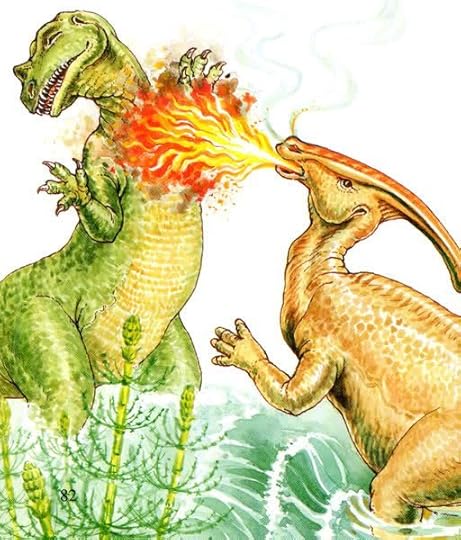 So what if Sarcosuchus did have the ability to do some kind of fire-breathing thing with this specialized anatomy? How might he have done it?Unfortunately, I’ve struggled to find anything remotely like this in any currently living species. Let’s look at what I was able to scrape up:Venomous snakes keep their venom in a specialized gland behind each eye. On each side, the gland is connected by a duct to the fang, and there is a sizable muscle behind the gland that pushes the venom out of the gland, through the duct, through the vein and into a prey item’s body. This venom obviously does not explode out in flame, but the venom of most species is extremely painful and can feel like burning.However, due to his extreme size, it isn't likely Sarcosuchus needed venom to help subdue his prey.Perhaps slightly more applicable is the Bombardier beetle’s defense mechanism. According to the Smithsonian, “The beetles have a special chamber in their abdomens where they mix together chemicals to produce an explosive reaction.”National Geographic explains in more detail: “The beetle mixes its chemical weapons within glands in its abdomen, each of which consist of two chambers. The reservoir chamber contains a solution of hydrogen peroxide and hydroquinones—that’s the fuel, inert on its own but always on the cusp of extreme violence. The adjacent reaction chamber contains enzymes like peroxidise and catalase—that’s the match. The beetle then blasts its would-be predator with a chemical mixture that can reach up to 22 miles per hour at 100 degrees Celsius (212 degrees Fahrenheit).” If such glands could exist inside a tiny insect to do such damage, imagine what Sarcosuchus-sized glands could do! Unfortunately, there is no way to know for sure if this chamber was used in such a way. But it is a fascinating possibility. 5. Water and Land“His undersides are like sharp potsherds, he spreads pointed marks in the mire. He makes the deep boil like a pot; he makes the sea like a pot of ointment. He leaves a shining wake behind him. One would think the deep had white hair.”Another strike against our already disqualified friend, Parasaurolophus. Anatomically speaking, this guy was most likely terrestrial, and even if it did venture into water, its anatomy does not make it seem likely that he would drag his belly through the mud on his way up or be capable of stirring up the deep to the same extent as our other three contenders. As for Liopleurodon and Kronosaurus, this passage does point to them: However, scientists think it was unlikely that they could get their whole giant selves all the way on land. And why would they? The oceans were huge and held plenty of food. They likely only lived in deep water because of their size and the necessary size of their food items. But even if they did haul out on land, evidence suggests that they were unlikely to have had pointy belly scales that would "leave marks in the mire."That leaves Sarcosuchus. Like other crocodilians, he was very likely a terrestrial and aquatic animal. He is likely to have been able to stir up the deep, to leave gashes in the mud with his ventral osteoderms as he slid into the water, and he had the hollow place for possible fire breathing.So what about rising up? Maybe this is referring to him basking in the mud and then standing to his full height. Even though he was much longer than he was tall, perhaps he was still fairly tall on all fours. And with a face that big, you wouldn’t have to be that tall to be terrifying. Or maybe, he was able to lift himself up on his hind legs to some extent.Analysis of what facts and postulations that we have indicates that Sarcosuchus is the most likely candidate for the Leviathan described in the Bible. While we can’t know for sure, it is possible that an actual fire-breathing dragon really did exist—and who knows? Maybe he’s still out there.What are your thoughts on Leviathan? Do you know something interesting about it that I did't cover? Are you excited about the possibility of a real live fire-breathing dragon? Tell me about it in the comments!In Recent MediaAs for movies, there are two called "Leviathan." One came out in 1989 and the other in 2014. I haven't seen either of them, have you? Are they worth watching?The Leviathan Trilogy, a YA steampunk series by Scott Westerfield, looks like an amazing read. I Haven't read this series yet, but I have read part of his The Uglies series, which is very good. Check out the trailer for The Leviathan Series here. It's average rating on goodreads is 3.91/5 stars.Leviathan Wakes is the first book in The Expanse, a SciFi series by James S. A. Corey. It is unclear whether "Leviathan" here is used to refer to a creature or just something that is big, such as a spaceship. It was published in 2011 and was turned into a TV show in 2016. Seems like it is likely worth a read and or watch as it has 4.2/5 stars on goodreads and 8.8/10 stars on IMDB. Do you know of another place where Leviathan has made it in the media? Please share in the comments!Creative CornerAre you thinking of using Leviathan in your own story?Would you portray Leviathan as a monster, or someone who could be befriended? Would the story take place in a world full of Leviathans, whether good or bad, where a human get lost and stumbles upon them? Or would it be a world full of humans where the last Leviathan that exists in the world is encountered?If there were only one Leviathan left alive in the world, what if some mad scientists wanted to clone it? Would the protagonist be an intern anxious to prove himself against the beast, or someone seeking to free his friend from their experiments?Would your Leviathan(s) look like Sarcosuchus, or something else?I am always fascinated by sentient animals, so I can't help leaning toward Leviathan being a good guy just as intelligent as a human. Either saving his human friend from the end of the world, or being saved by his human friend from something else. So many interesting things could happen!Do you have ideas you'd like to share? Tell me about them in the comments!Would you like to be the first to receive the next scoop on a fantastic creature? Subscribe below and get your free Elements of Fantasy Guide!
So what if Sarcosuchus did have the ability to do some kind of fire-breathing thing with this specialized anatomy? How might he have done it?Unfortunately, I’ve struggled to find anything remotely like this in any currently living species. Let’s look at what I was able to scrape up:Venomous snakes keep their venom in a specialized gland behind each eye. On each side, the gland is connected by a duct to the fang, and there is a sizable muscle behind the gland that pushes the venom out of the gland, through the duct, through the vein and into a prey item’s body. This venom obviously does not explode out in flame, but the venom of most species is extremely painful and can feel like burning.However, due to his extreme size, it isn't likely Sarcosuchus needed venom to help subdue his prey.Perhaps slightly more applicable is the Bombardier beetle’s defense mechanism. According to the Smithsonian, “The beetles have a special chamber in their abdomens where they mix together chemicals to produce an explosive reaction.”National Geographic explains in more detail: “The beetle mixes its chemical weapons within glands in its abdomen, each of which consist of two chambers. The reservoir chamber contains a solution of hydrogen peroxide and hydroquinones—that’s the fuel, inert on its own but always on the cusp of extreme violence. The adjacent reaction chamber contains enzymes like peroxidise and catalase—that’s the match. The beetle then blasts its would-be predator with a chemical mixture that can reach up to 22 miles per hour at 100 degrees Celsius (212 degrees Fahrenheit).” If such glands could exist inside a tiny insect to do such damage, imagine what Sarcosuchus-sized glands could do! Unfortunately, there is no way to know for sure if this chamber was used in such a way. But it is a fascinating possibility. 5. Water and Land“His undersides are like sharp potsherds, he spreads pointed marks in the mire. He makes the deep boil like a pot; he makes the sea like a pot of ointment. He leaves a shining wake behind him. One would think the deep had white hair.”Another strike against our already disqualified friend, Parasaurolophus. Anatomically speaking, this guy was most likely terrestrial, and even if it did venture into water, its anatomy does not make it seem likely that he would drag his belly through the mud on his way up or be capable of stirring up the deep to the same extent as our other three contenders. As for Liopleurodon and Kronosaurus, this passage does point to them: However, scientists think it was unlikely that they could get their whole giant selves all the way on land. And why would they? The oceans were huge and held plenty of food. They likely only lived in deep water because of their size and the necessary size of their food items. But even if they did haul out on land, evidence suggests that they were unlikely to have had pointy belly scales that would "leave marks in the mire."That leaves Sarcosuchus. Like other crocodilians, he was very likely a terrestrial and aquatic animal. He is likely to have been able to stir up the deep, to leave gashes in the mud with his ventral osteoderms as he slid into the water, and he had the hollow place for possible fire breathing.So what about rising up? Maybe this is referring to him basking in the mud and then standing to his full height. Even though he was much longer than he was tall, perhaps he was still fairly tall on all fours. And with a face that big, you wouldn’t have to be that tall to be terrifying. Or maybe, he was able to lift himself up on his hind legs to some extent.Analysis of what facts and postulations that we have indicates that Sarcosuchus is the most likely candidate for the Leviathan described in the Bible. While we can’t know for sure, it is possible that an actual fire-breathing dragon really did exist—and who knows? Maybe he’s still out there.What are your thoughts on Leviathan? Do you know something interesting about it that I did't cover? Are you excited about the possibility of a real live fire-breathing dragon? Tell me about it in the comments!In Recent MediaAs for movies, there are two called "Leviathan." One came out in 1989 and the other in 2014. I haven't seen either of them, have you? Are they worth watching?The Leviathan Trilogy, a YA steampunk series by Scott Westerfield, looks like an amazing read. I Haven't read this series yet, but I have read part of his The Uglies series, which is very good. Check out the trailer for The Leviathan Series here. It's average rating on goodreads is 3.91/5 stars.Leviathan Wakes is the first book in The Expanse, a SciFi series by James S. A. Corey. It is unclear whether "Leviathan" here is used to refer to a creature or just something that is big, such as a spaceship. It was published in 2011 and was turned into a TV show in 2016. Seems like it is likely worth a read and or watch as it has 4.2/5 stars on goodreads and 8.8/10 stars on IMDB. Do you know of another place where Leviathan has made it in the media? Please share in the comments!Creative CornerAre you thinking of using Leviathan in your own story?Would you portray Leviathan as a monster, or someone who could be befriended? Would the story take place in a world full of Leviathans, whether good or bad, where a human get lost and stumbles upon them? Or would it be a world full of humans where the last Leviathan that exists in the world is encountered?If there were only one Leviathan left alive in the world, what if some mad scientists wanted to clone it? Would the protagonist be an intern anxious to prove himself against the beast, or someone seeking to free his friend from their experiments?Would your Leviathan(s) look like Sarcosuchus, or something else?I am always fascinated by sentient animals, so I can't help leaning toward Leviathan being a good guy just as intelligent as a human. Either saving his human friend from the end of the world, or being saved by his human friend from something else. So many interesting things could happen!Do you have ideas you'd like to share? Tell me about them in the comments!Would you like to be the first to receive the next scoop on a fantastic creature? Subscribe below and get your free Elements of Fantasy Guide!
Published on January 16, 2018 03:29



